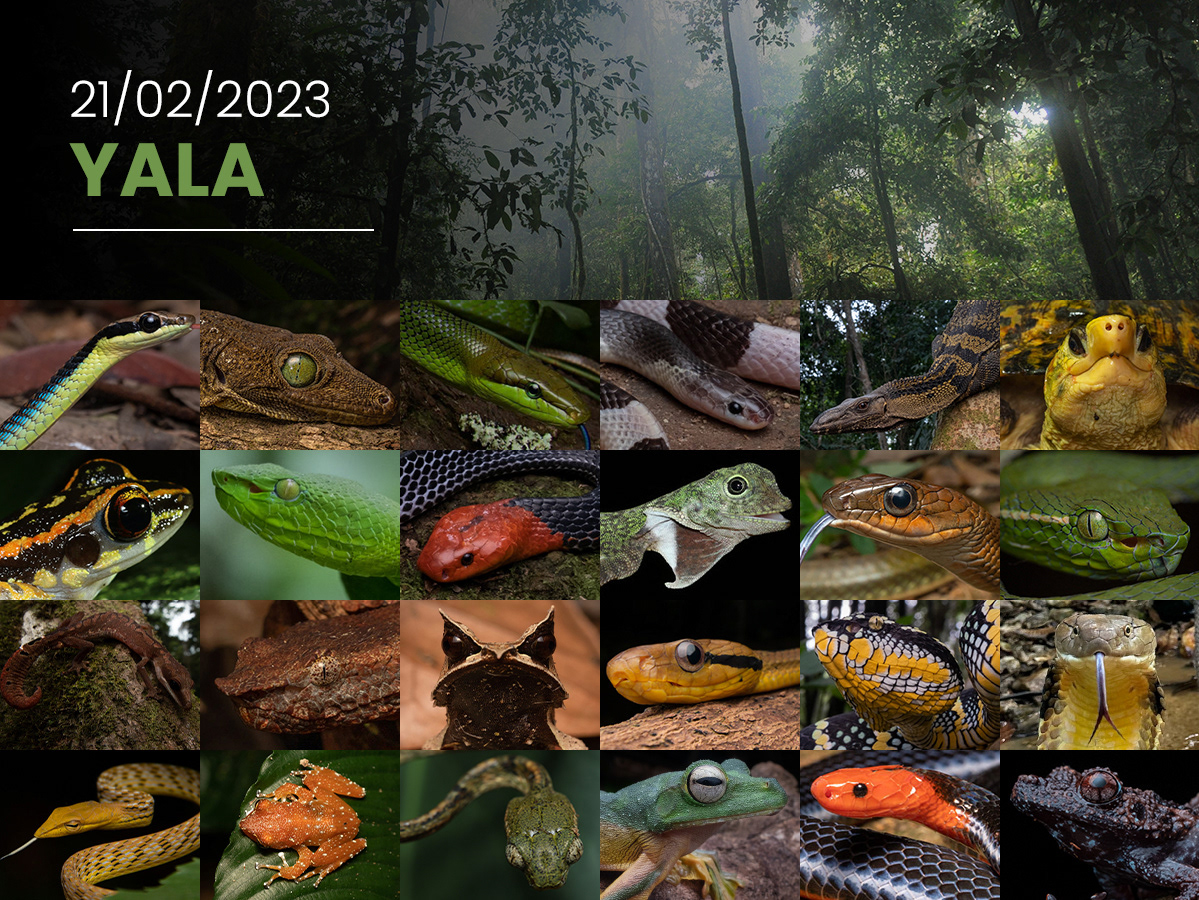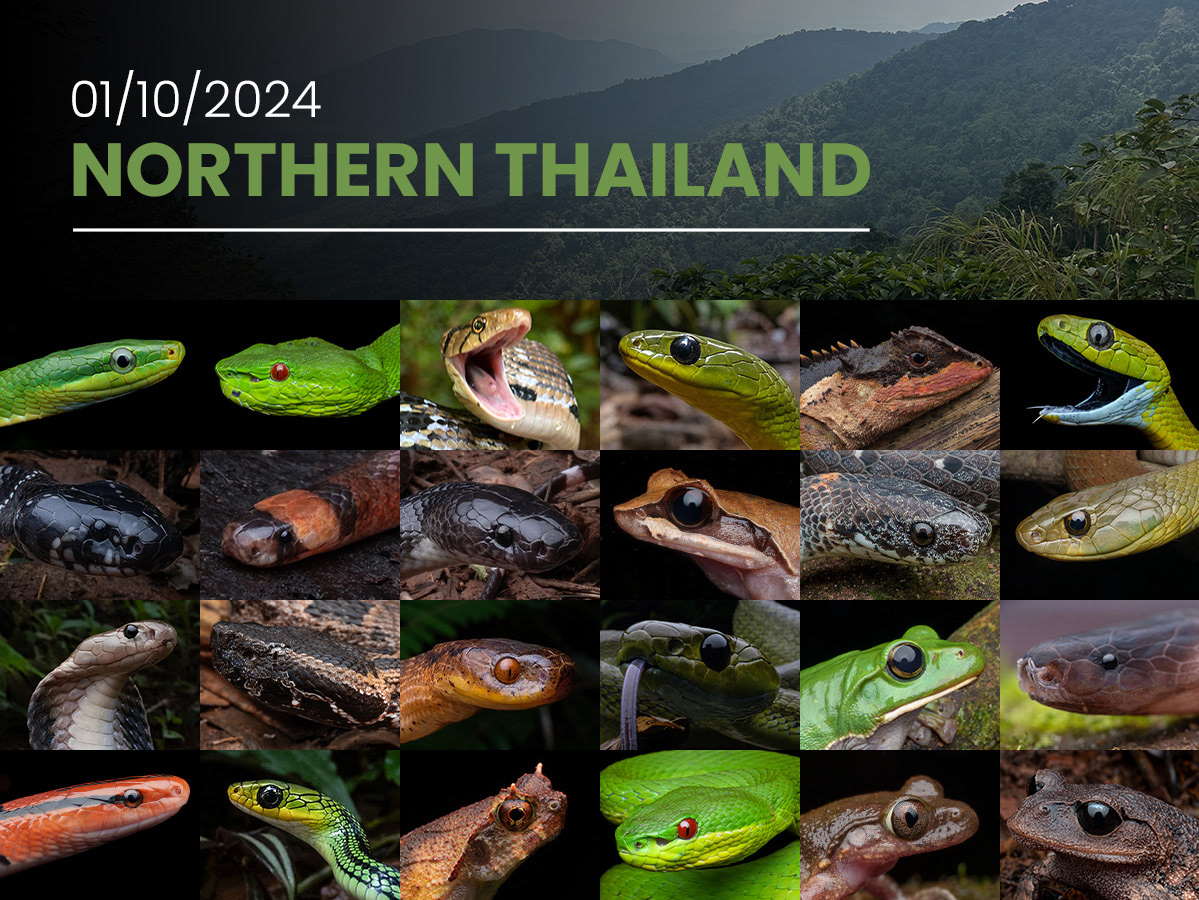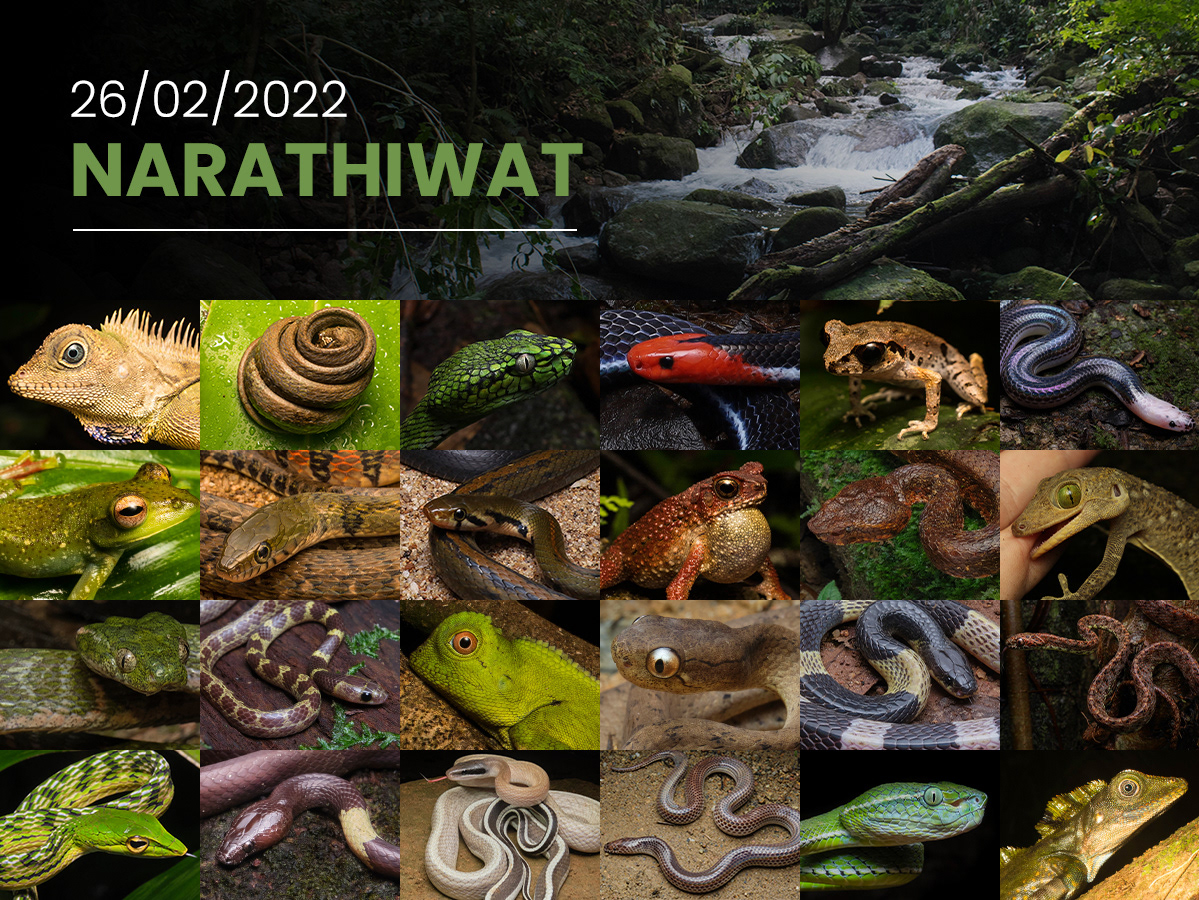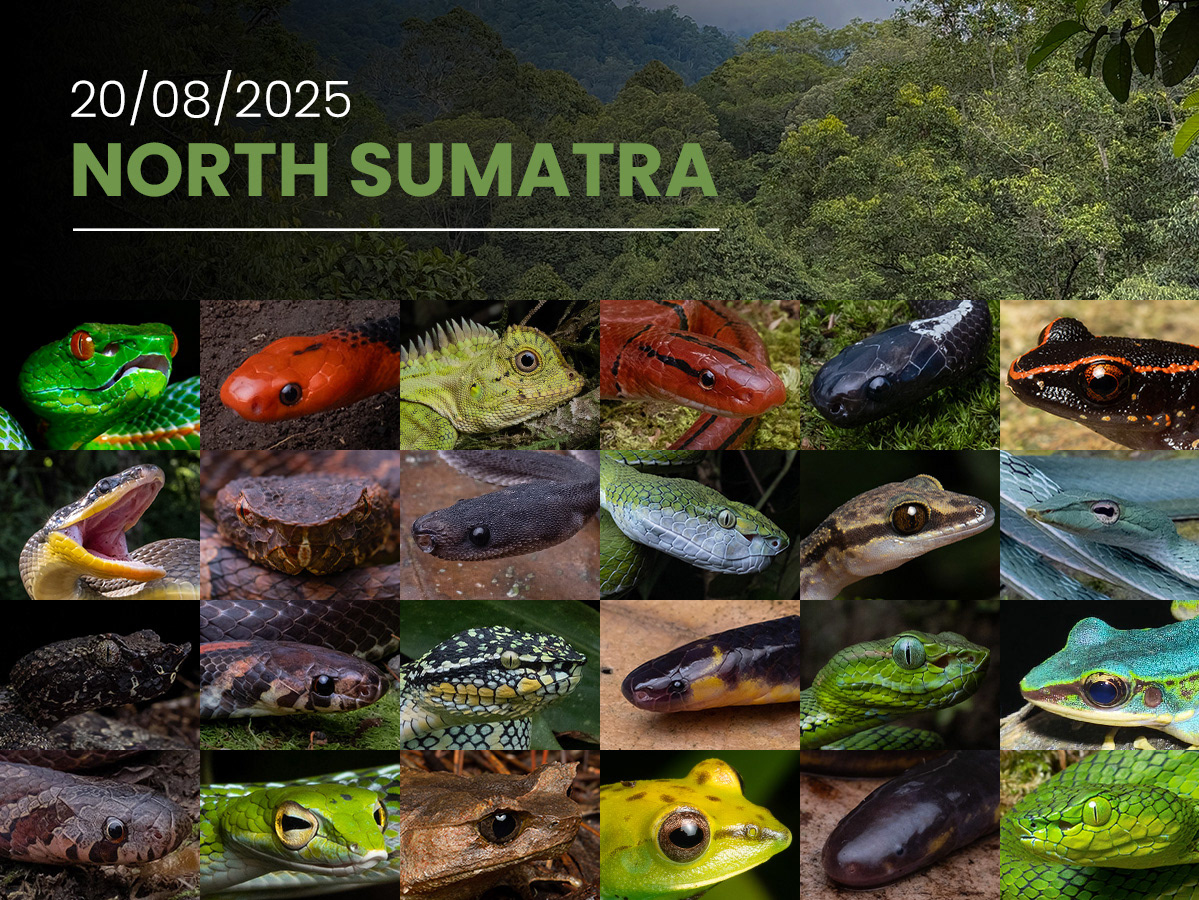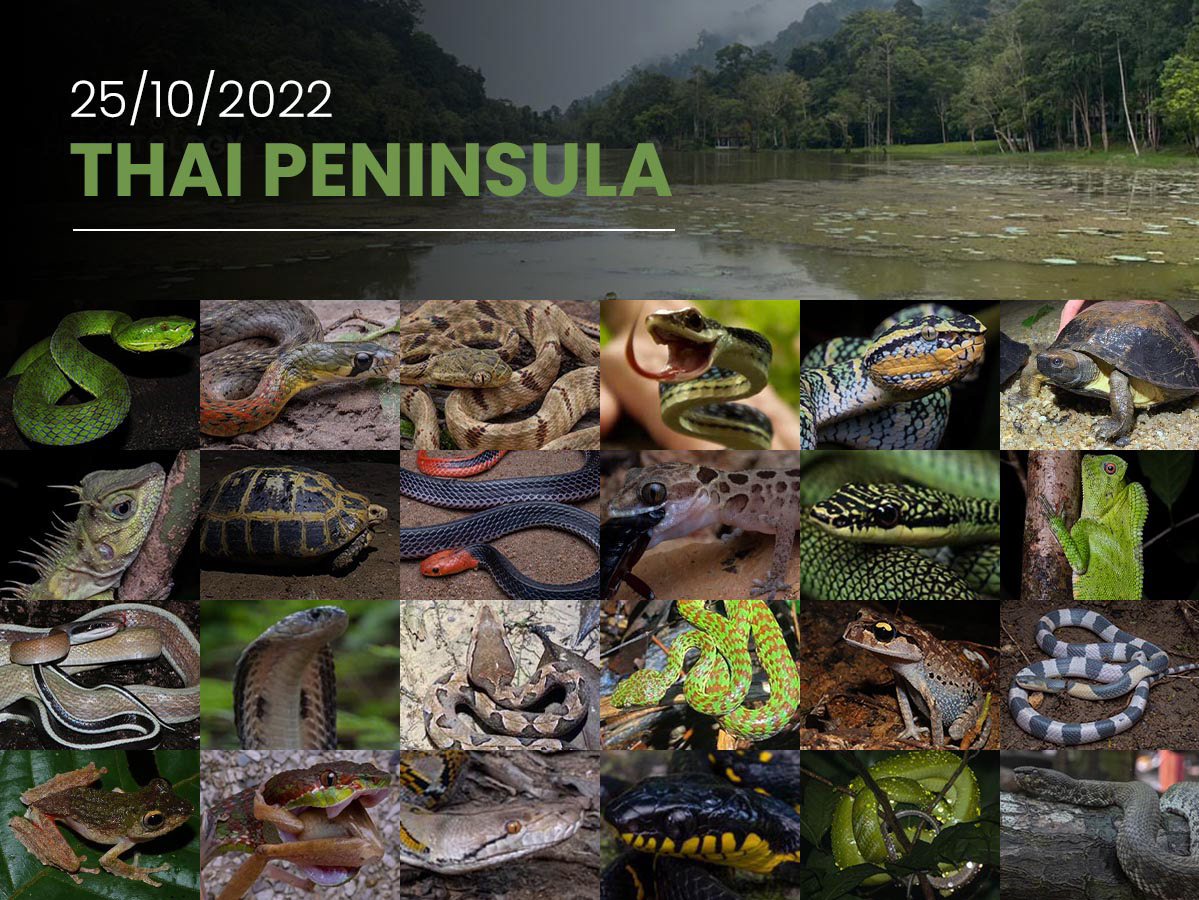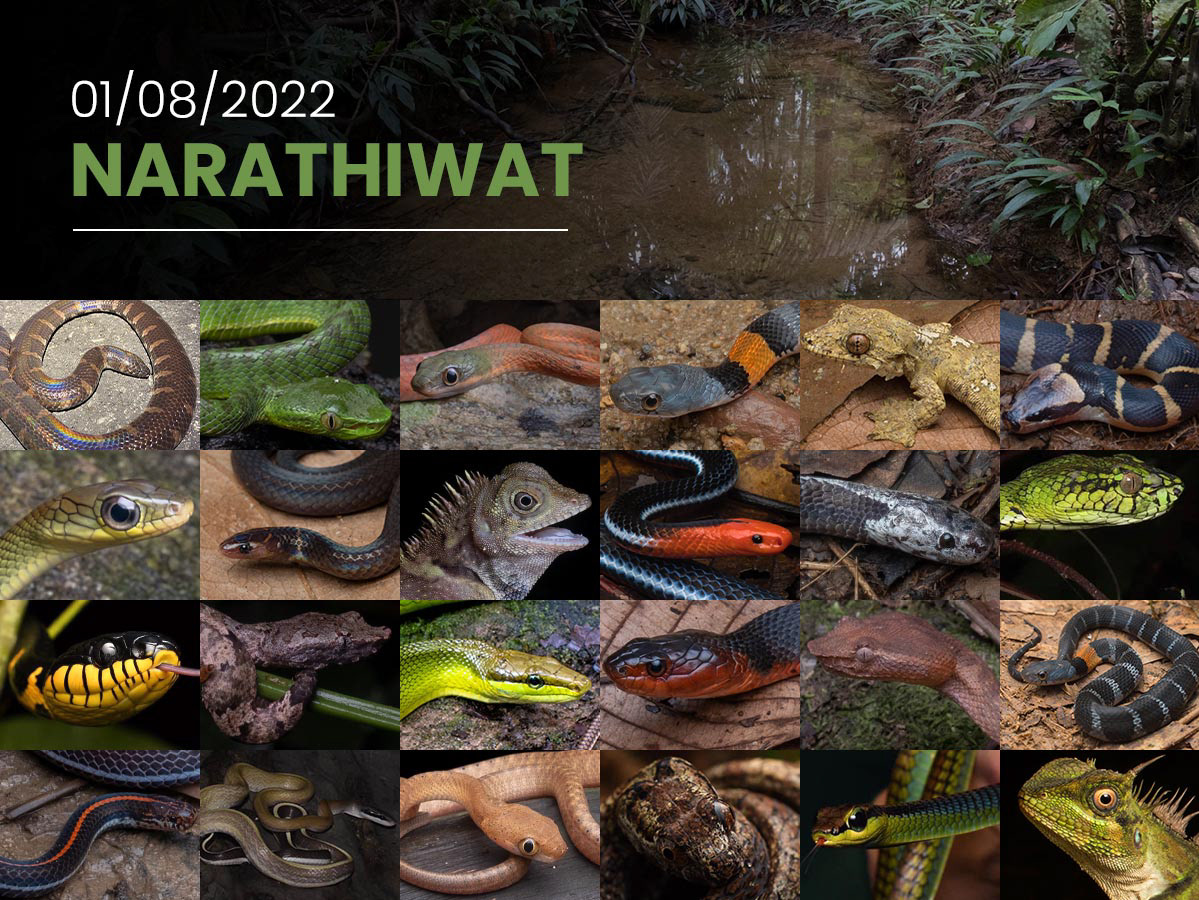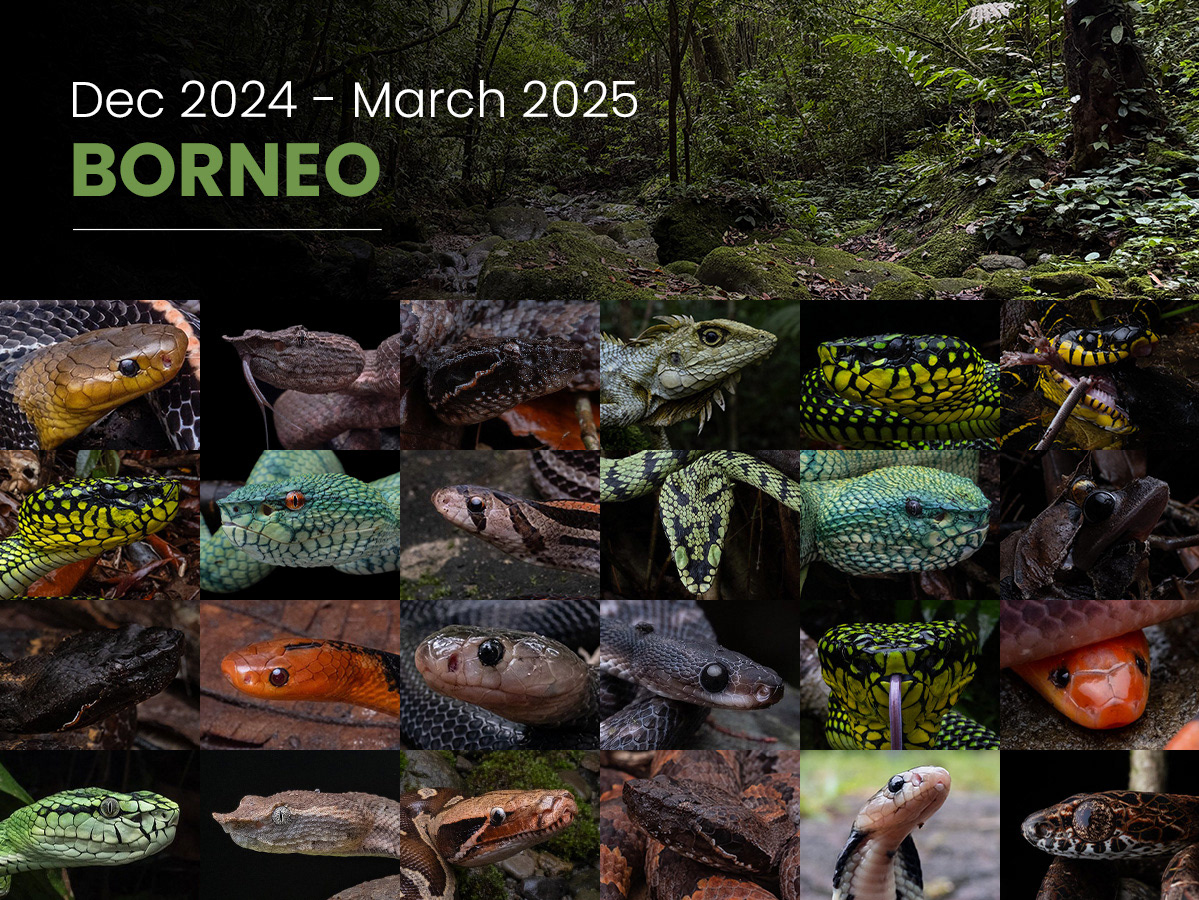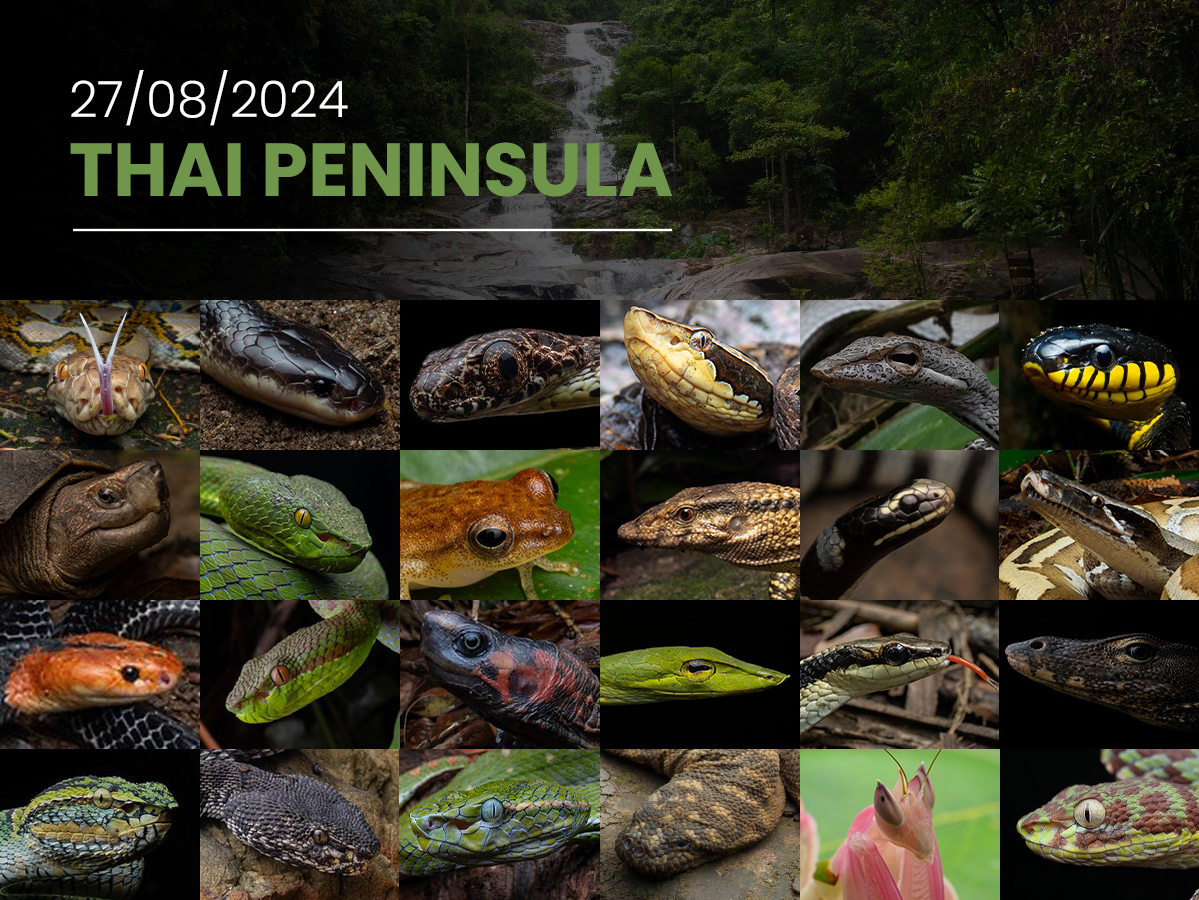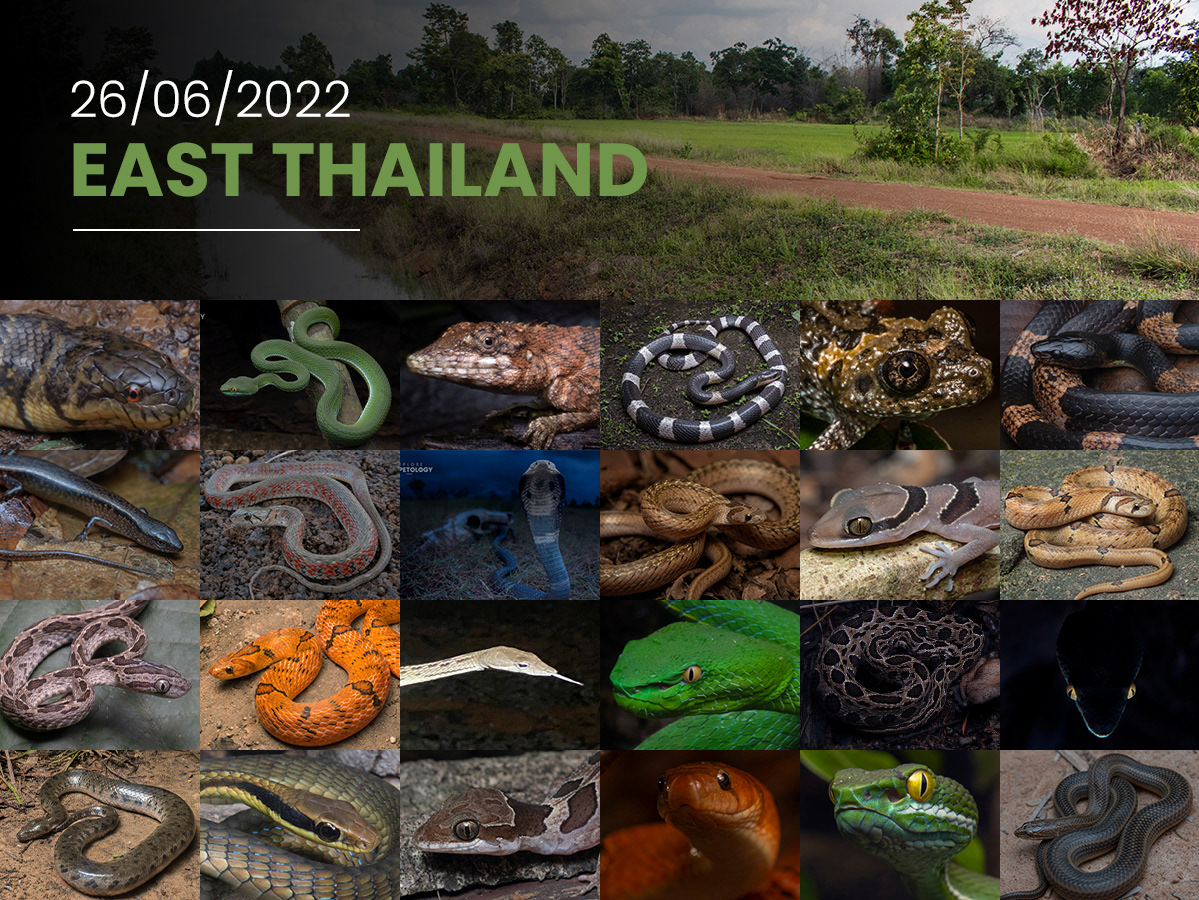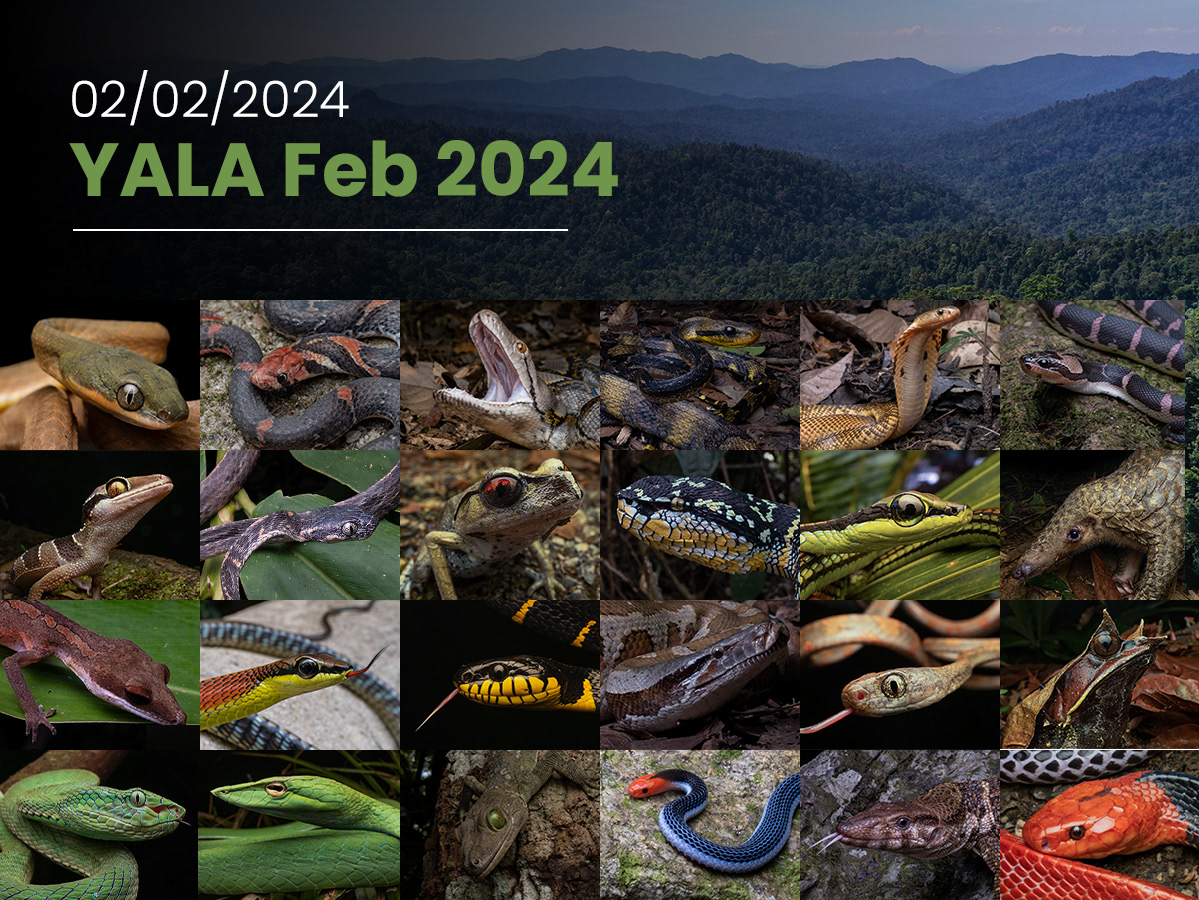Introduction
After more than a year since the inception of this trip, Explore Herpetology director Rupert Grassby-Lewis (the author) and two fellow naturalists, Keith Weller and Alex Lee, embarked on an intense 6 night herping expedition trip to The Philippines. We had been to The Philippines for a weeklong herping trip the previous year, but only to Batanes and Palawan islands - successfully targeting the viper species endemic to those areas. This trip was also viper-focused, with the aim of seeing the remaining species to complete all taxonomically recognised vipers in The Philippines, as well as a special addition we will discuss later.
Luzon
The trip began with a 1 night layover in Manila, whereby our group took the opportunity to get out into the forest and check off the Philippines pit viper (Trimeresurus flavomaculatus). This species is widely distributed across Luzon island, but populations are fragmented and densities are highly variable. Fortunately, Keith had recently discovered a stream valley with a strong population, giving us a great chance of seeing multiple individuals within our extremely limited time.
El Nino was hitting The Philippines hard as we got closer to summer, and the team arrived in Manila to an oppressive heatwave with temperatures exceeding 40 degrees Celsius, and not dropping below 30c at night. However, hot weather does not suppress snake activity in South-East Asia, especially around water sources, and the first night was very successful.
The team found more than 10 Philippine vine snakes (Ahaetulla prasina preocularis), mostly green individuals but also one brownish-yellow morph, and 5 Philippine pit vipers (Trimeresurus flavomaculatus). Most were photographed in-situ (as found), while a juvenile and adult male individual were handled for better photos. We certainly could have found more snakes, but brutal conditions for hiking and a looming 6.30am wakeup for a flight the following day pushed us back to the hotel at a reasonable hour.
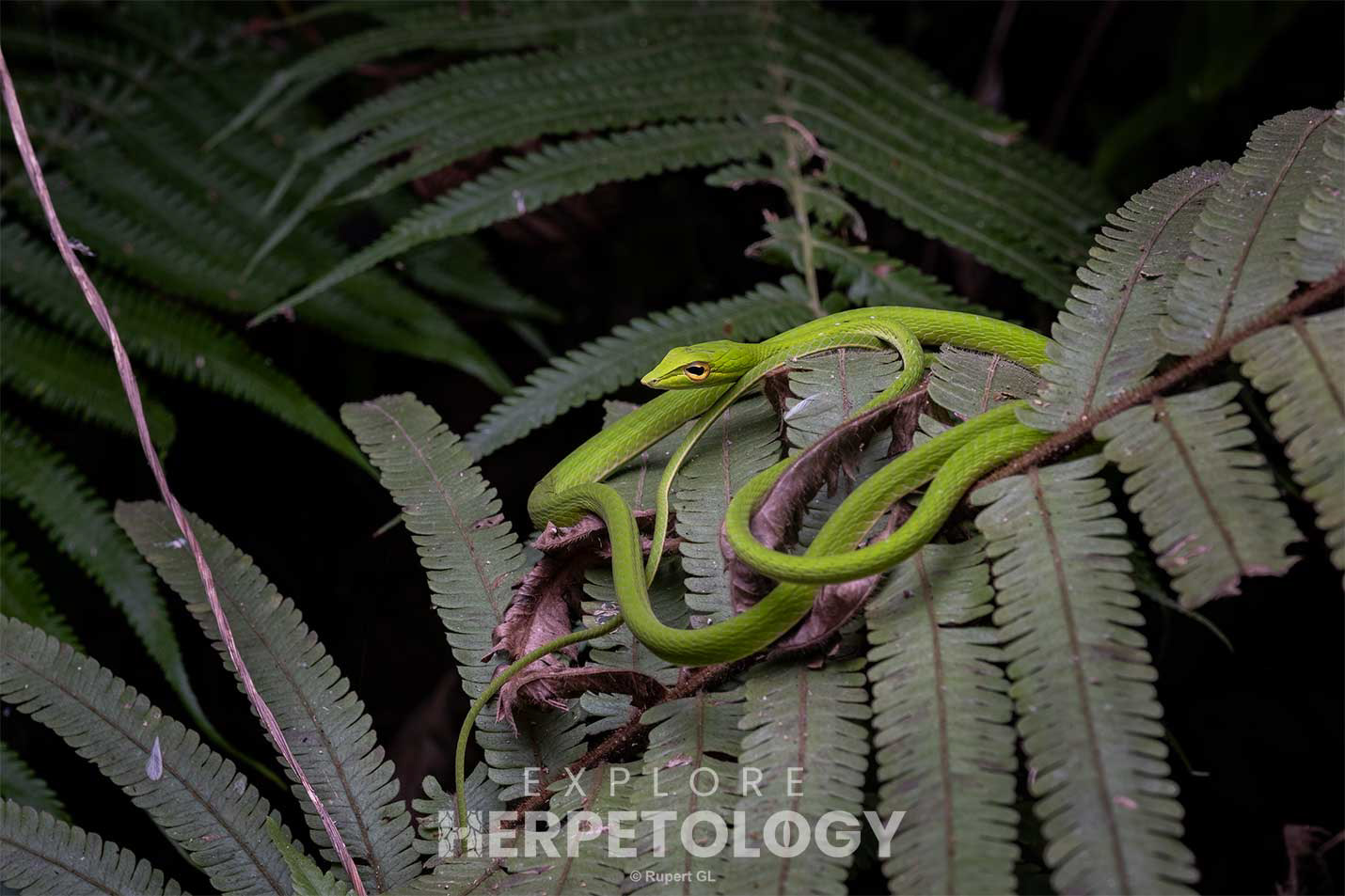
Philippine vine snake (Ahaetulla prasina preocularis)
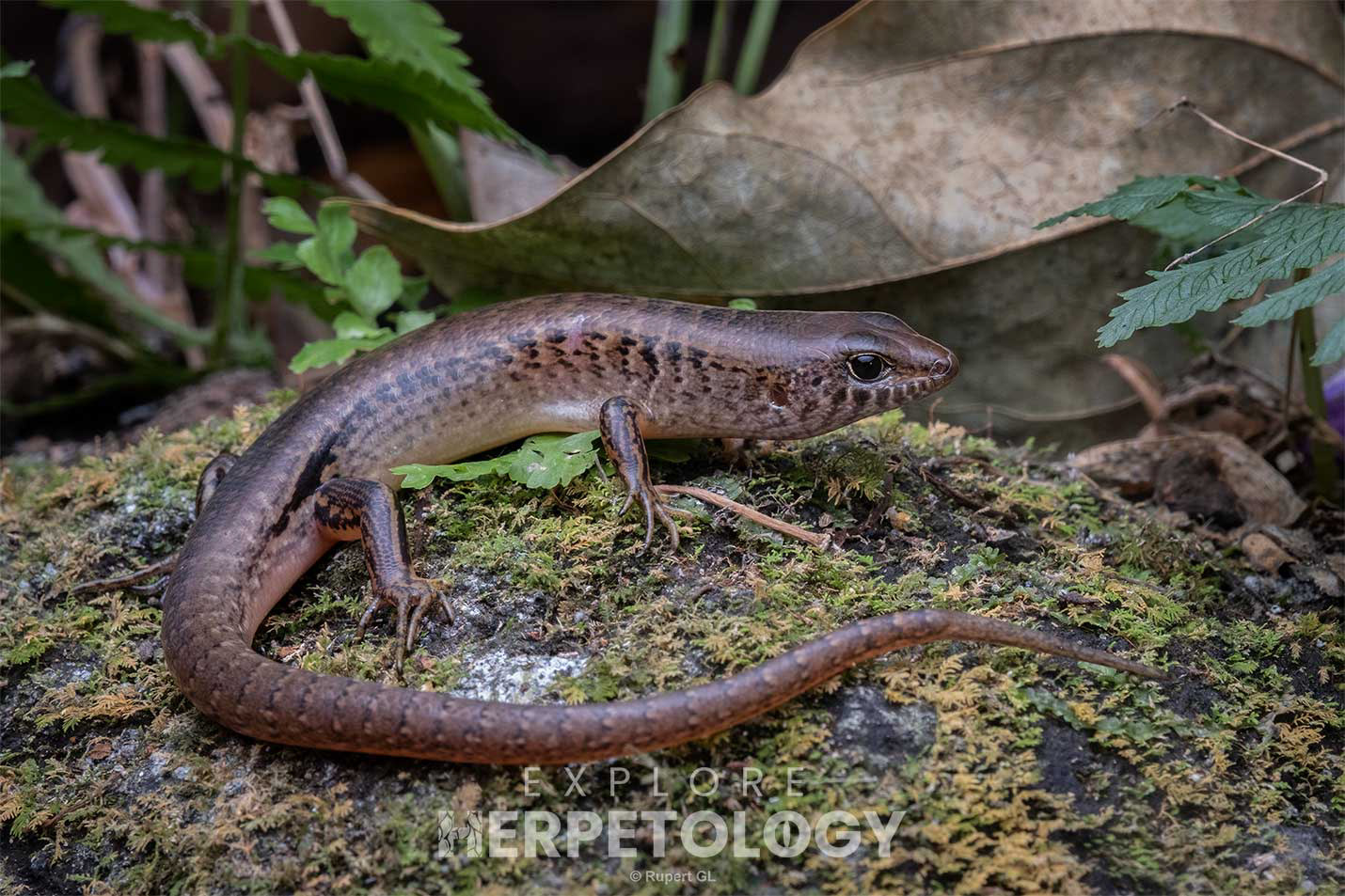
Pinoyscincus abdictus aquilonius
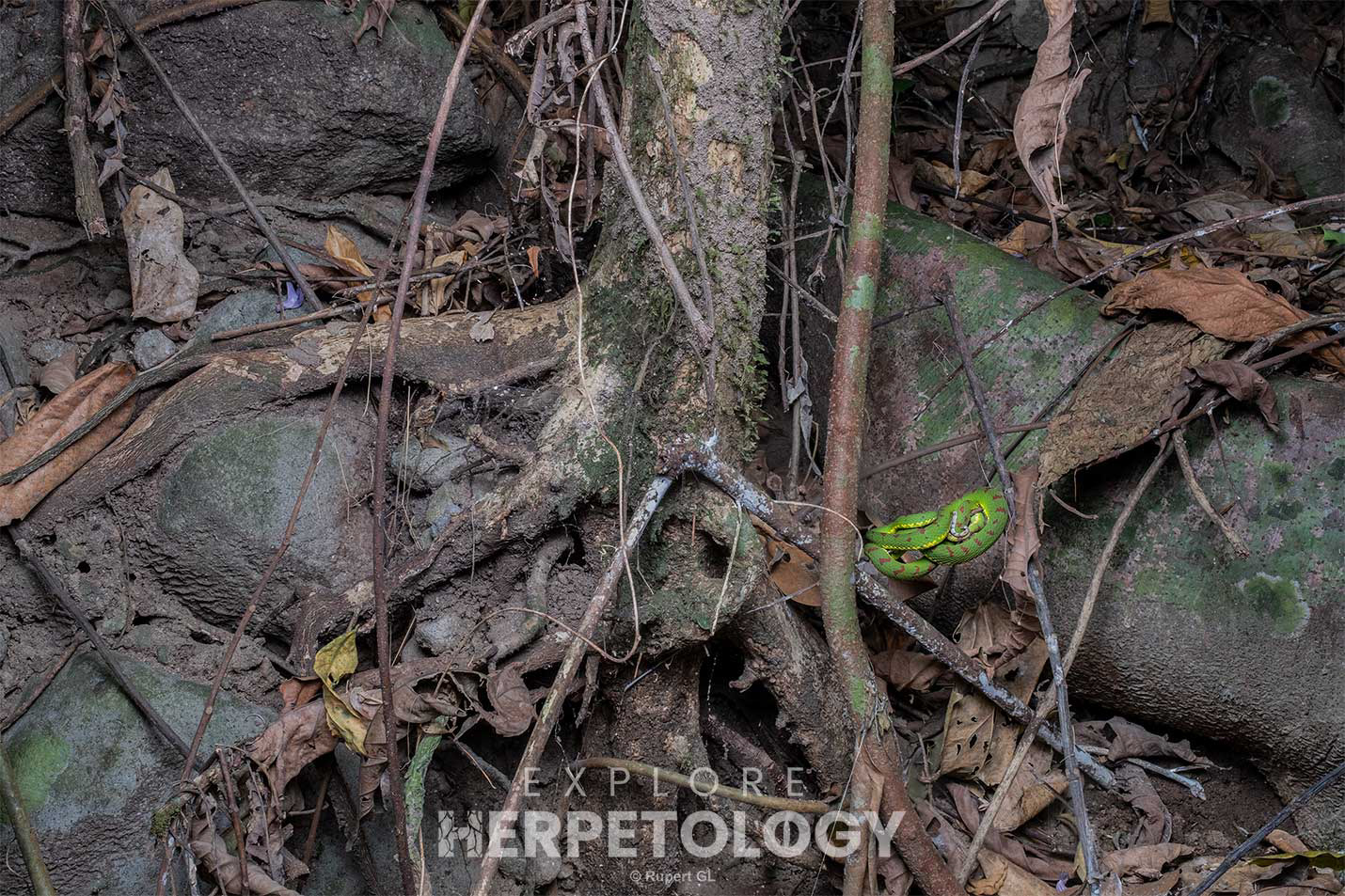
Philippine pit viper (Trimeresurus flavomaculatus)
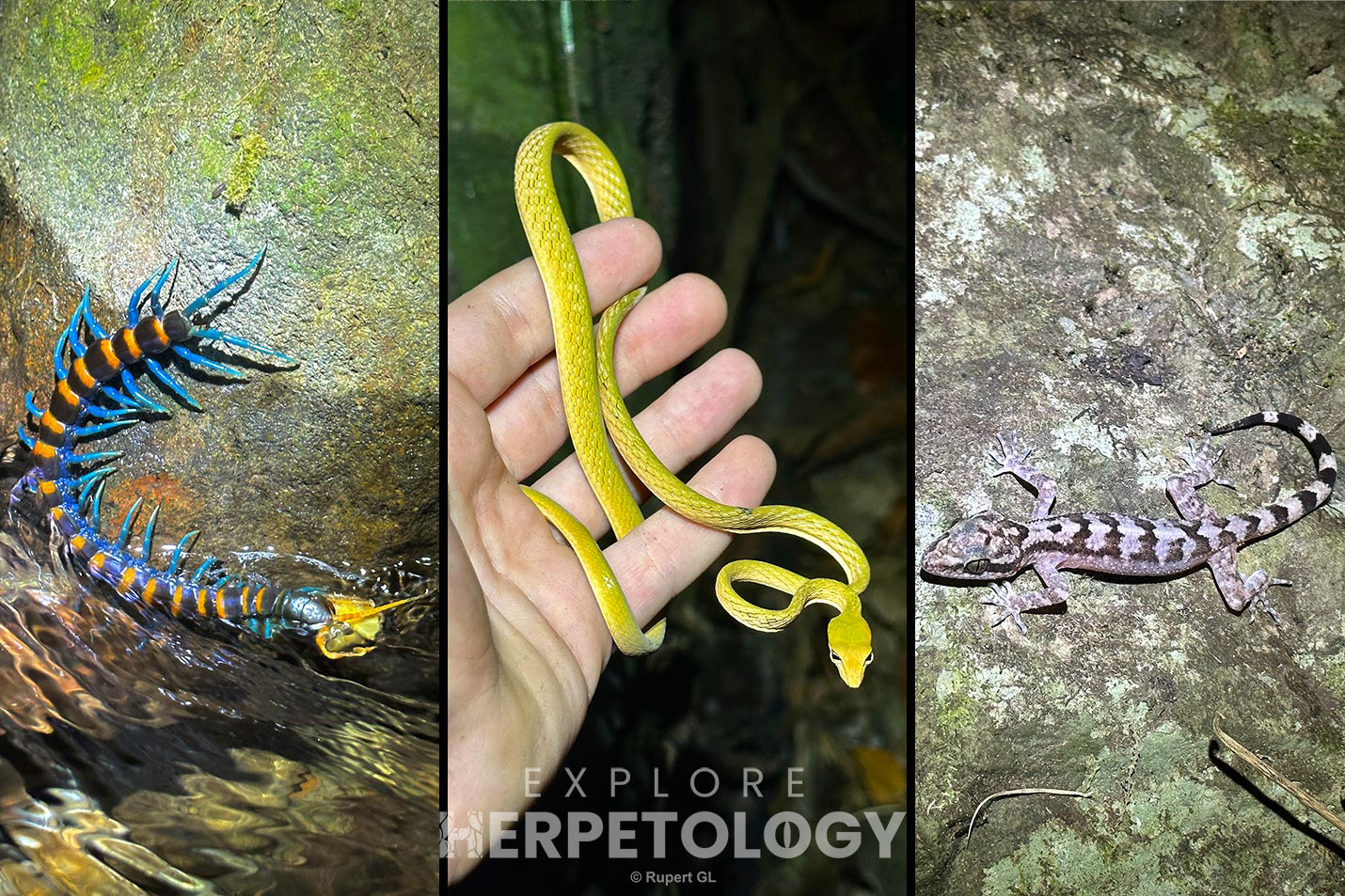
Left to right: strange Scolopendra sp., Ahaetulla prasina preocularis, Cyrtodactylus philippinicus.
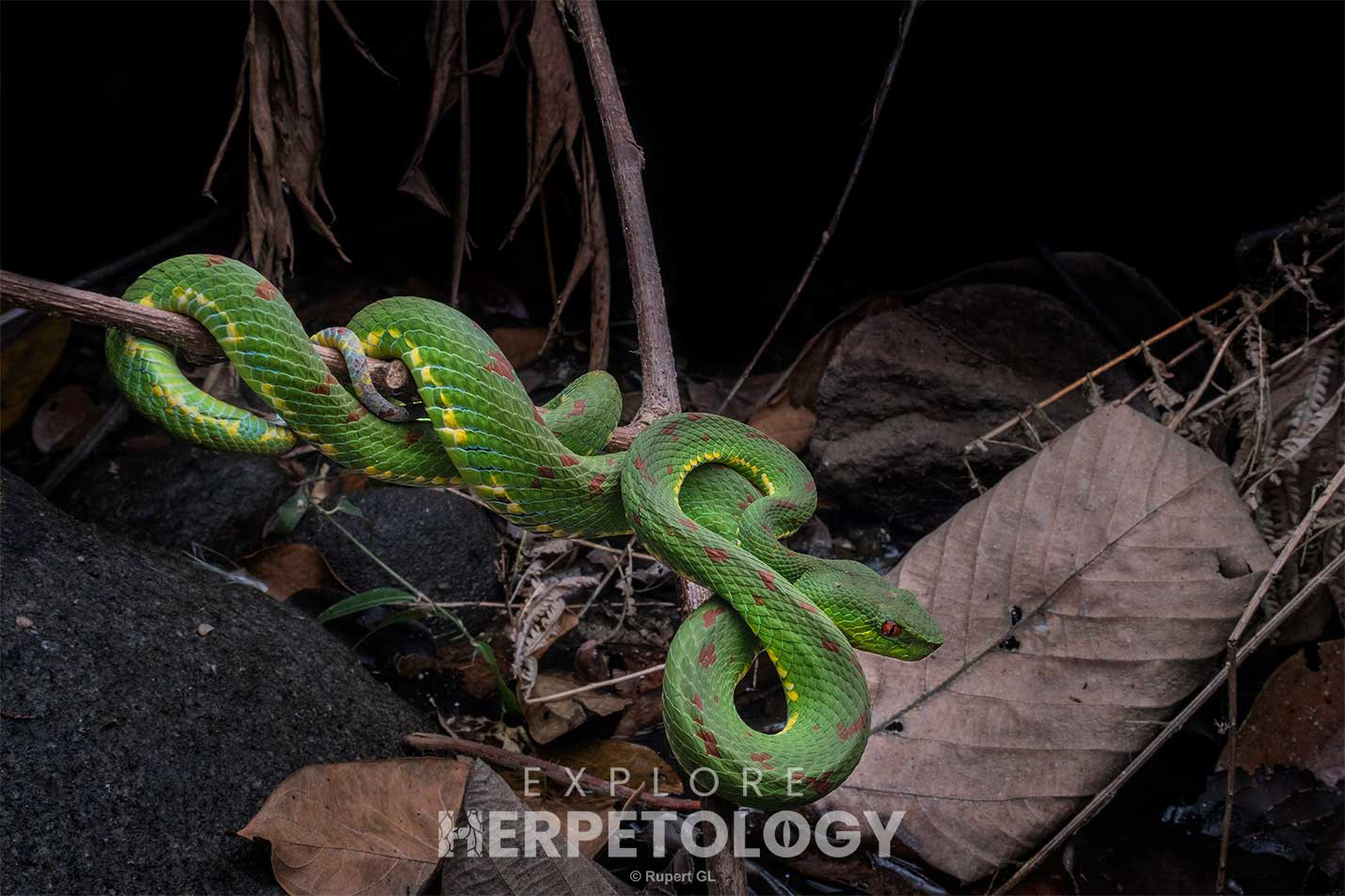
Philippine pit viper (Trimeresurus flavomaculatus)
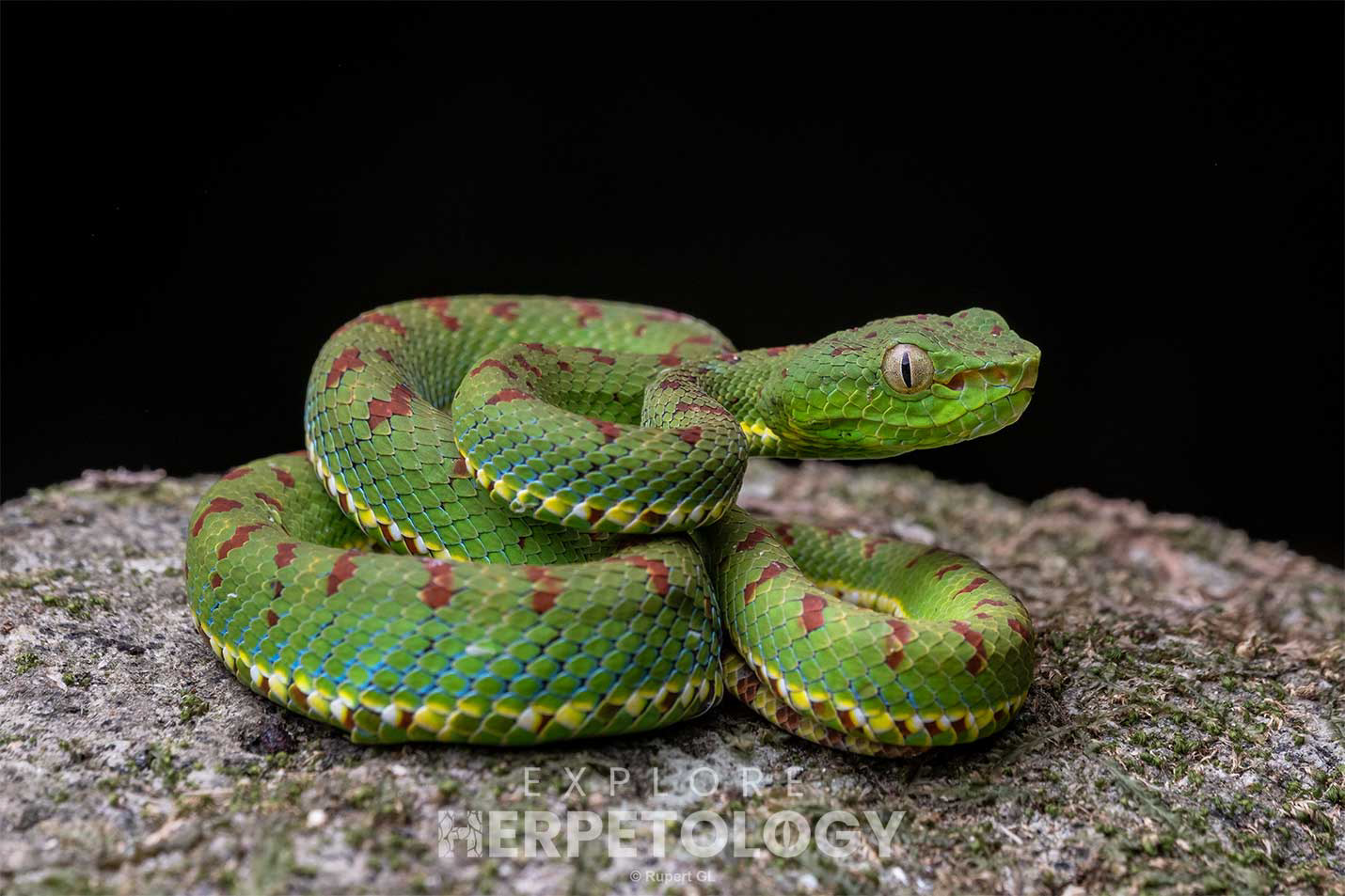
Philippine pit viper (Trimeresurus flavomaculatus)
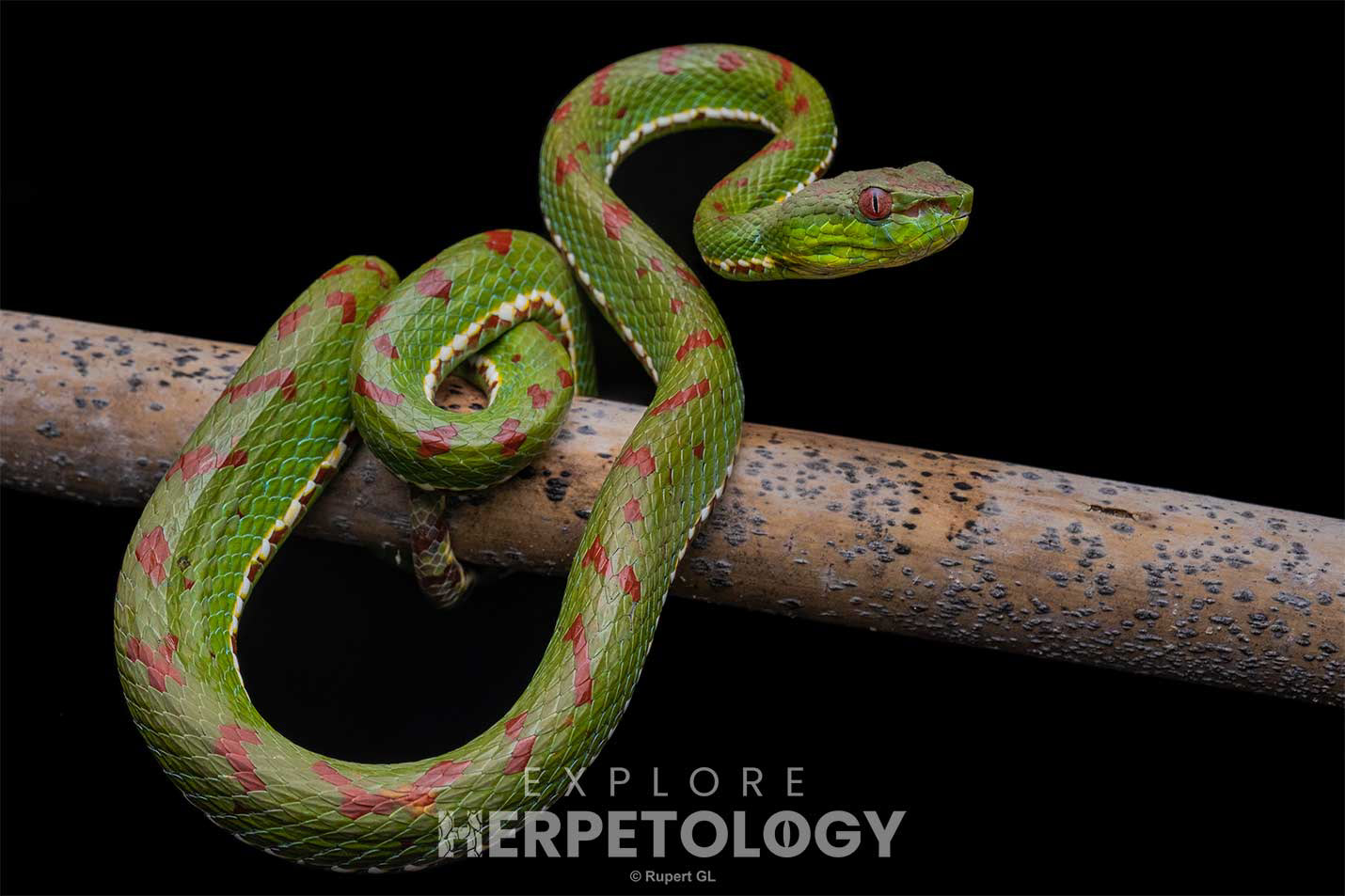
Philippine pit viper (Trimeresurus flavomaculatus)
Zamboanga City
With our warm-up night complete, it was time to get to the meat and bones of the expedition; Western Mindanao. This region is seldom visited by any naturalists, let alone herpers, primarily due to its political history. The current travel advice states: “Do not travel to central and western Mindanao (including the Zamboanga Peninsula; the Sulu Archipelago; and the southern Sulu Sea area) due to the very high threat of terrorist activity, kidnapping and violent clashes between the military/police and terrorist or rebel groups (level 4 of 4).”
Tourists have been specifically targeted in this region for kidnapping for ransom, which has led to the execution of many foreigners over the years - most famously two Canadian nationals in 2016. However, due to extreme military pressure on these groups, their presence and threat in the region has significantly decreased over the last two years. Our team have huge experience exploring Thailand’s Deep South, which had similarly been marred with separatist insurgency for decades, even visiting long ago in 2012 when the violence was at its peak. However, foreigners have never been targeted in the history of Thailand’s conflict - a total contrast to this area. Regardless, we were extremely confident that the jungle was the safest place we could be, and our research on the area and how/where incidents had occurred in the past made us even more confident.
Our absolute number 1 target for Western Mindanao was the South Philippine temple viper (Tropidolaemus philippensis), a species very rarely observed by naturalists and shrouded in mystery. There are many misidentified individuals floating around online, and their distribution is poorly known. The niche partitioning/overlap with Tropidolaemus subannulatus being particularly foggy. From our extensive research of all possible facets, it seemed like they were most commonly observed in Western Mindanao, and Zamboanga City in particular had two records from a location which looked accessible for us. Moreover, we were unable to find any confirmed records of Tropidolaemus subannulatus from the Zamboanga City area - leading us to believe that Tropidolaemus philippensis may be the dominant (or only) species of Tropidolaemus in the low elevation forests here, hypothetically increasing our chances of finding one in limited time. “A Naturalist' s Guide to the Reptiles of the Philippines” by Emerson Sy (2024) also noted that the population from Zamboanga may be a separate species - adding to our intrigue. Hereby, we stepped off the plane at Zamboanga City airport, picked up our rental car, checked into our hotel and immediately prepared to hit the forest.
Let it be known, there was absolutely no blueprint for this area. No trails, no open access areas. Everywhere was a gamble. We had a collection of coordinates scouted from Google Earth, and our plan was just to show up and make things happen. We decided to start with where I believed to be the most promising area, a forest edge with a gently sloping expanse of mature forest to explore. We actually did find a trail here, but it only took us 50 meters into the forest before dissipating into thick jungle. Almost an hour of back and forth bushwhacking later (getting scratched by plants and stung by wasps), we broke our way to a small, dry stream valley. This provided a much-needed ‘corridor’ through the forest, and snakes started showing up almost immediately.
First was a Philippine bronzeback (Dendrelaphis philippinensis), sleeping high up a tree but retrieved after significant effort, followed rapidly by a small mock viper (Psammodynastes pulverulentus). There were also several lizards running around, most notably the Misamis stream skink (Tropidophorus misaminius).
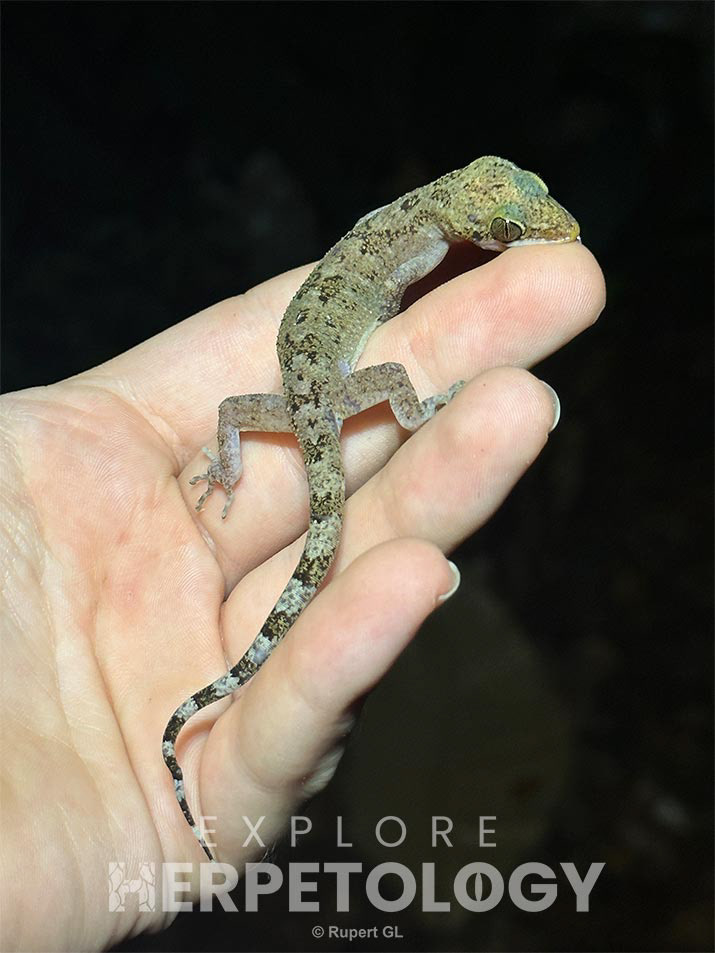
Cyrtodactylus cf. jambangan
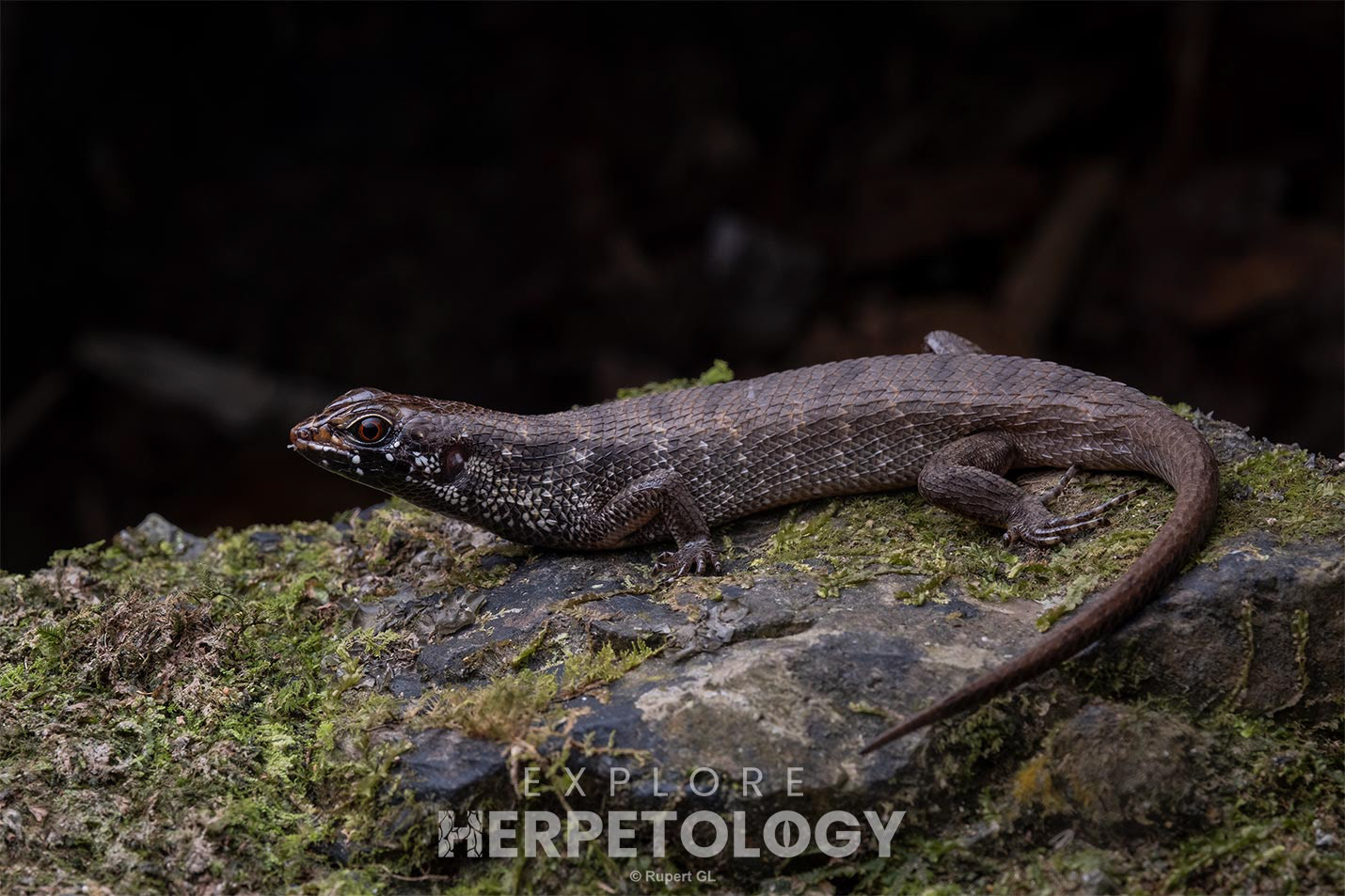
Misamis stream skink (Tropidophorus misaminius)
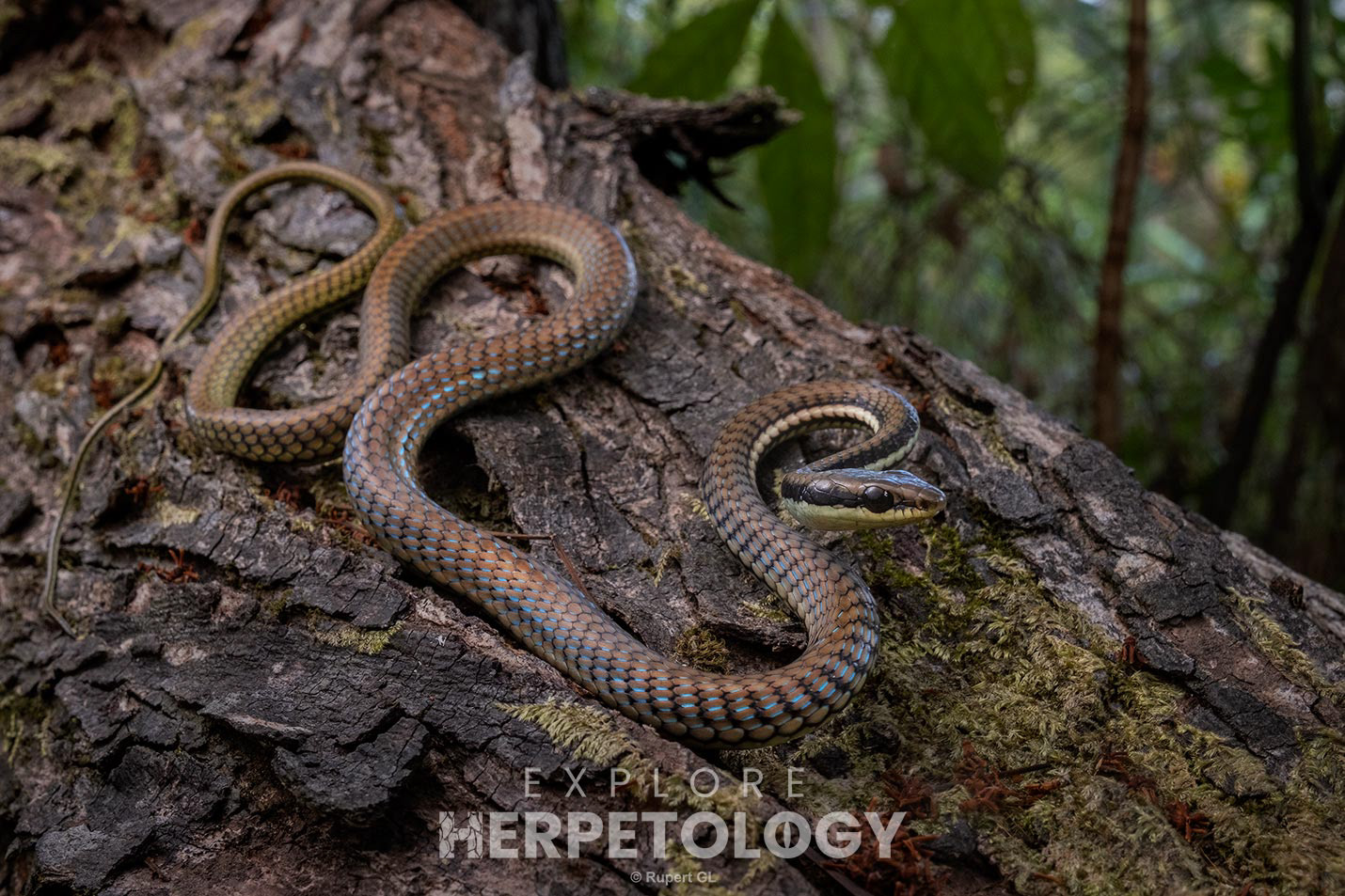
Philippine bronzeback (Dendrelaphis philippinensis)
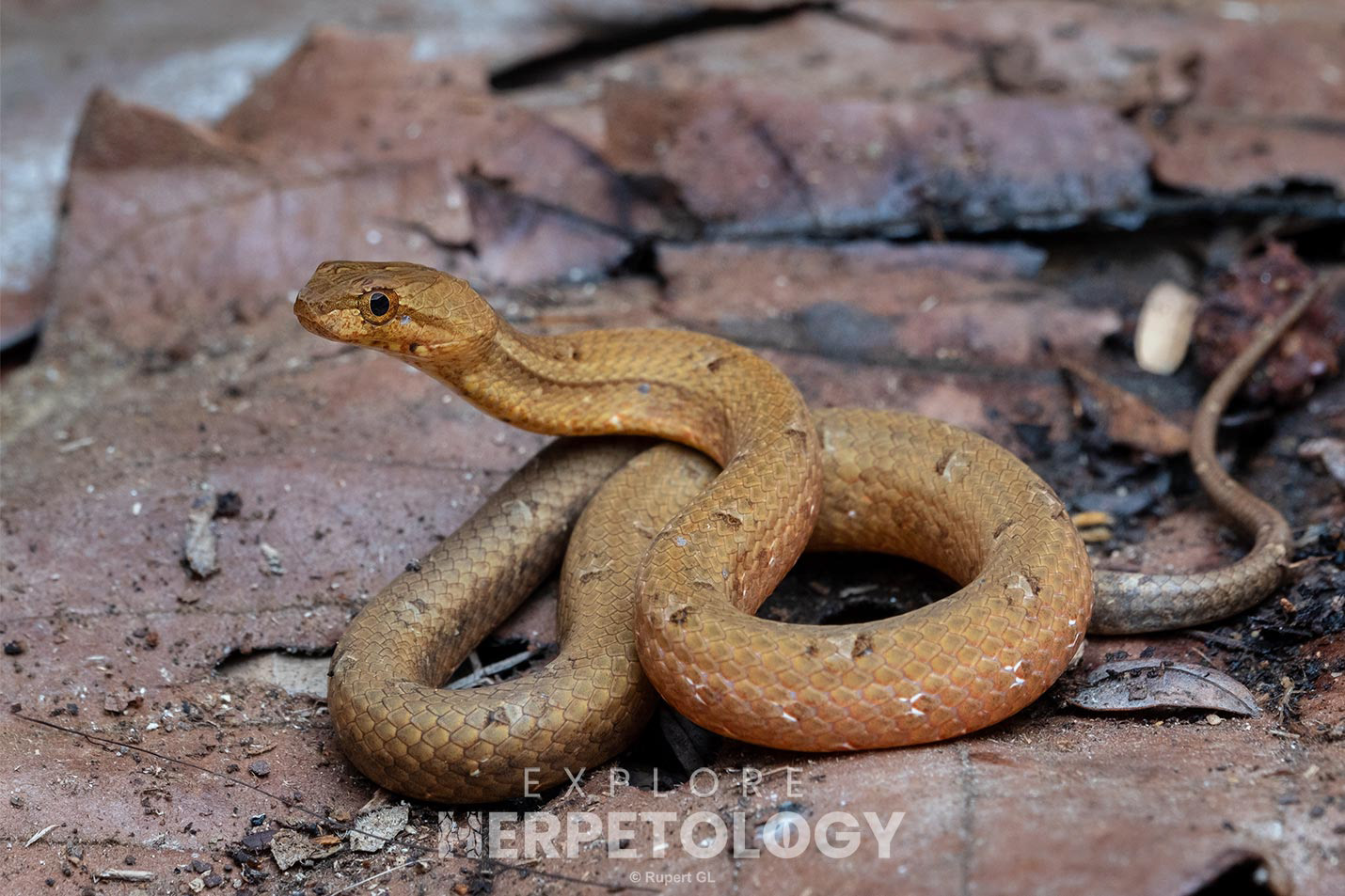
Mock viper (Psammodynastes pulverulentus)
Not much further down, Alex called out that he had spotted some kind of viper high up a palm tree. We could only see one chubby little coil, but the vibrant teal colouration was unmistakable. We very carefully used a long stick to bring it down, and were blessed with a simply magnificent sub-adult female of the mythical Zamboanga-clade South Philippine temple viper (Tropidolaemus philippensis). This snake completely exceeded our expectations, with extremely strong black patterning and an almost cyan-blue dorsum. We knew this was a very special snake and enjoyed every second of its presence, before gently returning it to its perch.
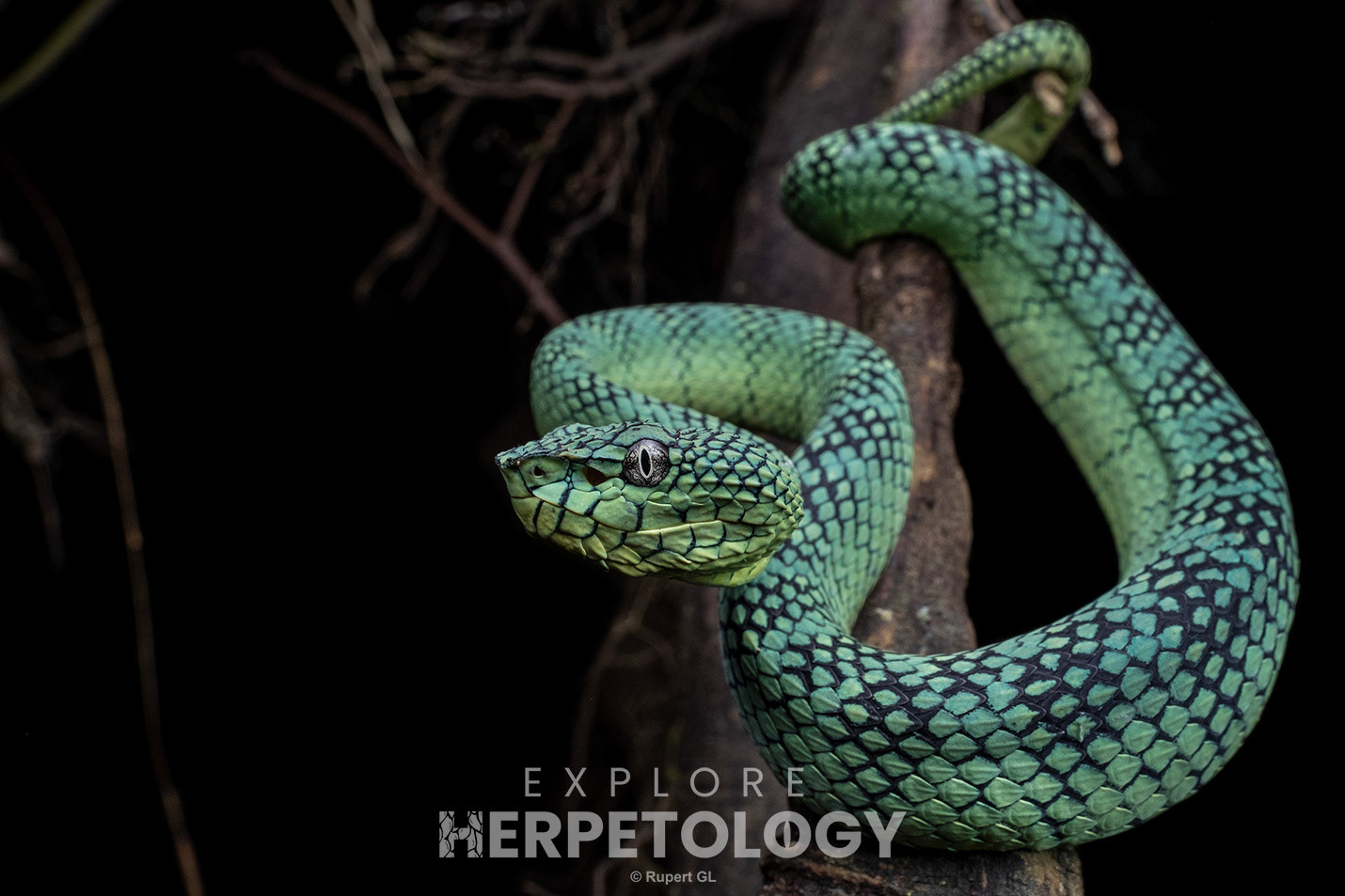
South Philippine temple viper (Tropidolaemus philippensis)
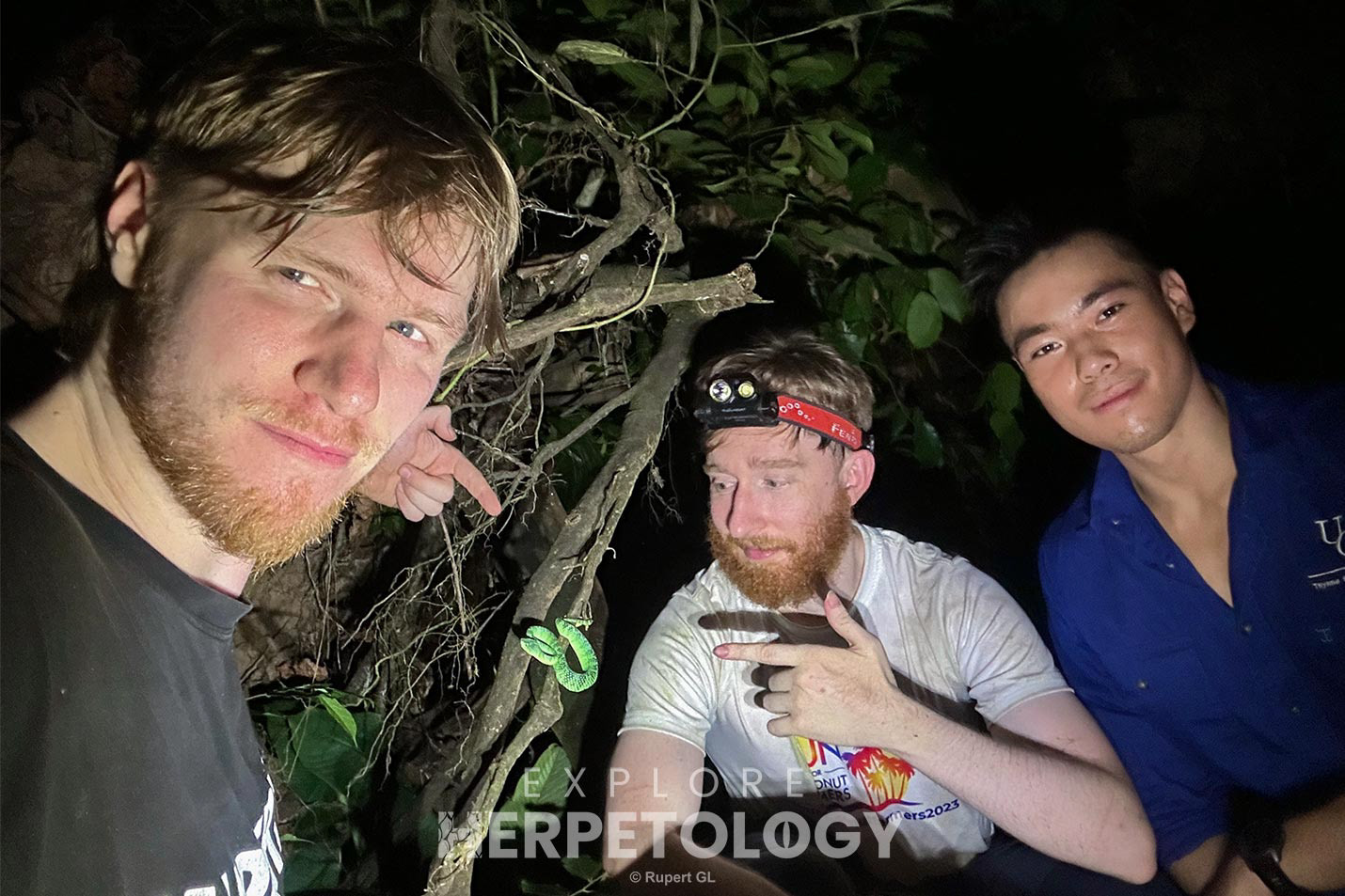
Group pic.
We tried to carry on down this valley towards what we hoped to be a permanent water body, but were met by an impassable gorge and decided to wrap up early. Again, we were due to wake up at 7am in the morning. Not for a flight this time, but for a permitted walk into Pasonanca Natural Park - where the first record (blurry phone photo) of Tropidolaemus philippensis from this area had been found. It had required a great effort to acquire these permits, so we were not going to pass up on the opportunity.
The DENR rangers at Pasonanca said they occasionally get birdwatchers visiting to search for some rare/endemic species occurring in the area, but we were the first ever reptile-focused group they had accommodated. Despite our walk starting quite early in the morning, the heat and humidity was brutal already. It took a lot of mental resilience to push through what we call the “sweat barrier”, get blood pumping through the muscles and get our heads in the right mindset. There was one particular point where we had to ascend a steep, slippery slope and Keith ended up going prone (some may have seen this hilarious video on instagram). However, this slightly karstic, dry forest habitat with was a magical environment to explore and it wasn’t long before we were locked in.
The rangers accompanying us were taking us on what could only be described as a prime birdwatching route, so I suggested we descend into some darker valleys where snakes are more likely to be dwelling during such hot weather. While walking beside another dry stream bed, I glanced up and spotted the unmistakable outline of a pit viper coiled against a standalone palm tree. Closer inspection revealed it to be a larger female South Philippine temple viper (Tropidolaemus philippensis). While it was still quite diminutive and not what one would consider an adult of any other Tropidolaemus species, the maximum recorded size of T. philippensis is only 45 centimeters. This one was almost 40 cm in length, leading us to designate it as an ‘adult female’ for now.
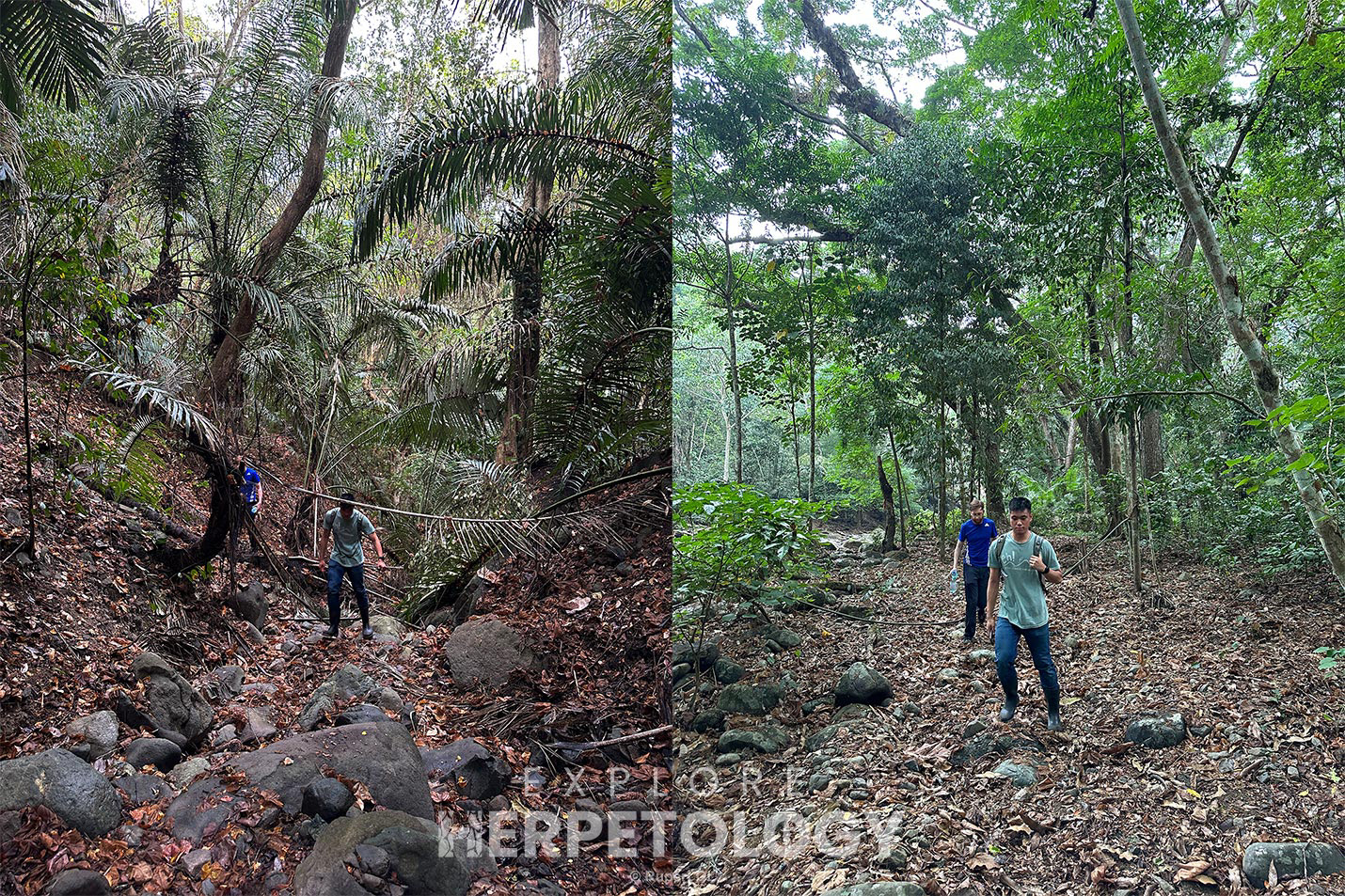
Habitat in Pasonanca Natural Park.
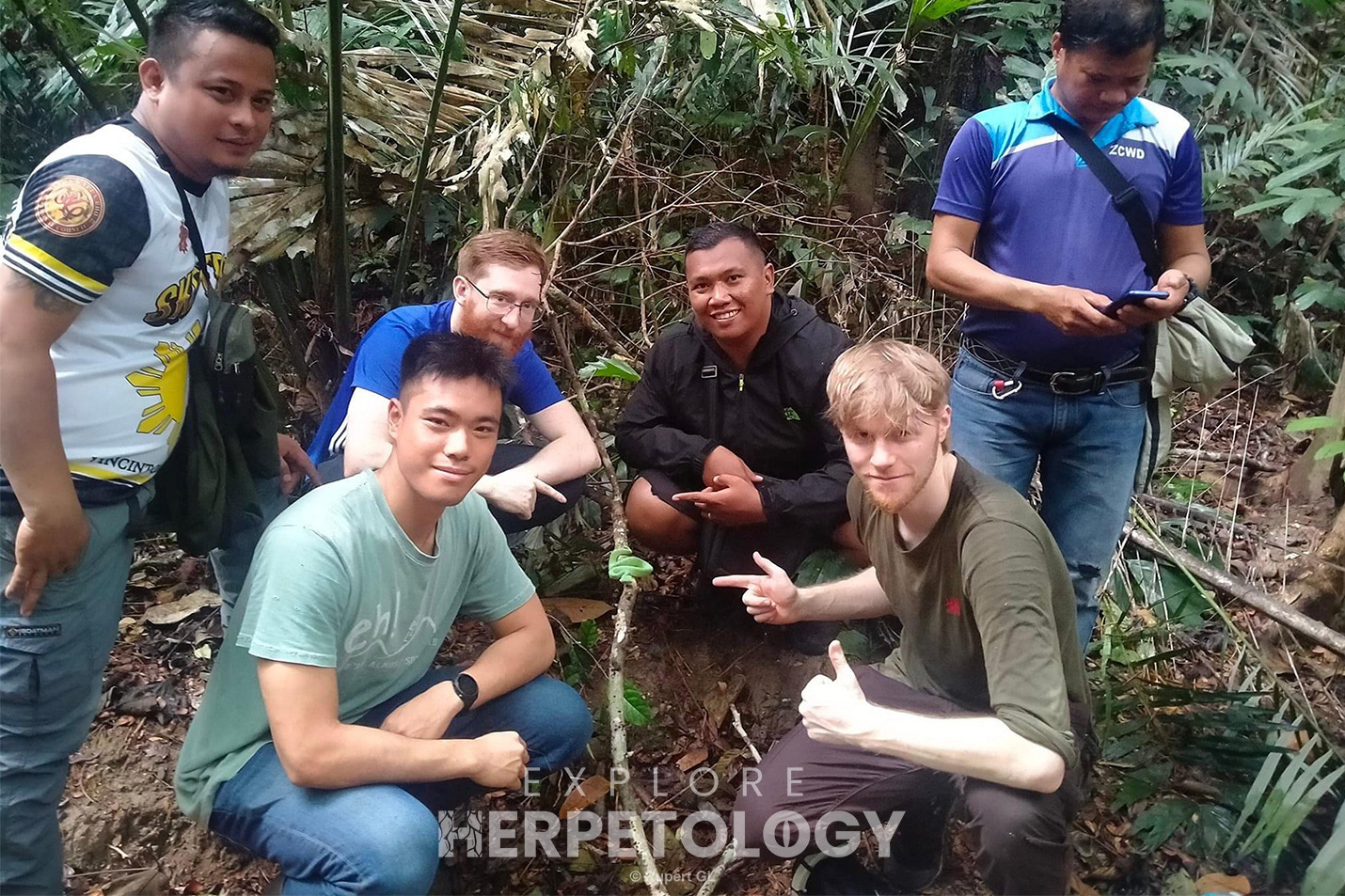
Group pic!
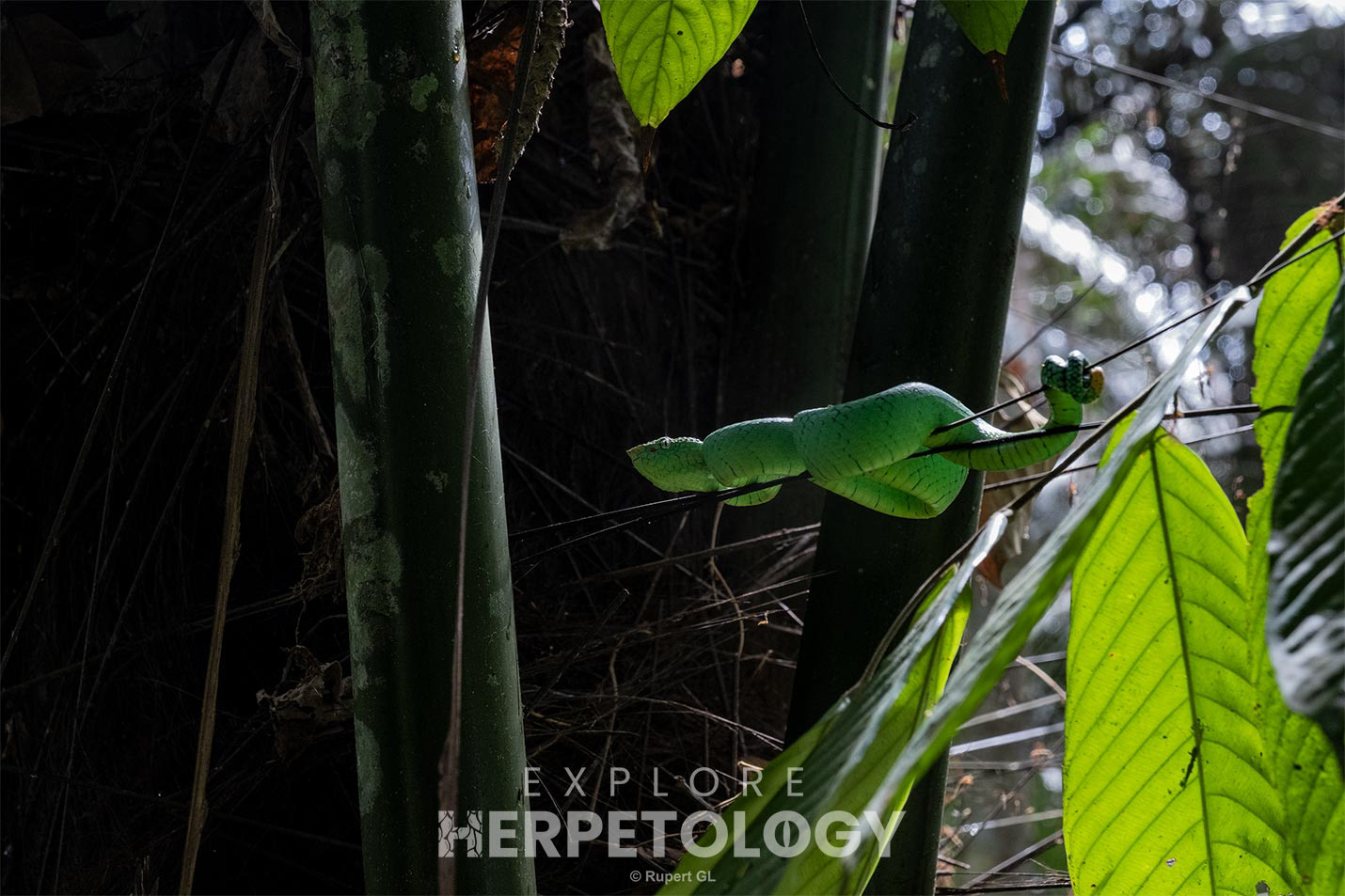
In-situ (as found).
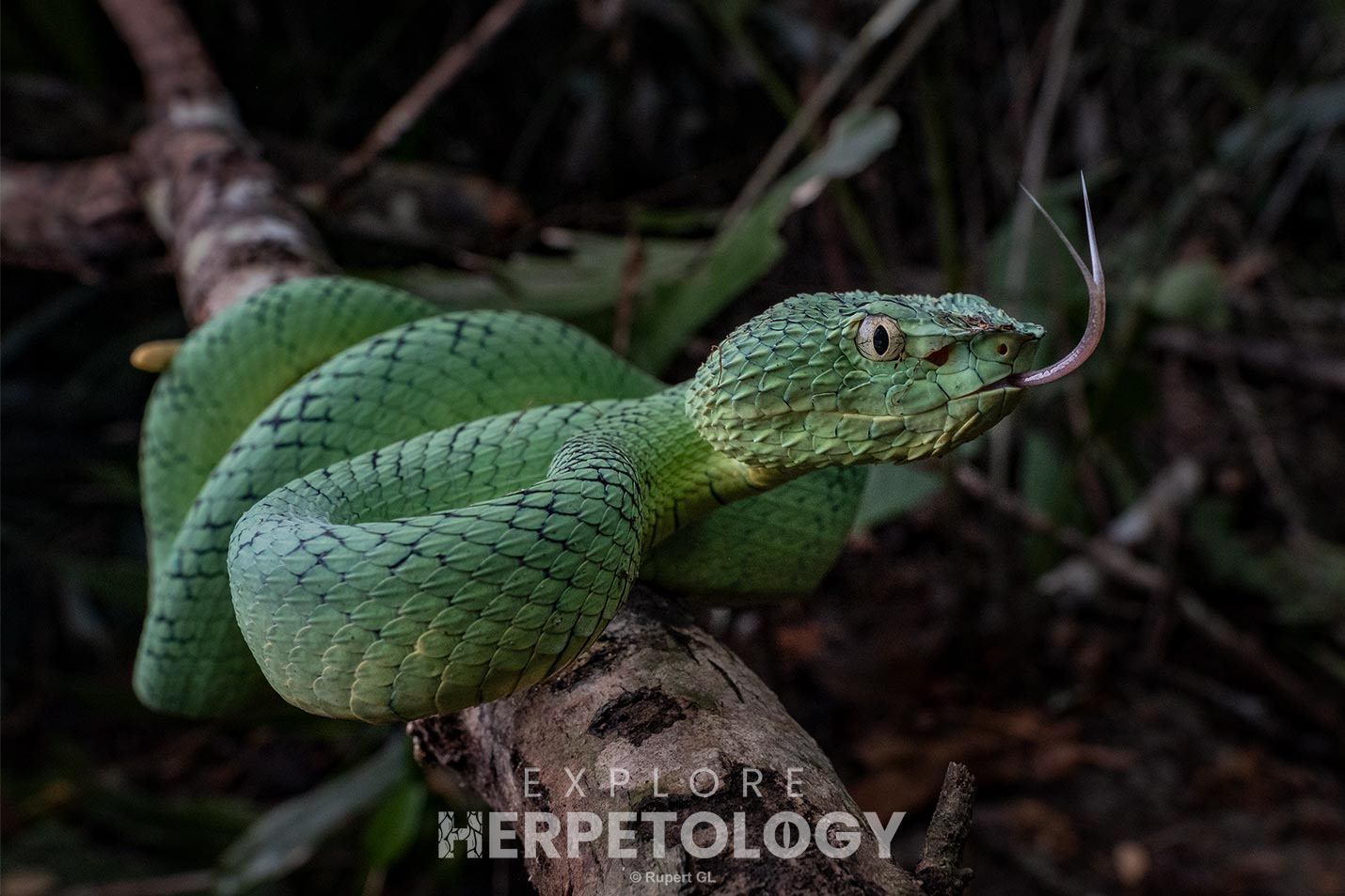
South Philippine temple viper (Tropidolaemus philippensis)
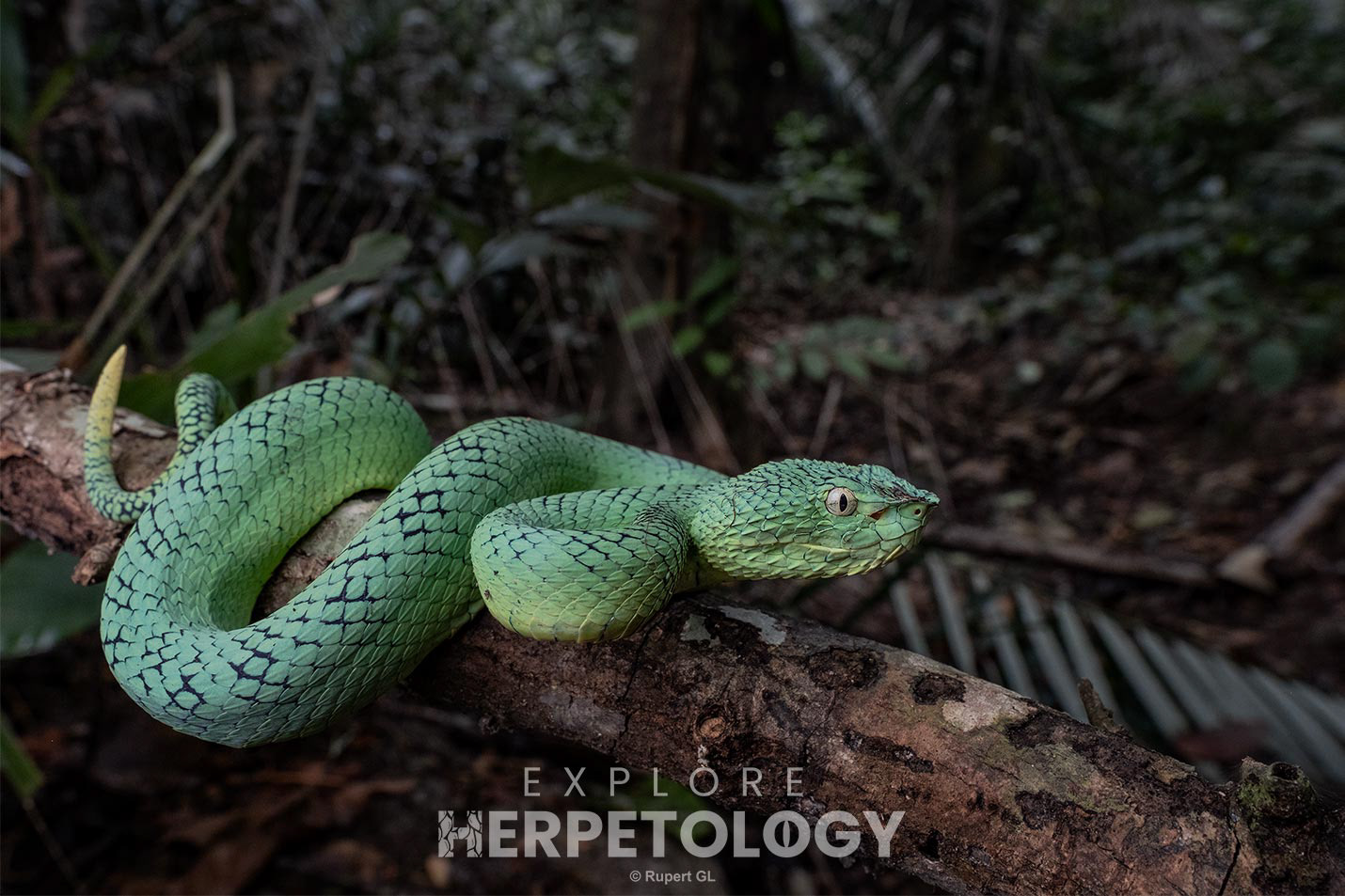
South Philippine temple viper (Tropidolaemus philippensis)
Our success with Tropidolaemus philippensis left the Mindanao clade of Trimeresurus aff. flavomaculatus as our only target remaining in the area, with two nights to apply our search. This species has never been recorded from Zamboanga City, but we were confident that if we could reach a substantial stream or river within the forest then we could find them. During such dry conditions, there is almost no chance of seeing them away from water. Tragically, we were turned away from the first location we tried to access - with by far the most promising potential for getting to the river. To make matters even worse, the battery on our rental car died when we stopped for fuel, wasting time finding jump leads, and we were not sure if the car would start again if we turned it off. Our rental company did not have a replacement vehicle. It seemed like everything had gone wrong at once.
The secondary site we had selected to explore as a contingency was over an hour’s drive into the hills from our hotel, with not a shred of phone service in the area. We could not afford to have our car die on us here. Our solution to this obstacle was to keep the engine of the car running all night long, and have each of our team take turns doing a ‘shift’ whereby they keep the car nearby at all times. This restricted our movement and freedom considerably, but our fortunes turned around when we road-cruised a very interesting snake the moment we arrived at our location.
It was a beautiful Mindanao kukri snake (Oligodon maculatus), a rarely seen endemic to Southern Philippines which we had really hoped to encounter during this expedition. It was also very docile, unusual for a kukri snake but greatly appreciated. More herping this evening produced two Philippine bronzebacks (Dendrelaphis philippiensis), one of which was huge, a mock viper (Psammodynastes pulverulentus), a Philippine vine snake (Ahaetulla prasina preocularis) and some nice frogs.
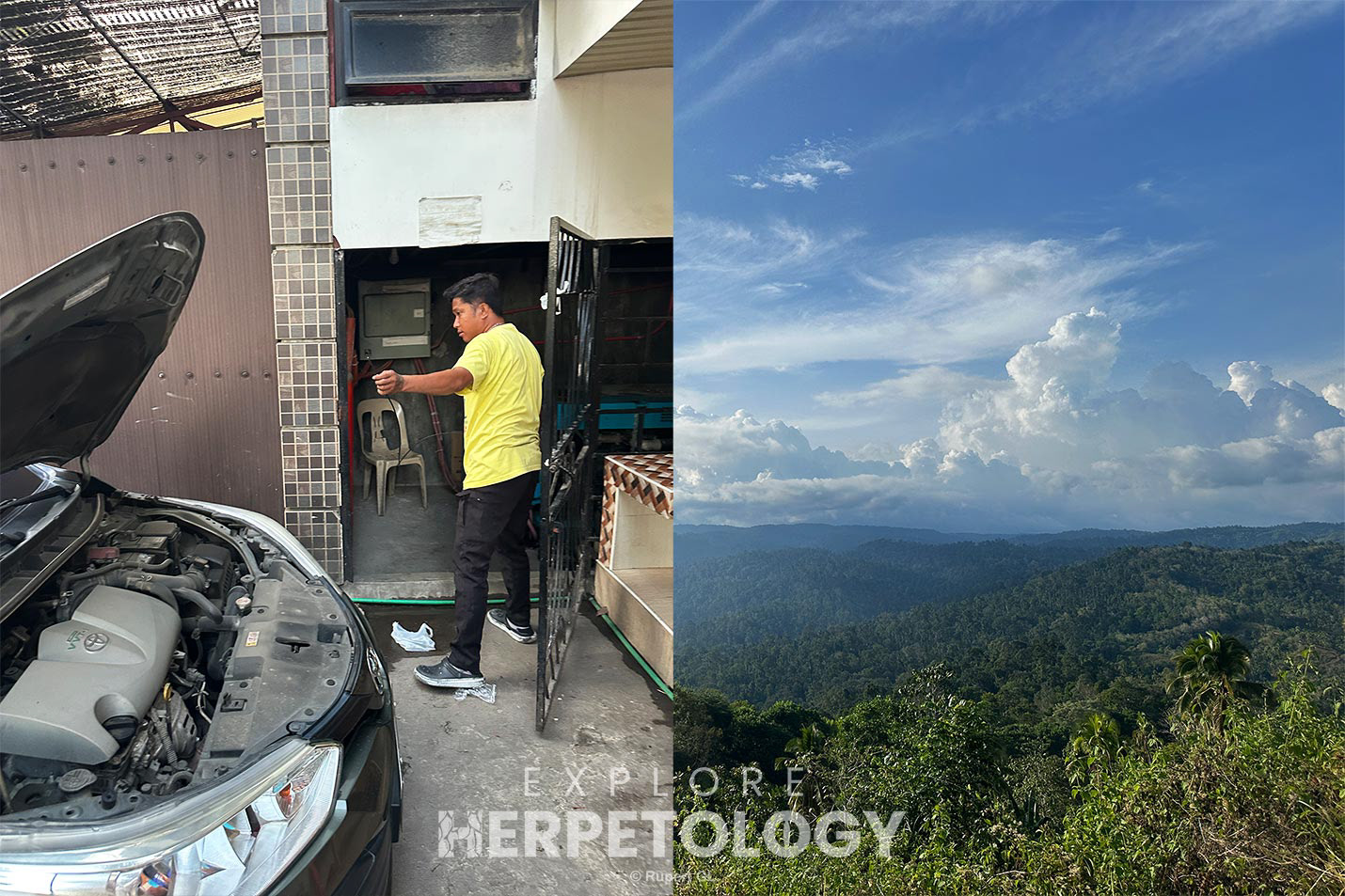
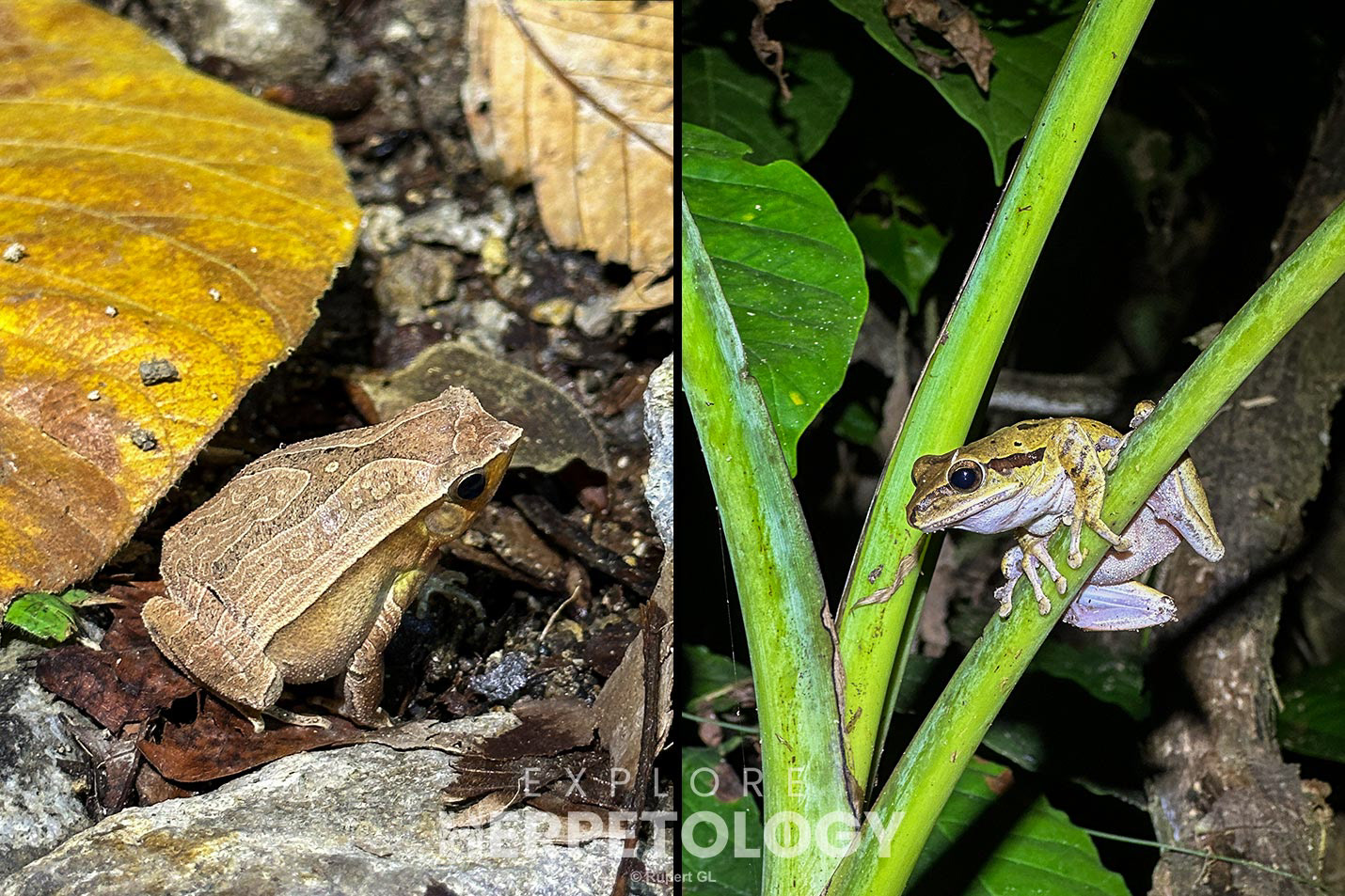
Left: Kalophrynus sinensis. Right: Polypedates leucomystax.
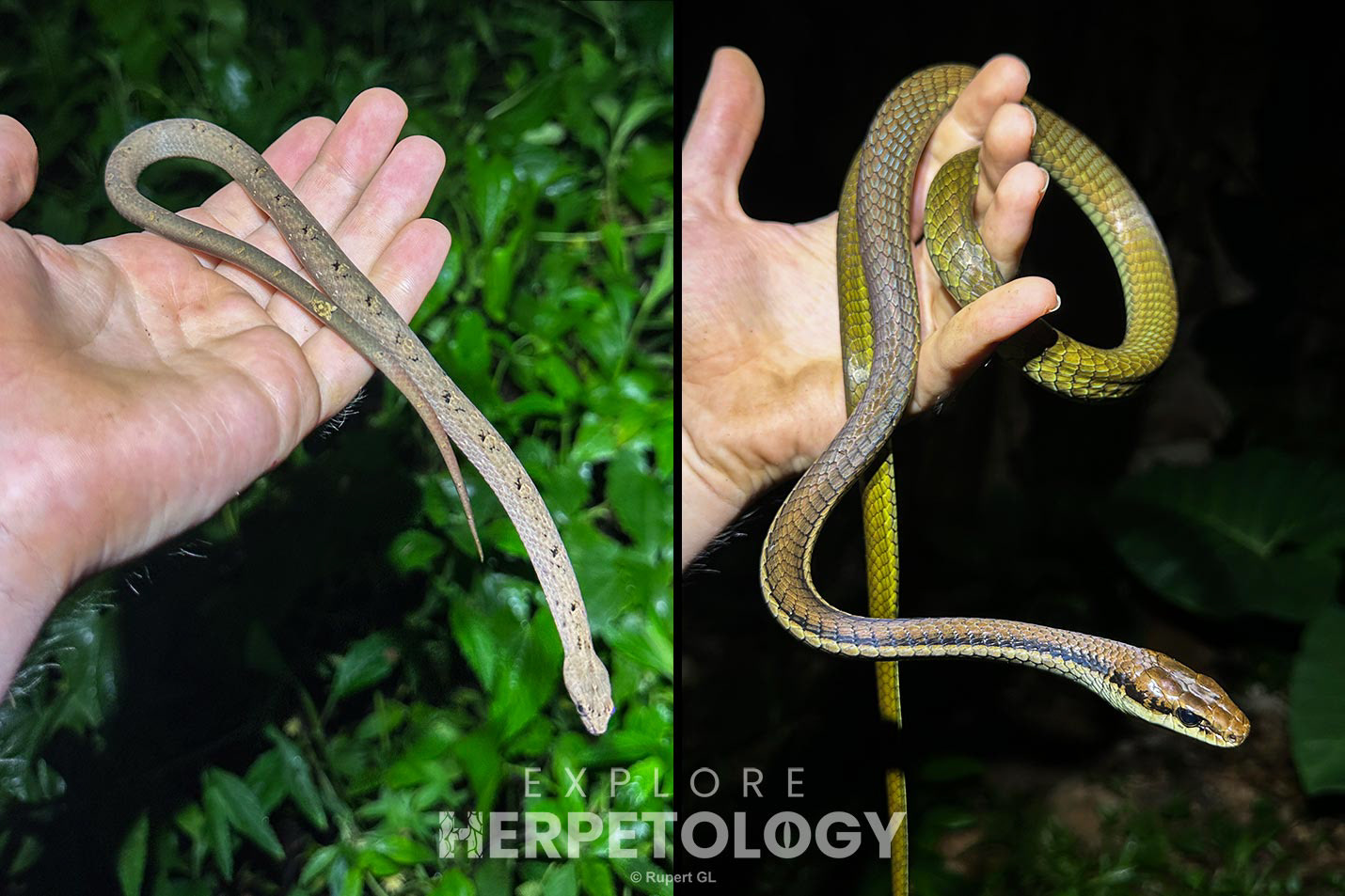
Left: Psammodynastes pulverulentus. Right: Dendrelaphis philippiensis.
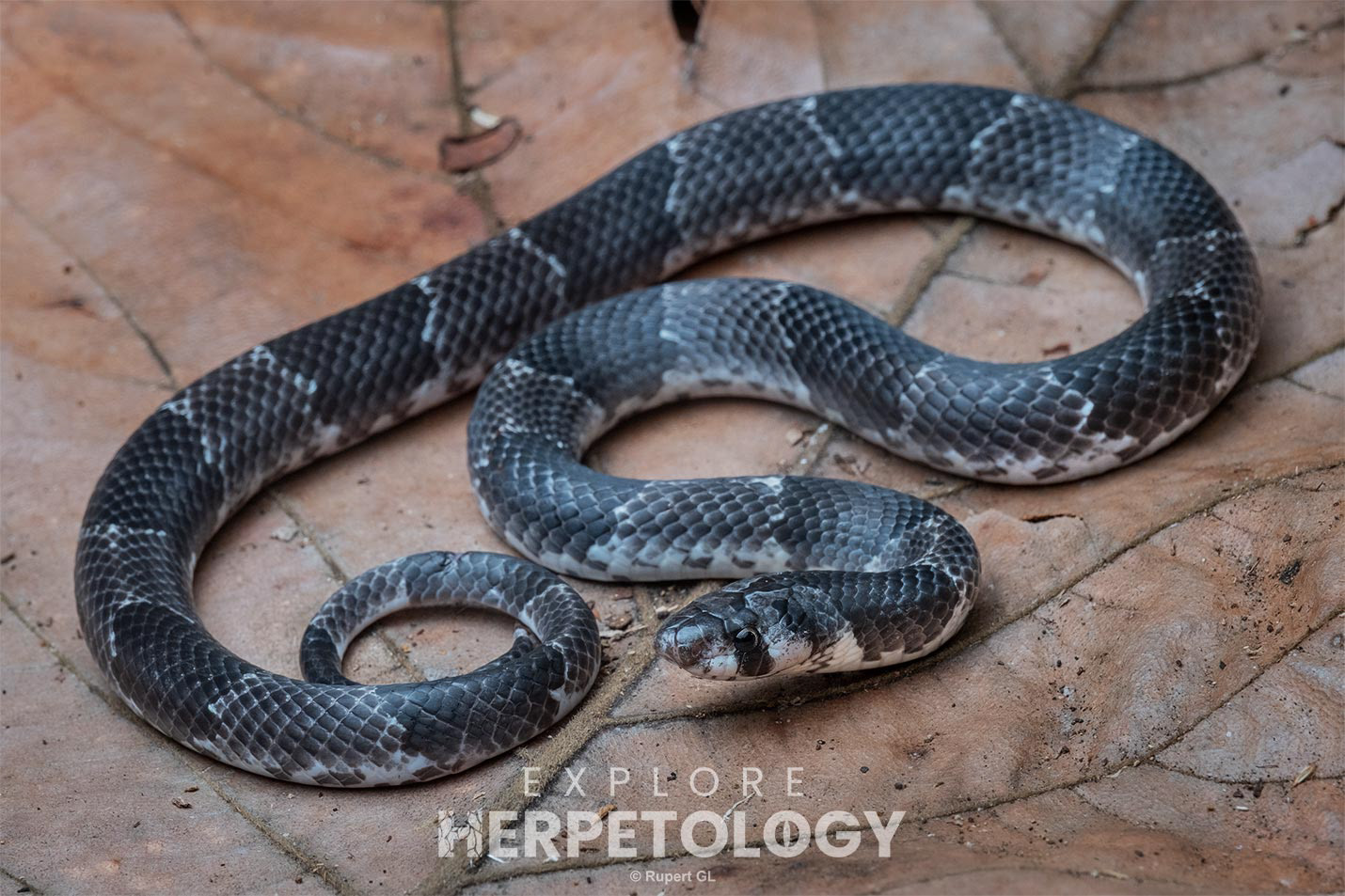
Mindanao kukri snake (Oligodon maculatus)
Our third and final day in Zamboanga presented one final chance to locate water and give ourselves a real chance at finding the desired Trimeresurus. We spent most of the daytime doing excessive scouting of Google Earth, debating what the best option is, and mentally preparing for the night ahead. To say it had been easy in Zamboanga would be a lie. It had been mentally and physically draining already, and navigating our way through local communities (who may not be partial to strangers) and finding accessible forest not strictly protected by DENR added a thick layer of tension to every evening.
Our final decision was to hike 2 kilometers through hilly agricultural land and access a patch of forest which seemed to lead to a substantial stream valley, hoping for some kind of access. En-route through the forest-edge agricultural land, we encountered a strange reed snake (Calamaria sp.) on the trail. It was extremely slender and did not match the description of any other Calamaria occurring on Mindanao, likely an undescribed species.
Upon reaching the jungle, we were met with incredibly dense forest edges which scratched our arms up during our attempts to battle through. On the other side, there was space to walk around but the route to the hypothetical water was constantly blocked by overgrown vegetation caused by fallen trees. In one of these particular areas, I disturbed not one, but two zig-zag lined keelbacks (Rhabdophis lineatus) from under some fallen vegetation. This was an unexpected but very welcome find.
Unfortunately, time went by too fast and it became clear that if we were to get a semi-decent night’s sleep and be up at 7am again the following day for an important flight, we had to forsake this mission and start the hike back to the car. Again, we were presented with the pleasant surprise of a Philippine shrub snake (Oxyrabdion modestum) crossing the trail on our way back, along with a taxonomically ambiguous angle-headed lizard (Gonocephalus sp.). Considering we had spent the night focused on finding access and not snakes, 3 lifer snakes was a really positive turnout and made us optimistic heading into the final and most intrepid leg of the expedition.
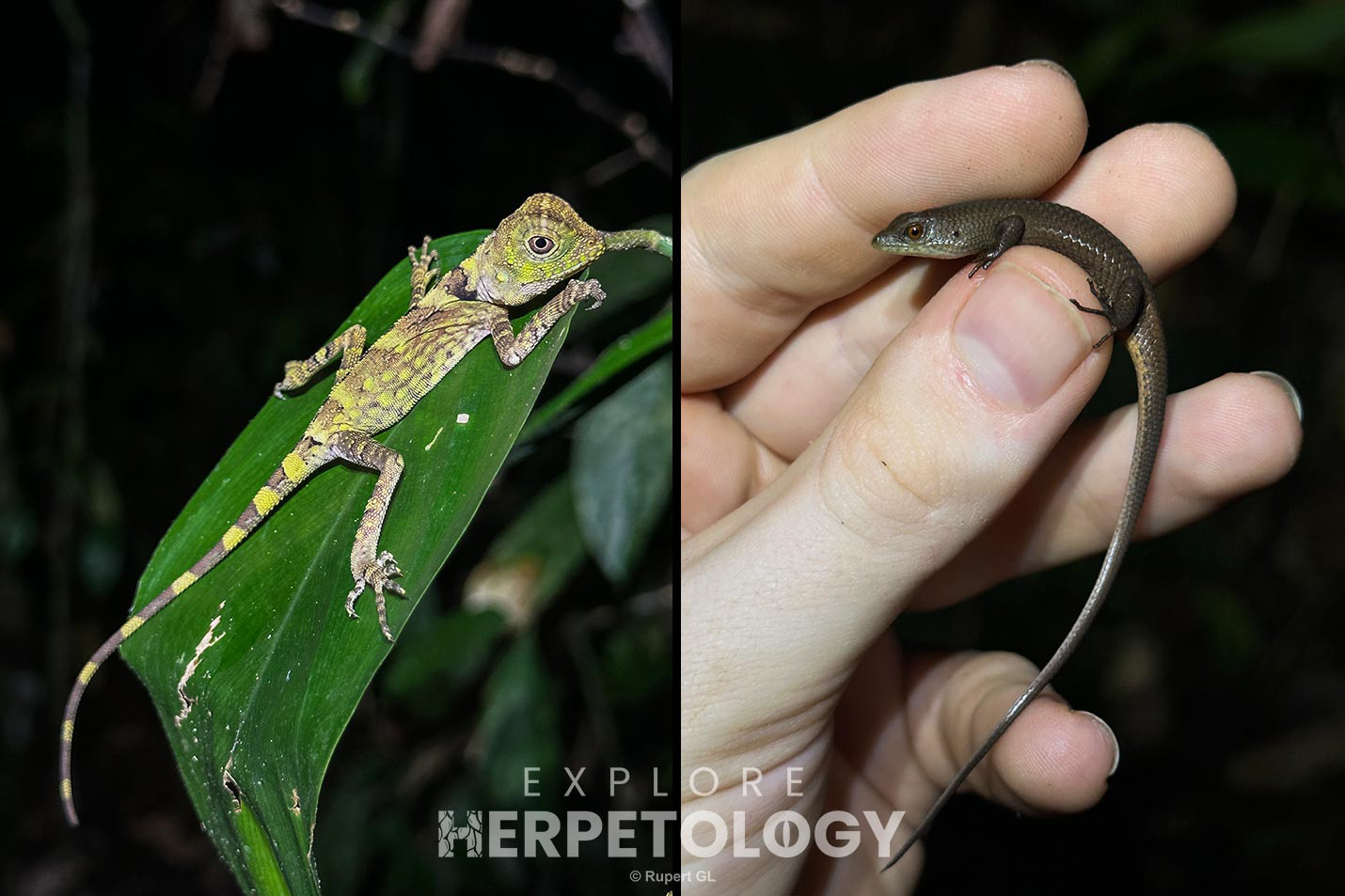
Left: Gonocephalus sp. Right: Unknown scincid.
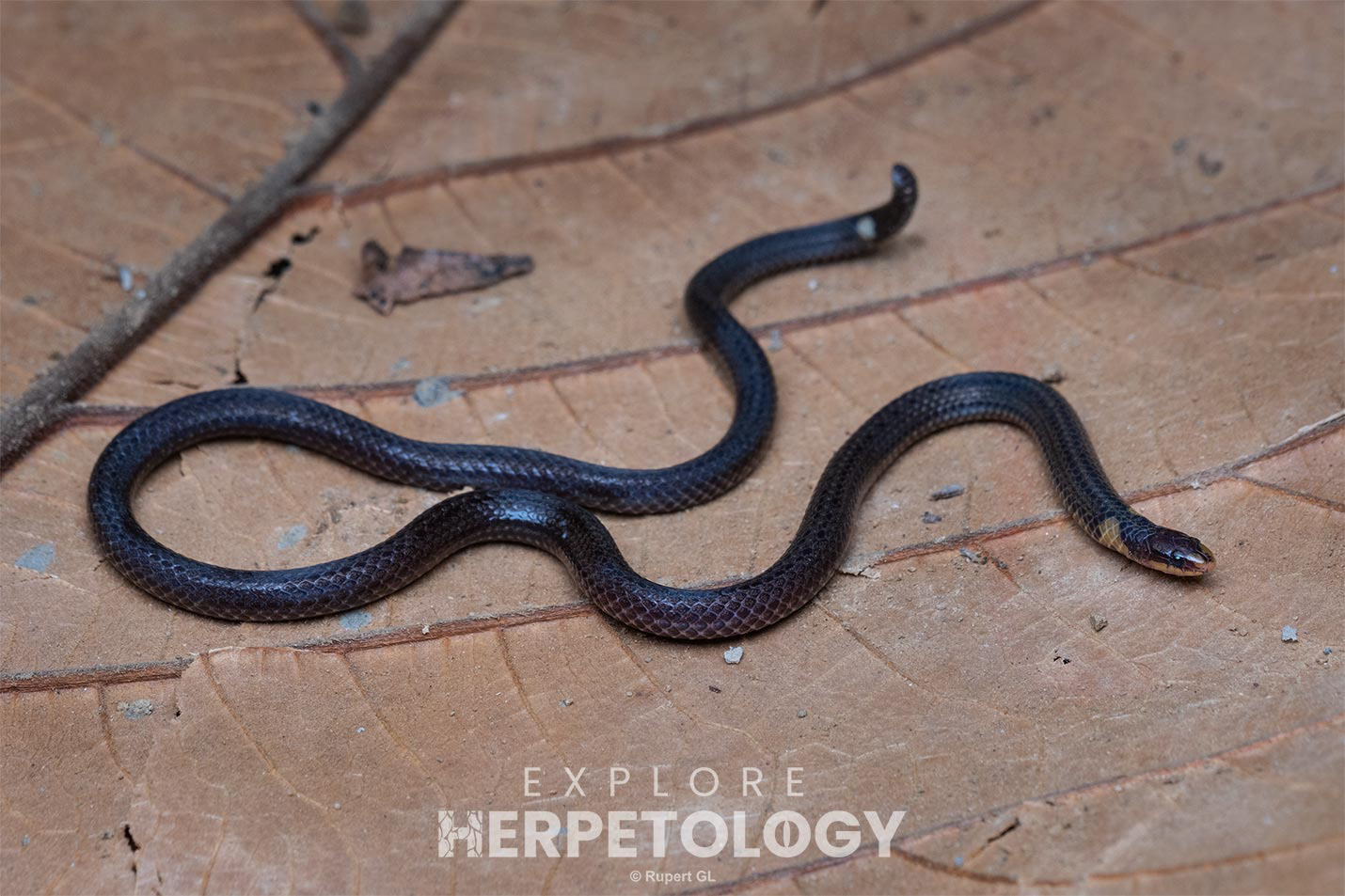
Taxonomically uncertain reed snake (Calamaria sp.)
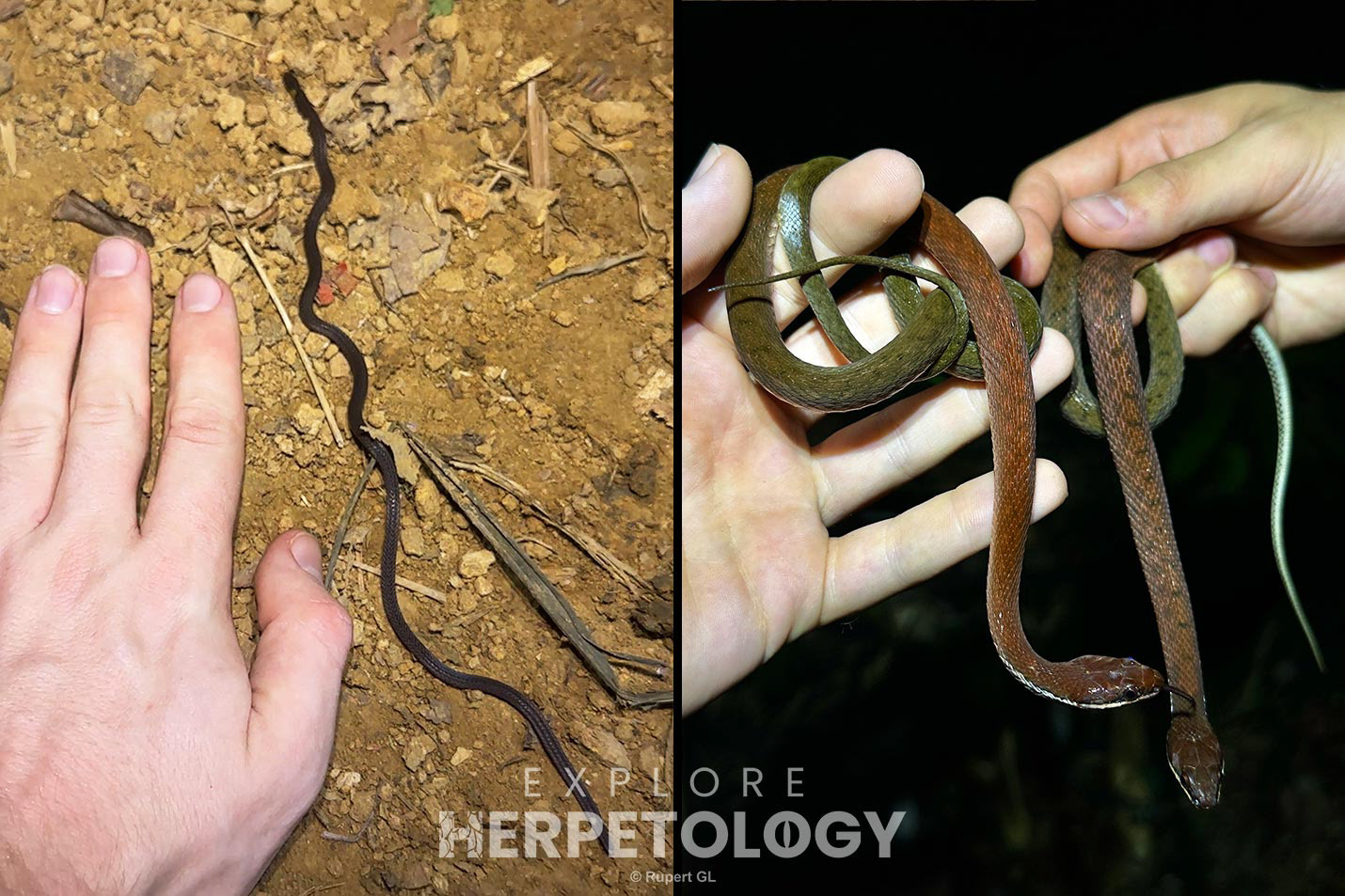
Left: Calamaria sp. Right: Rhabdophis lineatus.
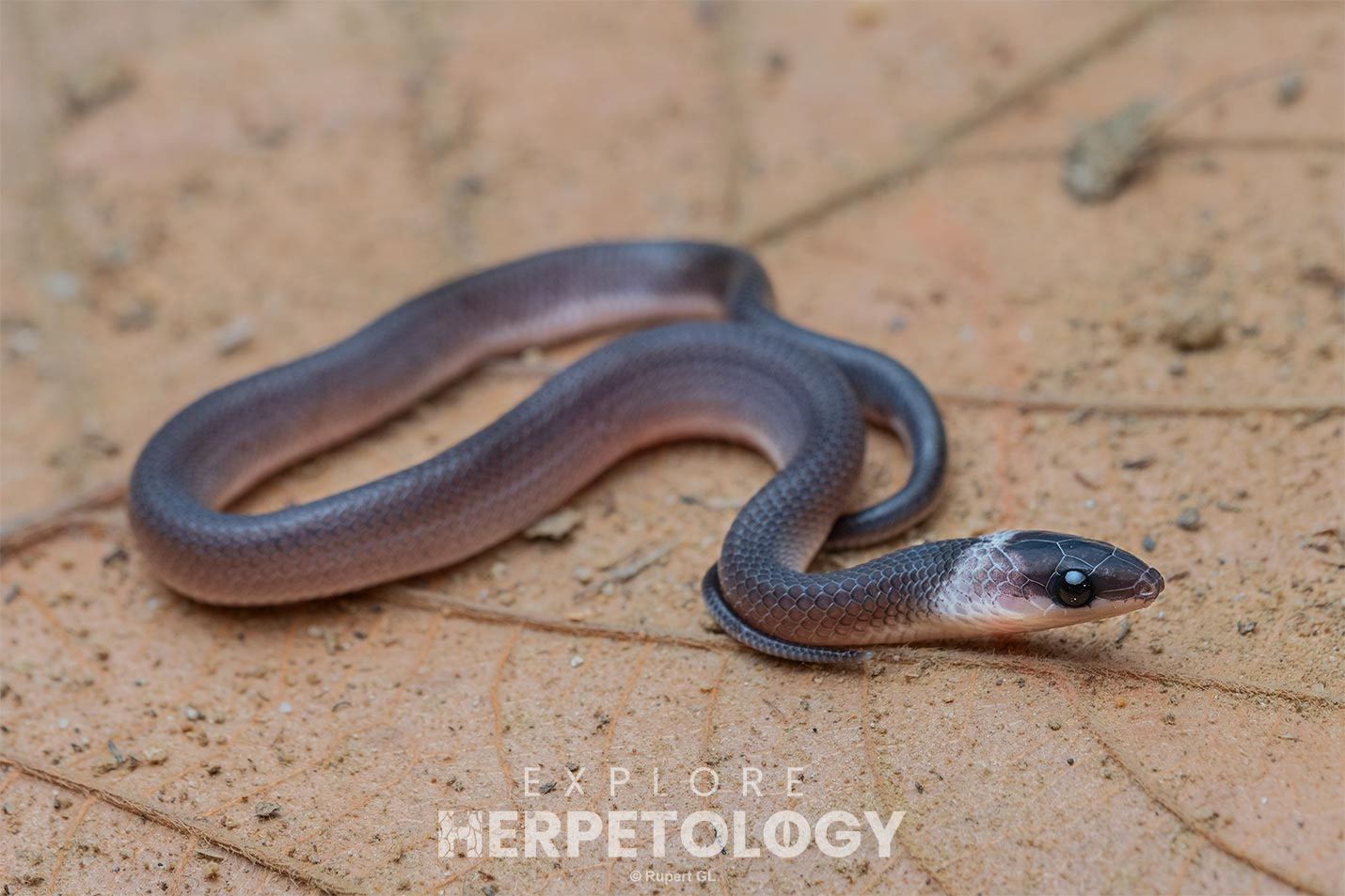
Philippine shrub snake (Oxyrabdion modestum)
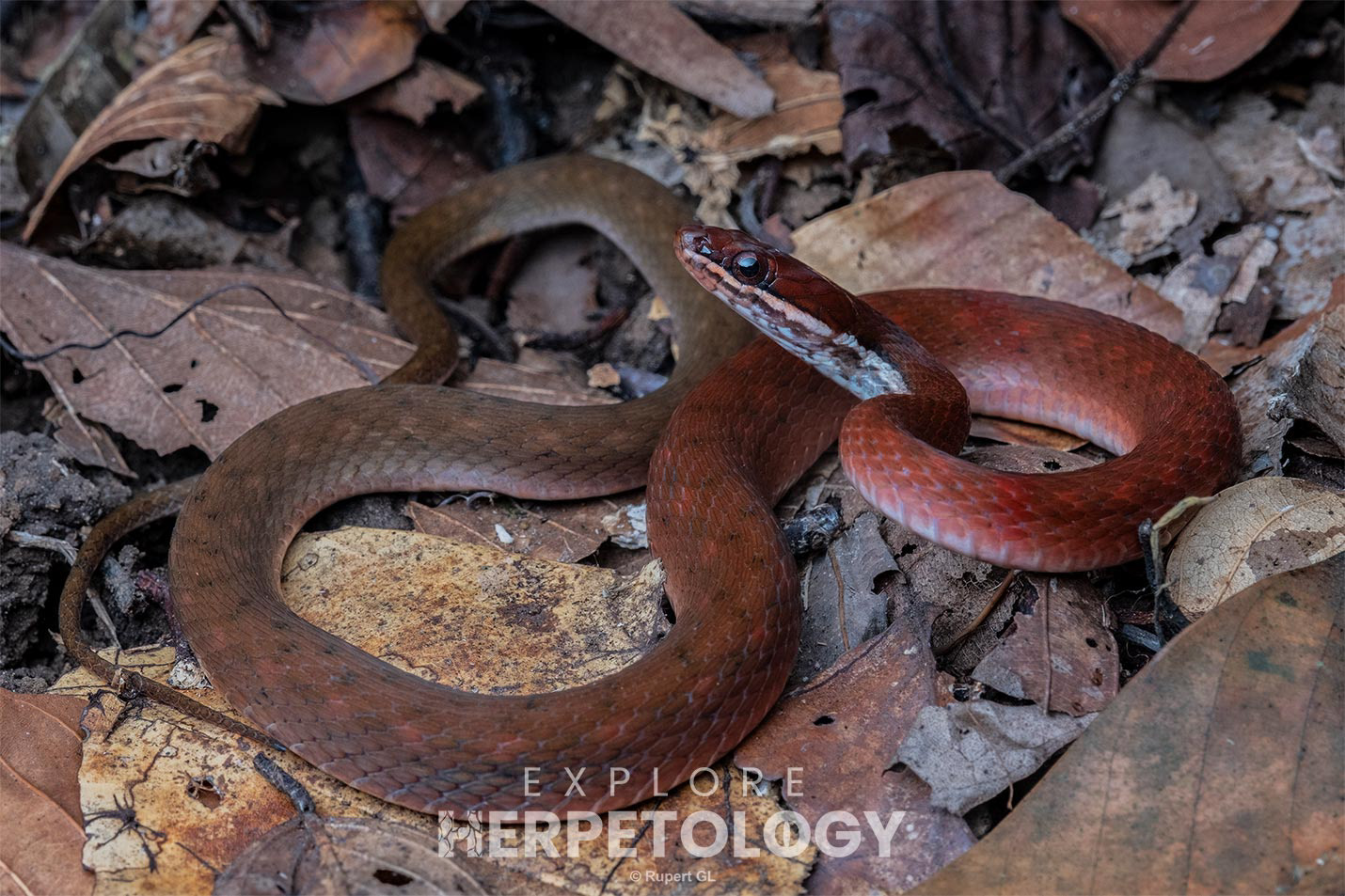
Zigzag-lined keelback (Rhabdophis lineatus)
Tawi-Tawi (Bongao)
Our destination was the island of Tawi-Tawi, on the far western side of the Sulu Archipelago. From the outside, the crystal clear seawater, palm trees and tropical forests makes these islands seem like a dream getaway for diving and seaside relaxation. However, Basilan, Jolo and Tawi-Tawi islands were used as transient guerrilla warfare bases by the ISIS-linked Abu Sayyaf group, the most infamous and violent of the extremist groups which terrorised the region - responsible for the largest terror attack in the history of The Philippines (MV Superferry in 2004) and most kidnappings/executions of foreigners. Due to this extremely dangerous group operating primarily out of the Sulu Archipelago, very few western tourists have ever visited this area.
The reason we are visiting such a remote and “dangerous” area stems back to a few cellphone photos posted in the Philippines snake ID groups over the previous 2 years, depicting a very strange black and yellow Tropidolaemus sp. from Tawi-Tawi and Jolo islands. Then, in early January, two local naturalists photographed an individual in higher quality from Bud Bongao peak. This caused a lot of discussion in the Philippines herpetology community, so we decided to catch the short flight from Zamboanga to Tawi-Tawi and investigate it in person.
To get to our hotel, we exited the world’s most scuffed airport (the check-in counters are inside a wooden shack with a tin roof) and commandeered two tricycle taxis. We had been informed at the foreign tourist check-in booth that it is “safe here, we don’t need to carry guns”, but all around us upon exiting the airport were heavily armed military personnel. Regardless, the atmosphere on the island was indeed very relaxed with the military men, locals and airport staff full of smiling faces practically falling over each other to offer assistance.
We liaised with a contact we had established beforehand, a guy called ‘Shams’ who had seen the viper multiple times on some farmland he owned on Tawi-Tawi. He had been very enthusiastic to help us, and through a patchy internet connection had informed us he would pick us up from our hotel at midday. We expected Shams to arrive with scooters or a tricycle similar to our taxi, but we were nothing but shocked when he pulled up with his entourage of eager friends in a discontinued ambulance (a modified Toyota Hilux) and told us to jump inside. Our first stop, the mosque.
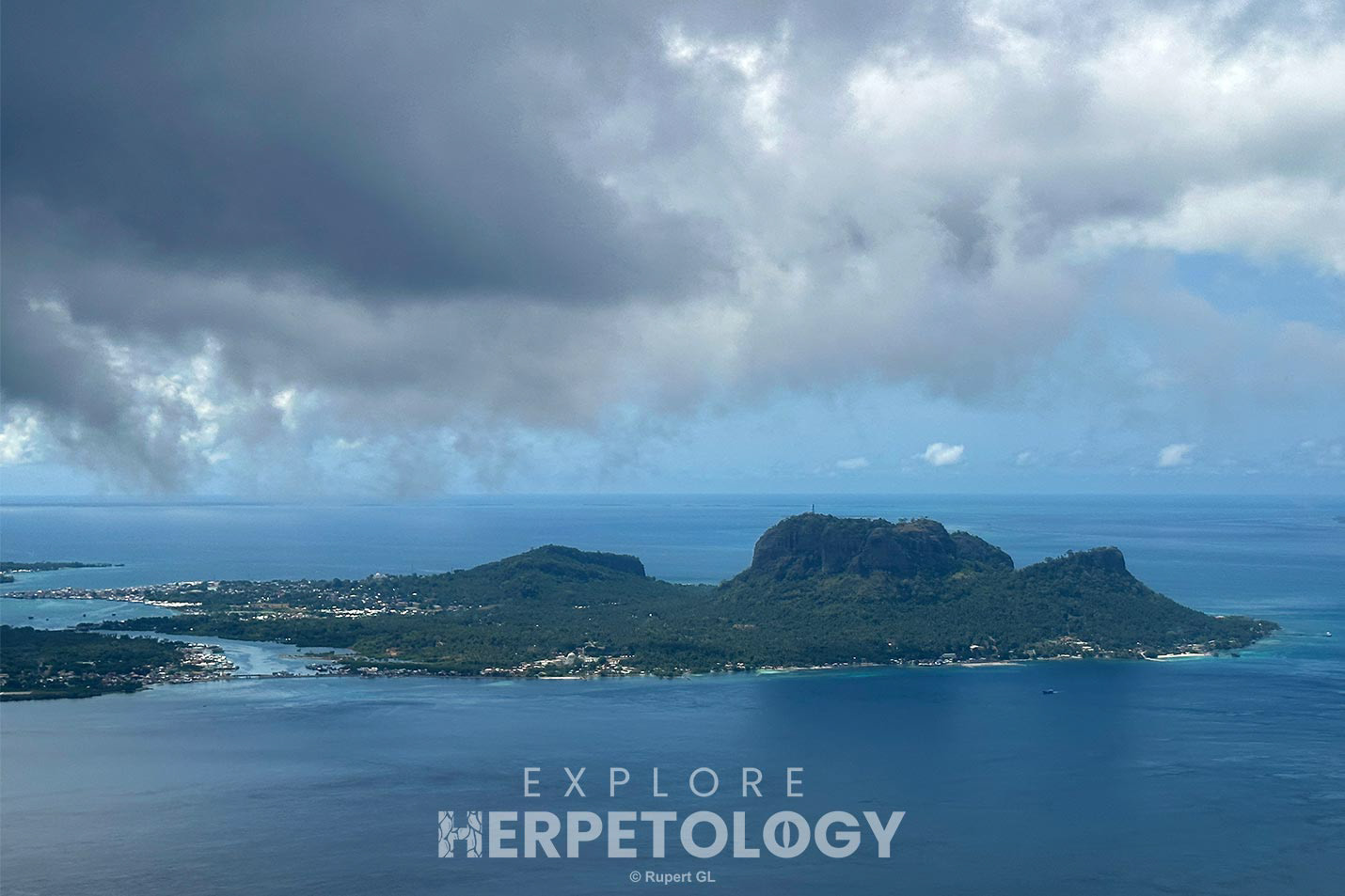
Bongao Island in far western Tawi-Tawi.
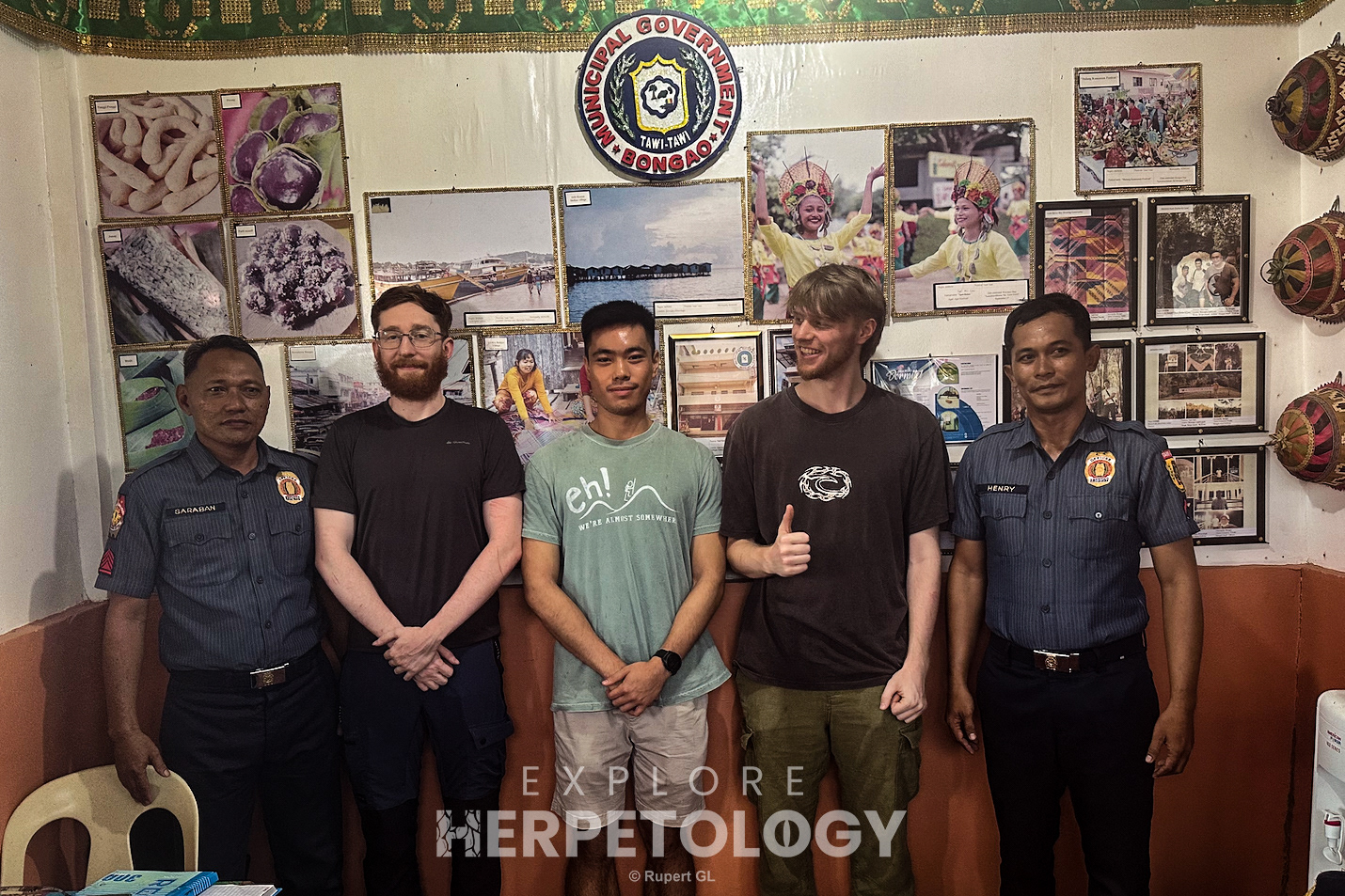
Tourist check-in.
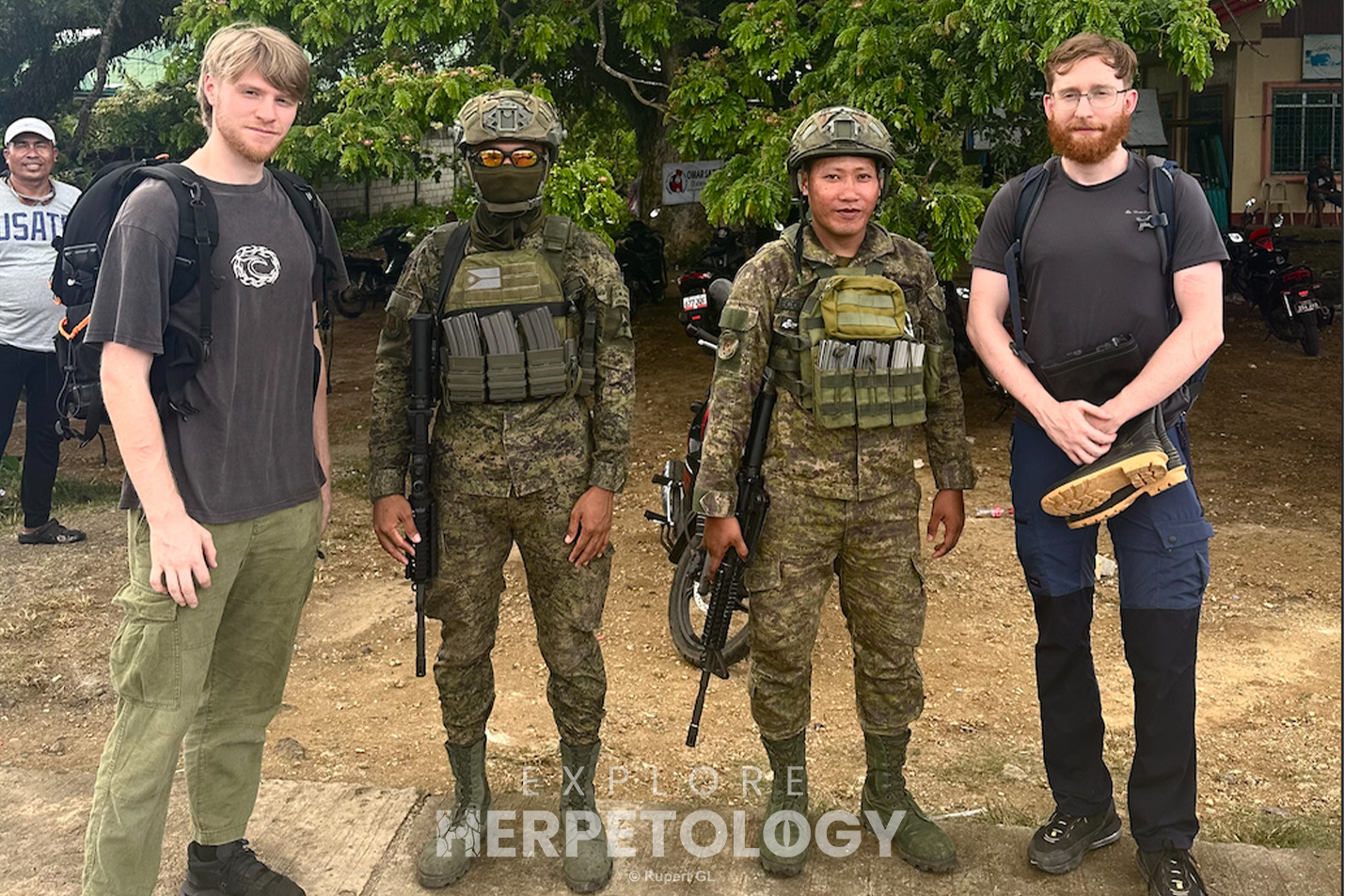
Military personnel outside the airport.
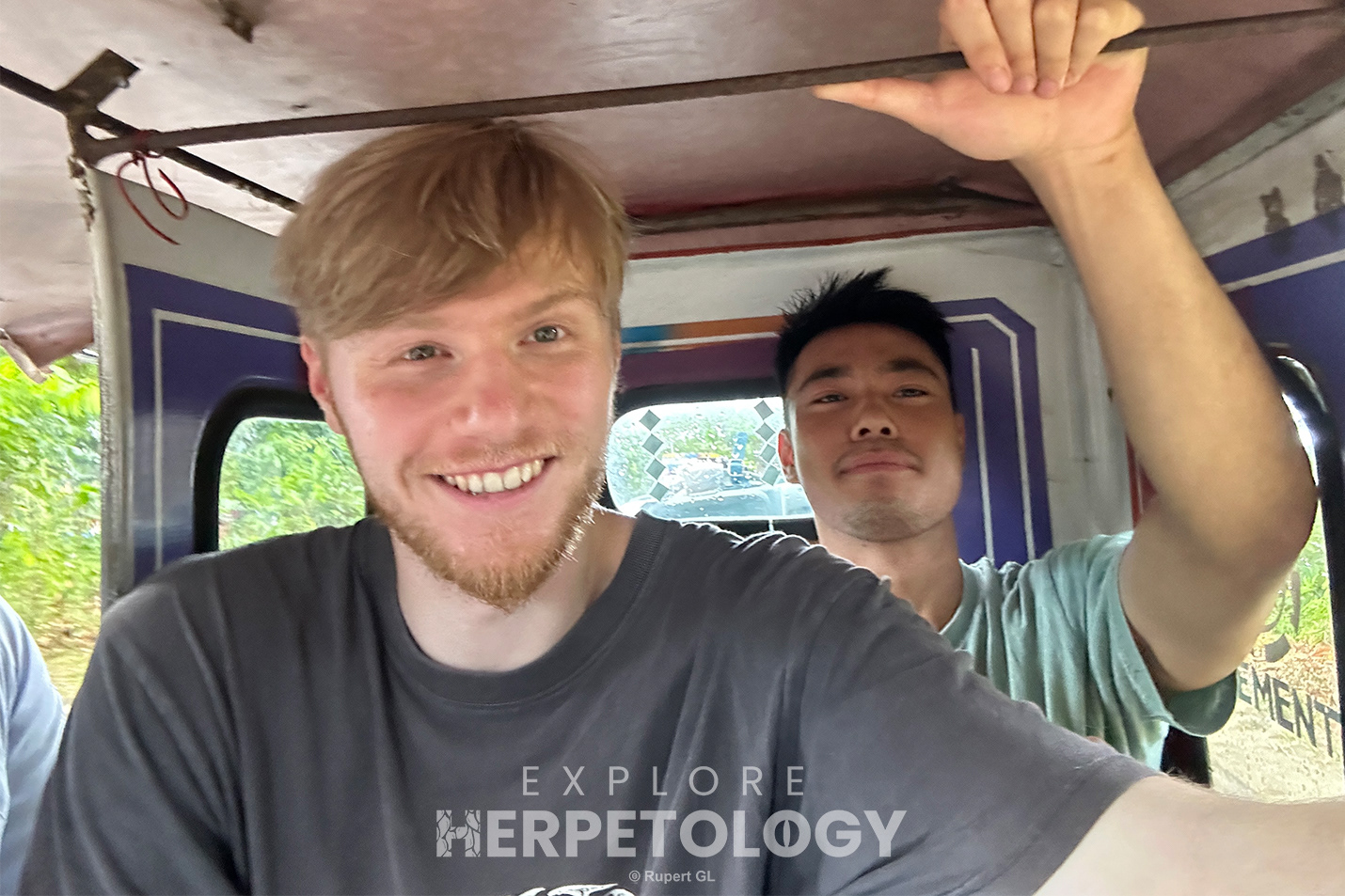
Trike ride to our hotel.
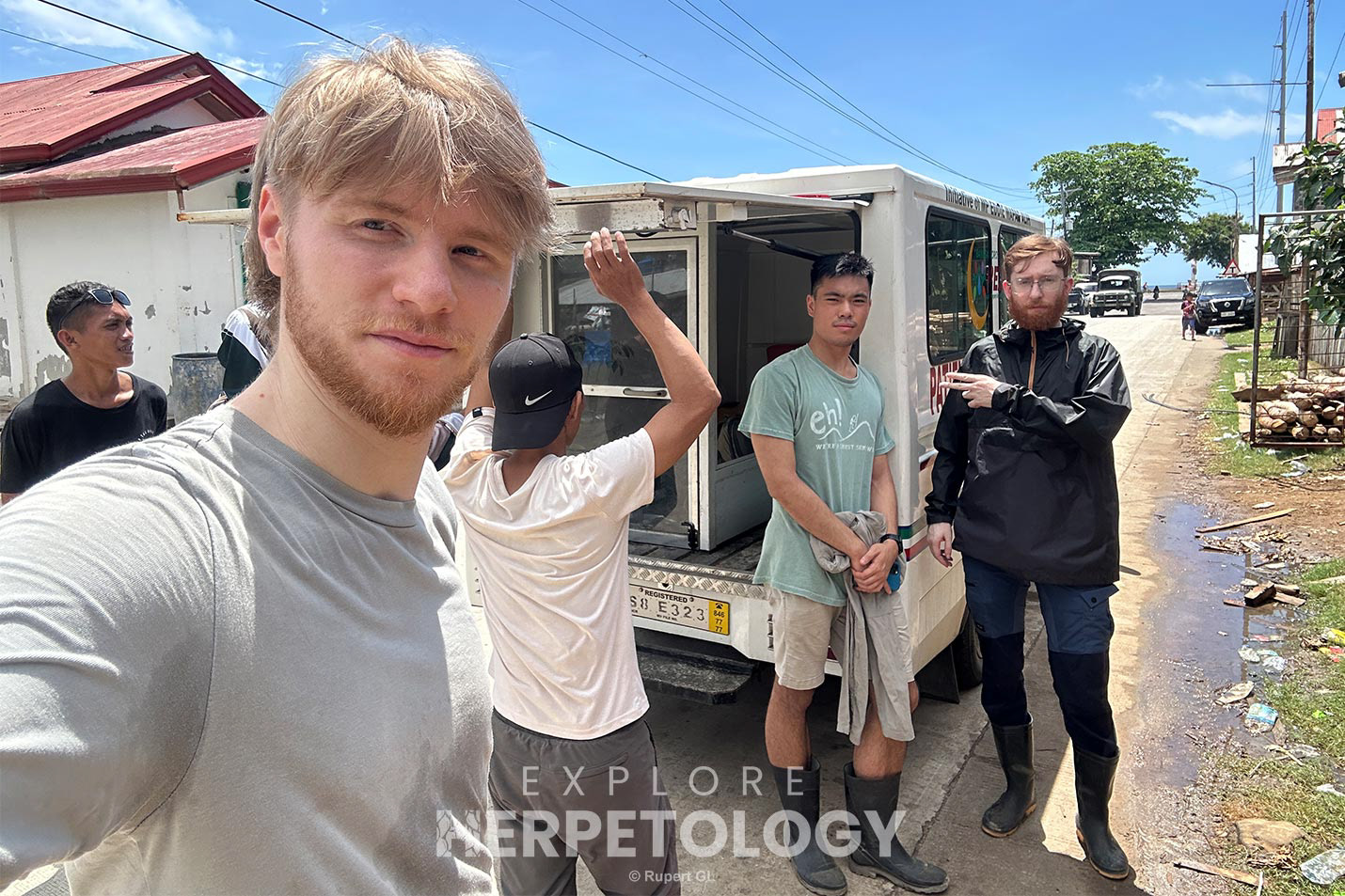
'The sweatbox' which needed a push-start every time we needed to go somewhere.
After observing prayer at the beautiful Central Mosque of Tawi-Tawi, we once again climbed into the back of the ‘ambulance’ and began a 50 kilometer drive far out onto the mainland of Tawi-Tawi, to a spot where Shams had recently seen a large female. The heatwave which was afflicting the rest of The Philippines was not absent here, and the small air conditioning unit in the back of the truck was like pissing on a house fire. By the time we arrived at our first herping location, we were as sweaty as if we had hiked there and the ambulance had been christened “the sweatbox”. This area was actually not where Shams had seen the viper, but a farm belonging to a friend from which there had been many viper observations by the workers. Not needing to be told twice, we jumped out of the sweatbox equipped with handguns, machetes and snake hooks (looking like something from Far Cry 3) and began searching.
Following the trend of exceptional first-day success on a field trip we had already nicknamed ‘the perfect script’, it took merely 10 minutes before I marauded into some dense vegetation and spotted the holy grail resting in a low shrub; a simply giant (and gravid) adult female of our target Tropidolaemus, which we will henceforth refer to as Tropidolaemus cf. subannulatus. This snake completely blew our minds, everything and more than we could have hoped for. Our cohort (of around 15 people at this point) was equally ecstatic, frequently exclaiming “alhamdulillah!” and occasionally breaking into an Ed Sheeran song or two.
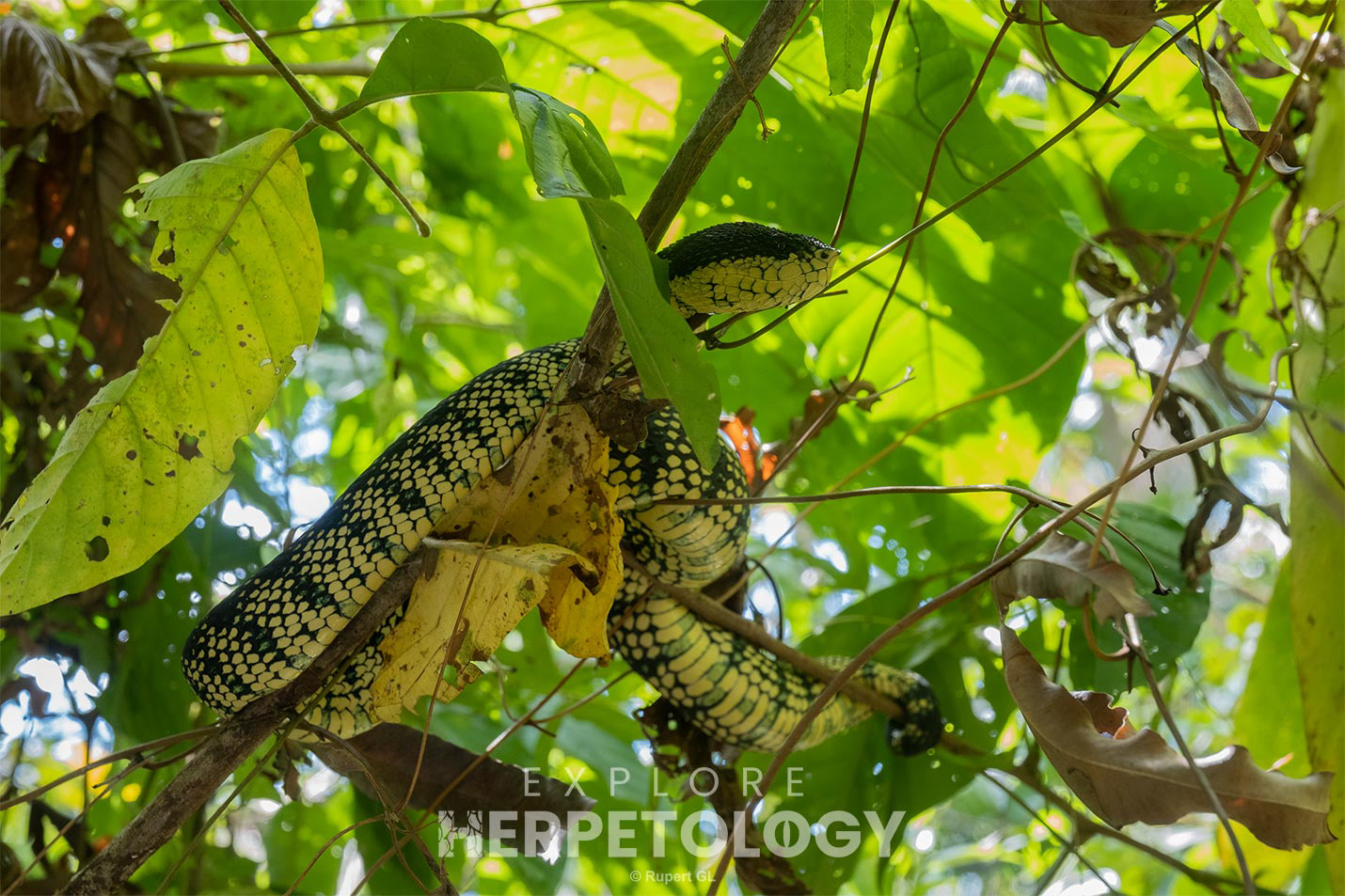
In-situ (as found).
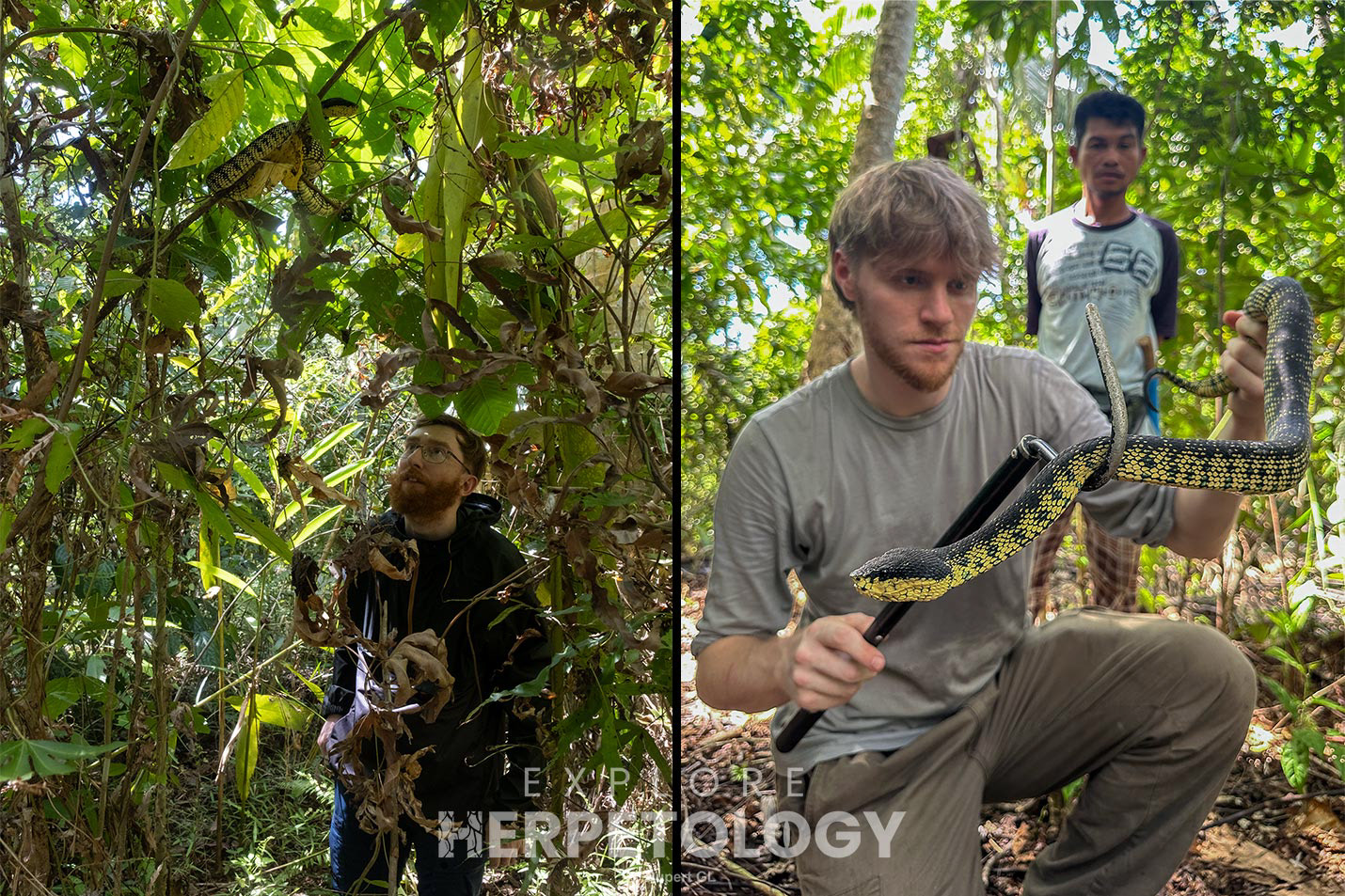
One hell of a snake.
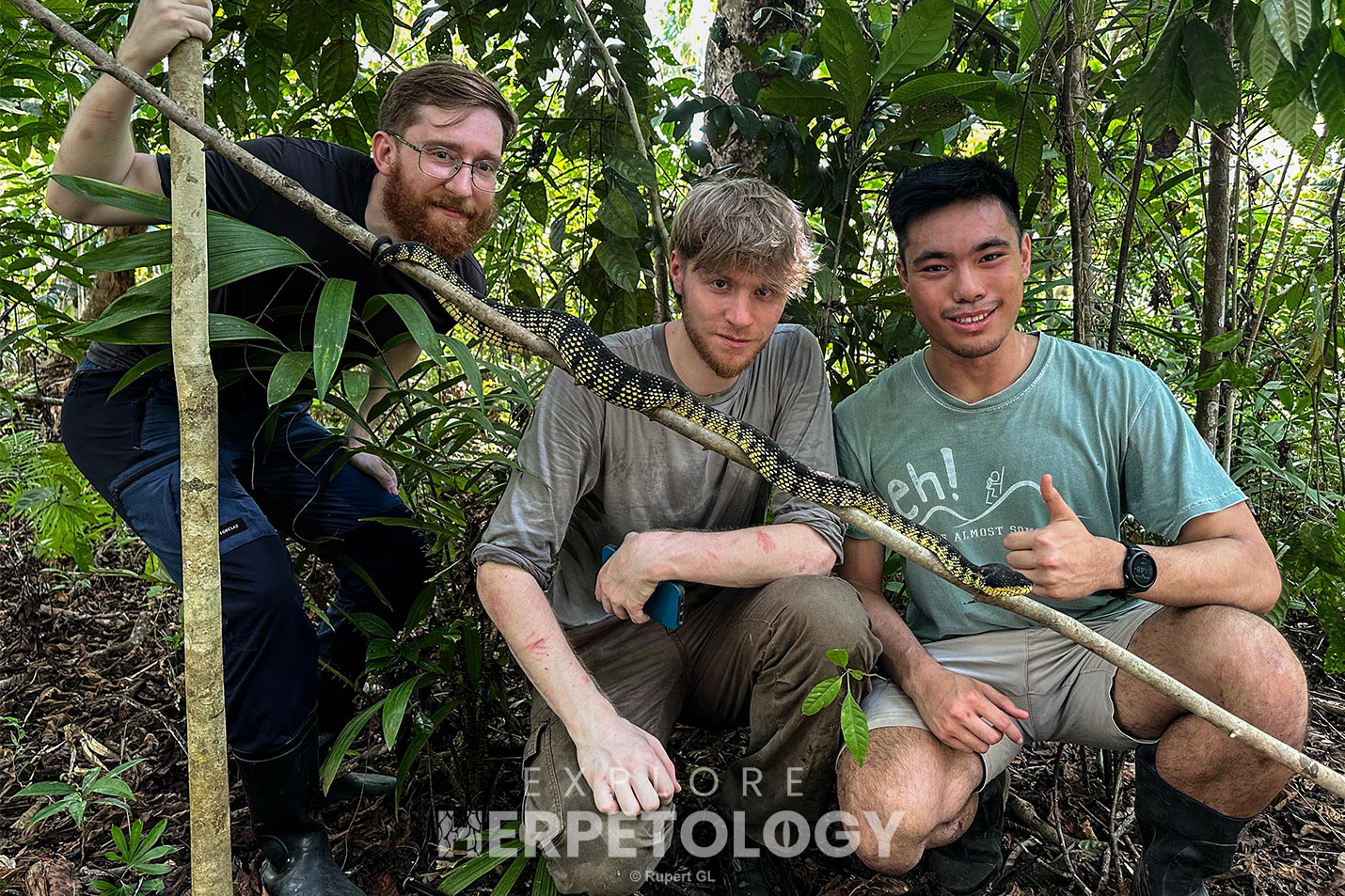
Group pic.
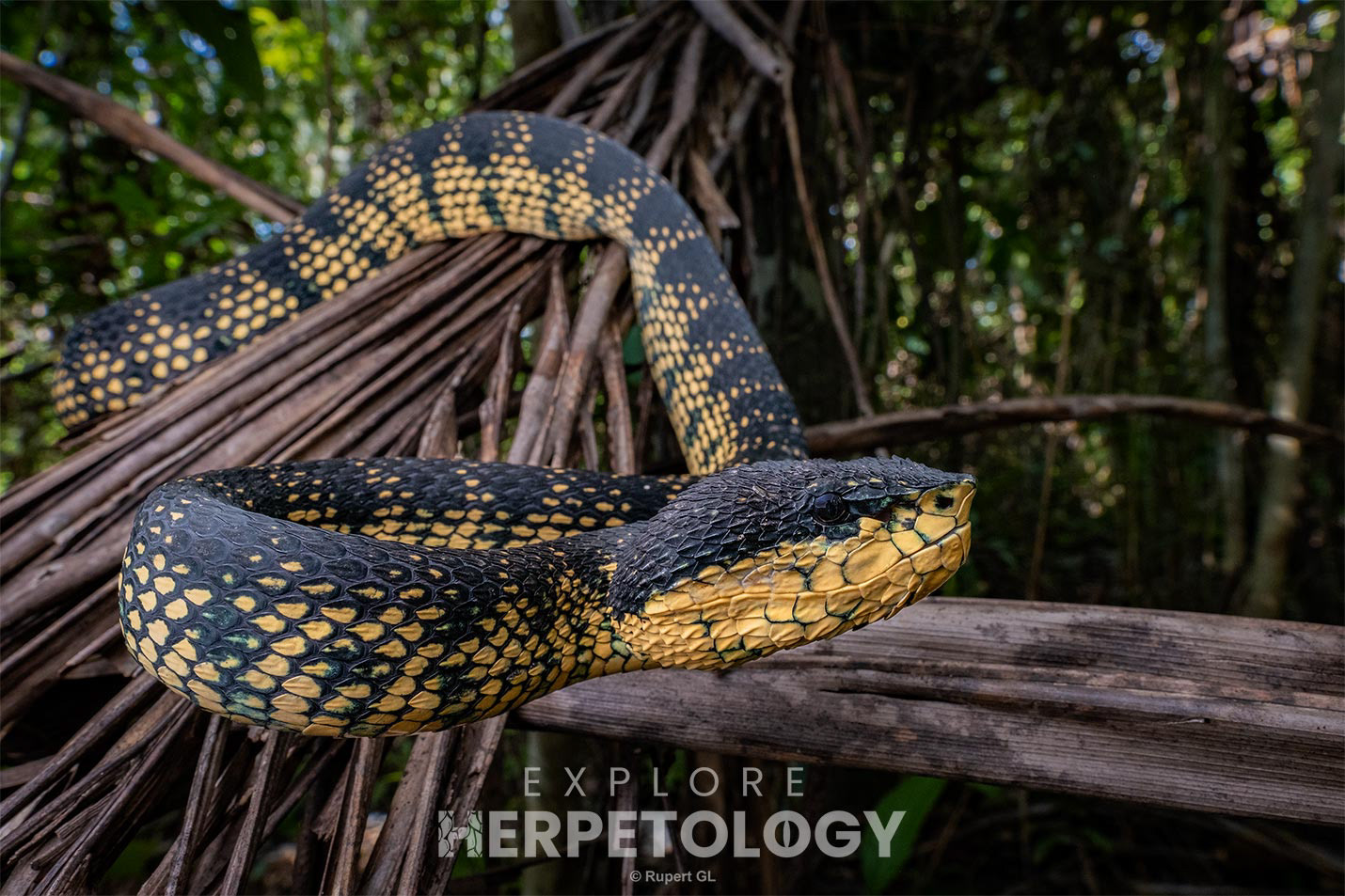
Adult female Tropidolaemus cf. subannulatus
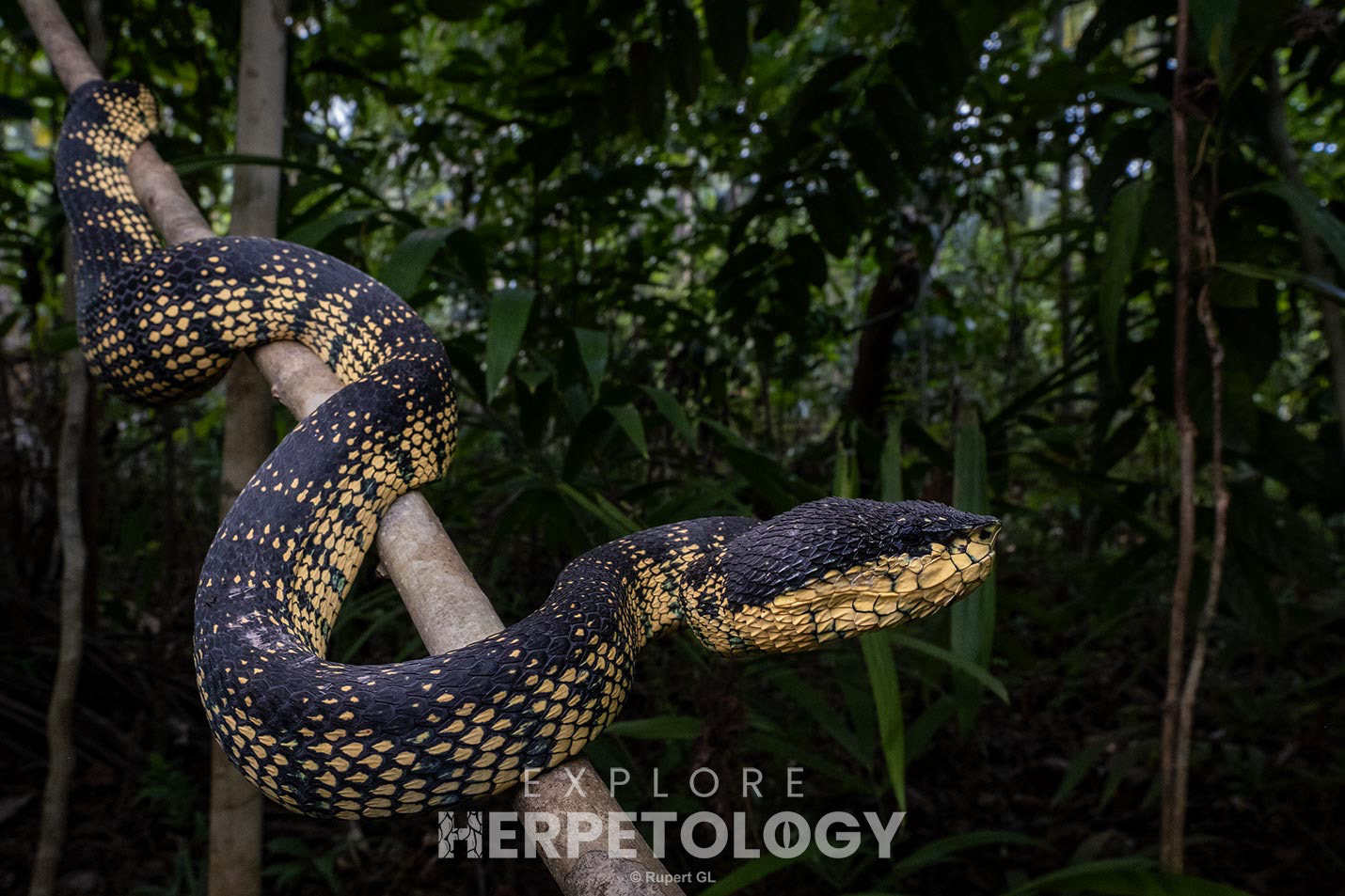
Adult female Tropidolaemus cf. subannulatus
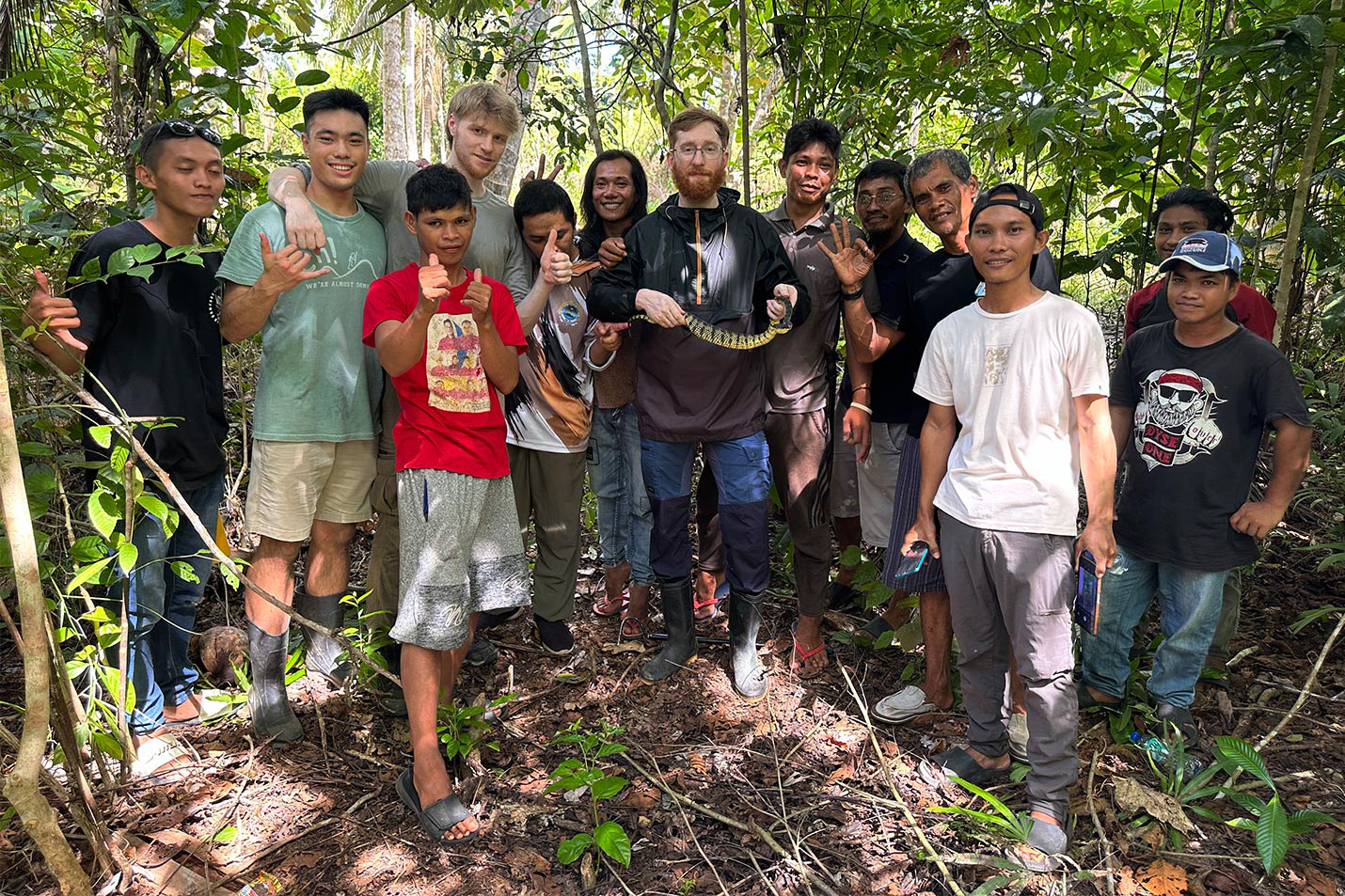
Bigger group pic!
I was enamored not just by the snake, but by the locals' interest and willingness to learn. Shams had already educated the workers that they should not kill snakes, and we further added value by sharing as much information about the ecology and biology of these vipers as possible, answering a myriad of questions. Once our photography and examination of the snake was complete, we set her back on the exact branch she was retrieved from and began the journey back to our hotel.
En-route, Shams brought us to a seaside market on the Tawi-Tawi mainland and informed us that they still barter for goods here, trading fruit for fish and other combinations of value exchange. Cash is still accepted, but it is rare to encounter a trading relic like this in modern times. Fresh coffee and local delicacies (such as banana bread and other various decomposition-resistant amalgamations of coconut and banana) were eagerly consumed. Keith and I offered to exchange Alex for these treats, but Shams took care of payment using more conventional means.
We met back up with Shams and Co. for dinner, joined this time by ‘Abs’ and ‘Moukz’, the two local naturalists who had photographed the sub-adult female on Bud Bongao peak back in January 2024. We discussed our plans for the following day, and they informed us that they could organise permits to explore the forest of Bud Bongao at night if we gave them a day. This was something we were extremely keen on, and thus the plan for tomorrow was agreed. After dinner, we walked down by the coast and found one single yellow-lipped sea krait (Laticauda colubrina) amongst some rocks.
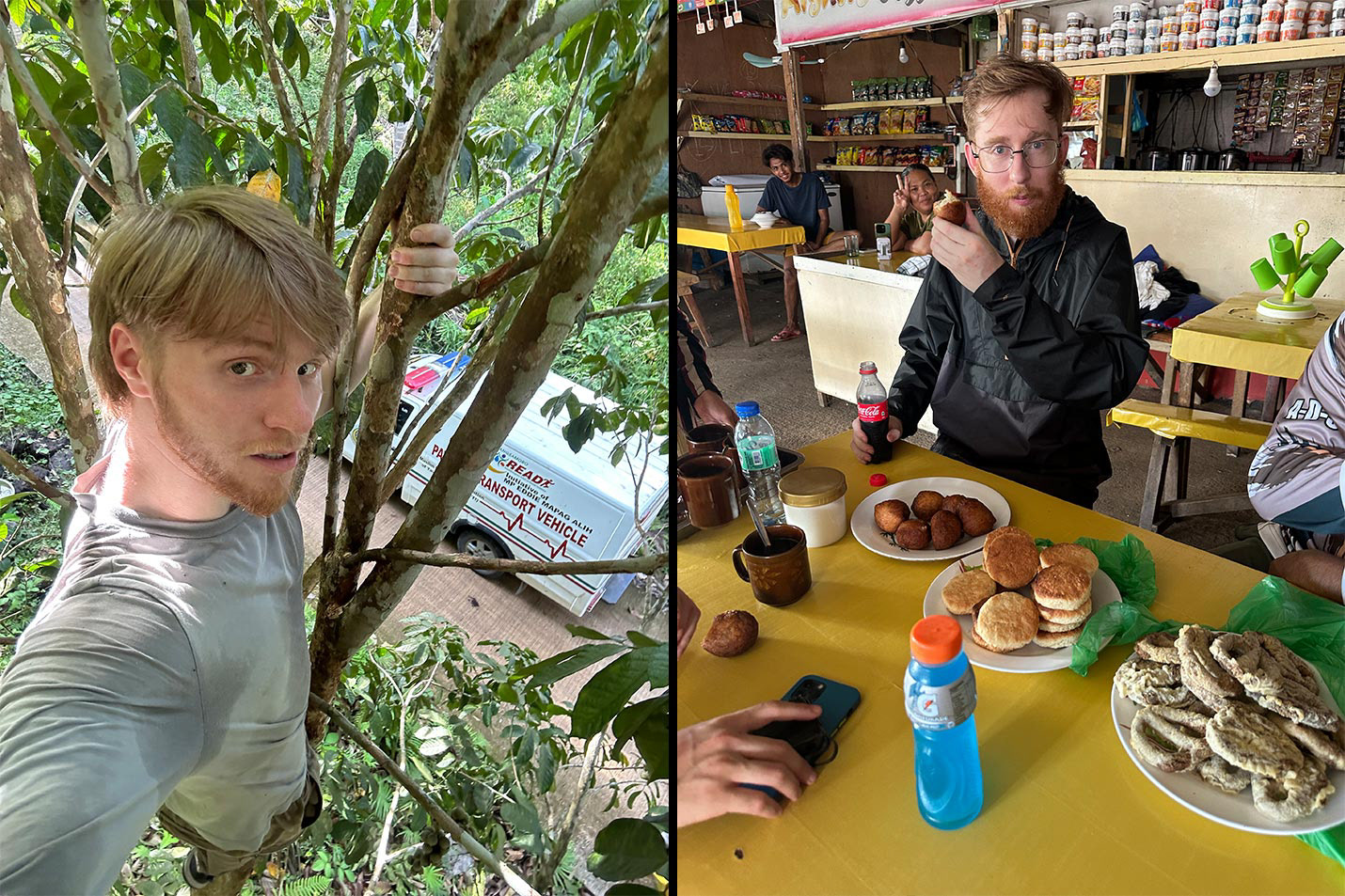
Left: Climbing trees to search for Tropidolaemus. Right: Local snacks.
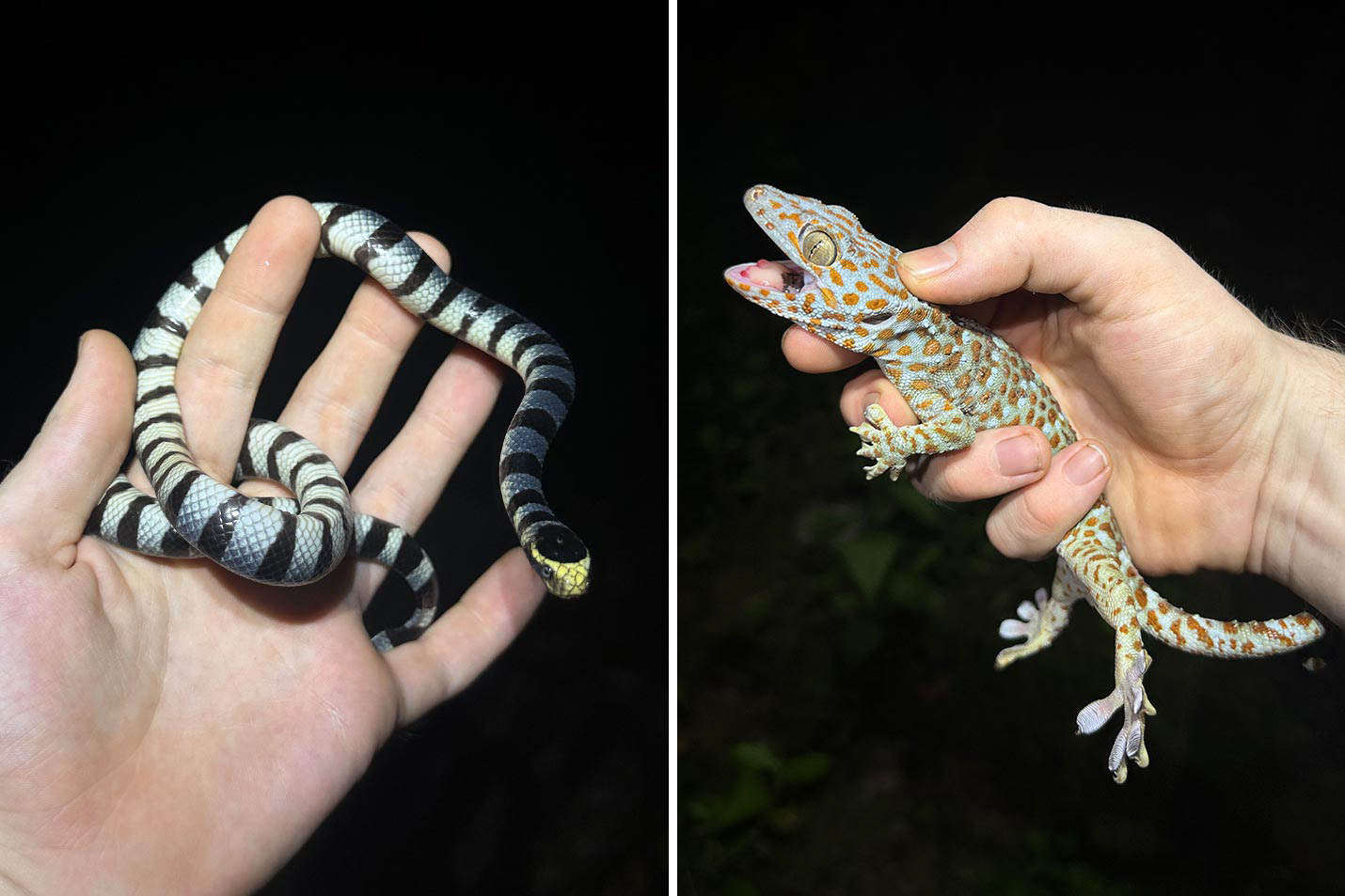
Left: Laticauda colubrina. Right: Gekko gecko.
Come 5pm the next day, we linked back up with our group of local friends and undertook the much shorter drive to the base of Bud Bongao, where we had dinner and signed some permits to access the forest. Bud Bongao is an impressive limestone hill which rises high above Bongao Island, on the far west of Tawi-Tawi. Here, there is a well maintained trail which runs from the base to the very top.
It was steep and sweaty, but we quickly saw several Sulu vine snakes (Ahaetulla prasina suluensis) and a young male individual of the Sulu clade Tropidolaemus cf. subannulatus, which appeared quite similar to typical males of Tropidolaemus subannulatus, except the spots on the dorsum were blue.
There is a larger expanse of accessible forest at the top of the limestone hill, where we saw several more snakes. This included multiple more small male Tropidolaemus and juvenile female. We saw two Maren’s bronzebacks (Dendrelaphis cf. marenae), as well as a Philippine brown ratsnake (Coelognathus erythraeus philippensis) which was drinking from the last remaining pool of water. The total number of vine snakes was around 15 at this point. However, it was not until almost midnight, when our group was descending from the peak, that we found what we were hoping for. High up a tree was a subadult (transition phase) female Tropidolaemus cf. subannulatus - very similar to the one observed here by Abs and Moukz back in January! The final chapter to the perfect script.
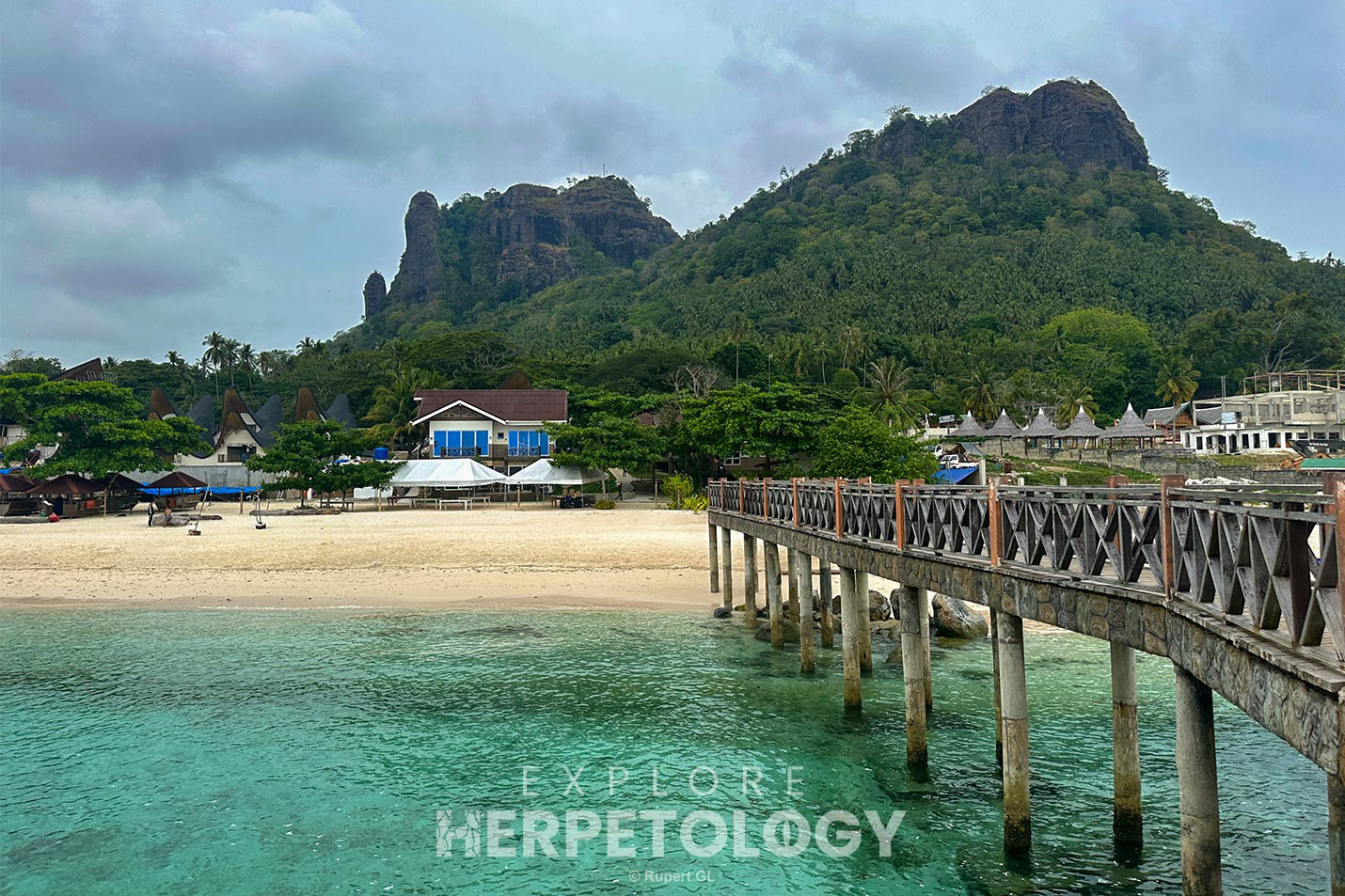
Our herping destination for the night.
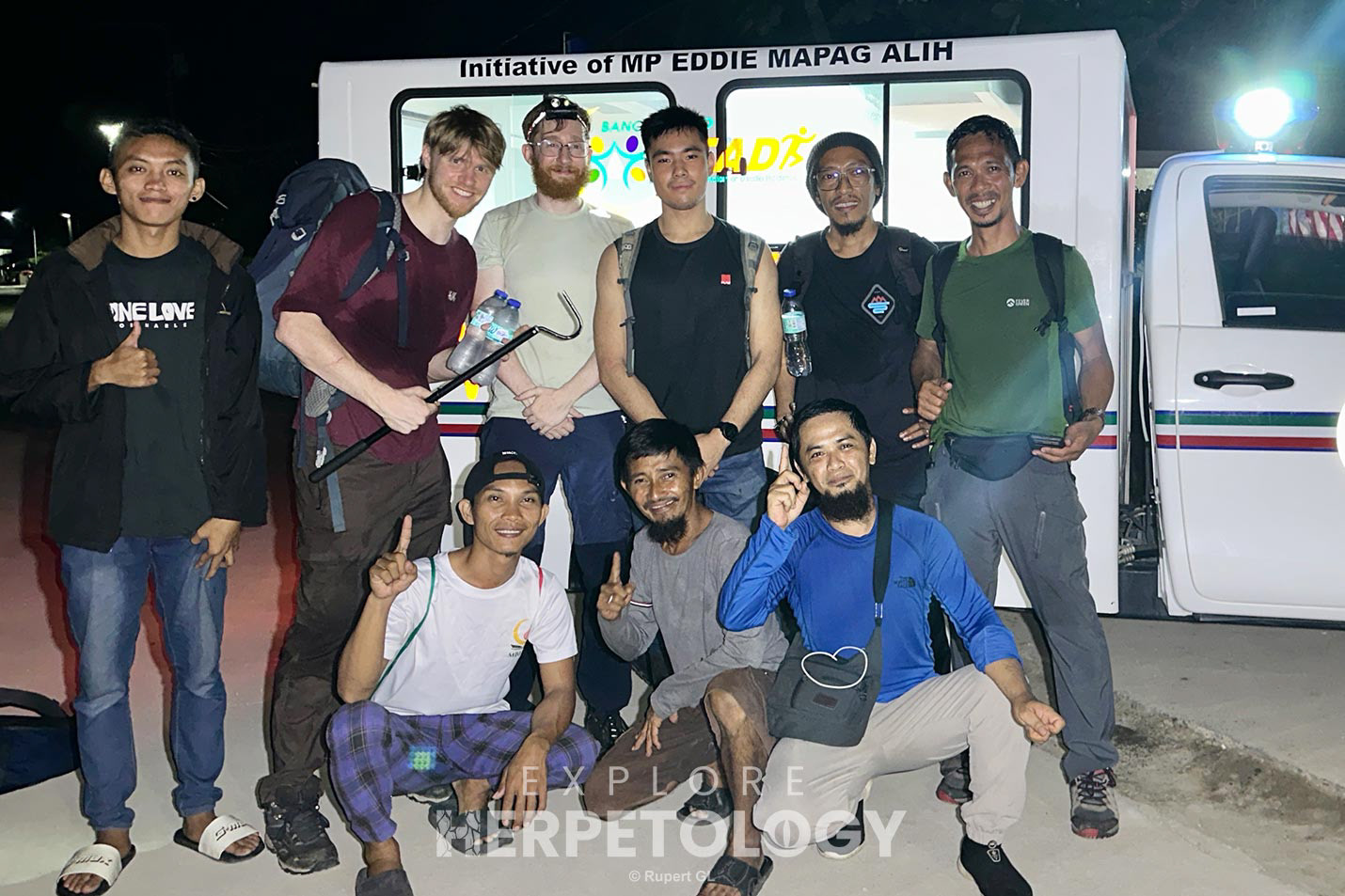
The team and the sweatbox!
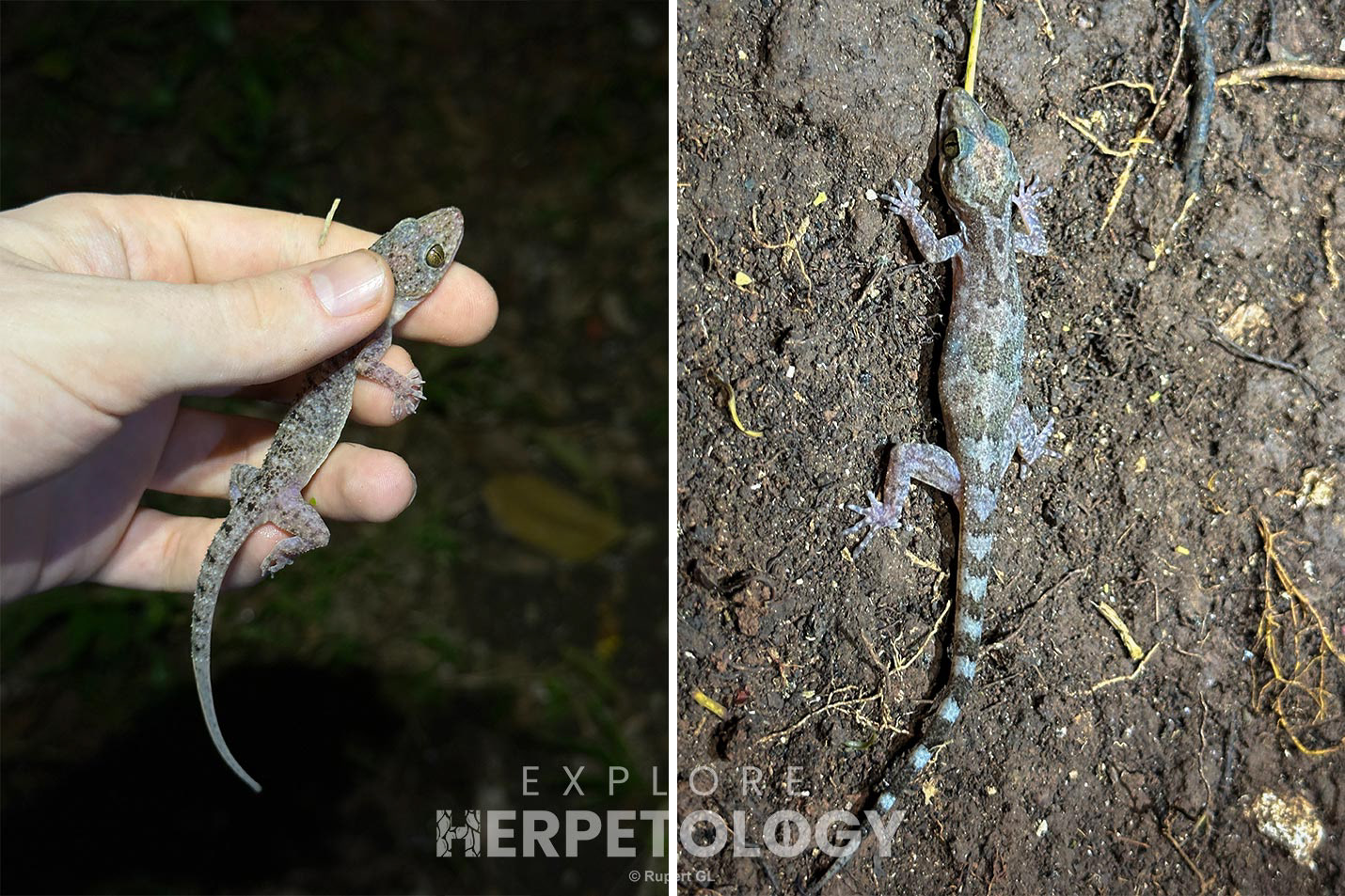
Two unidentified geckos.
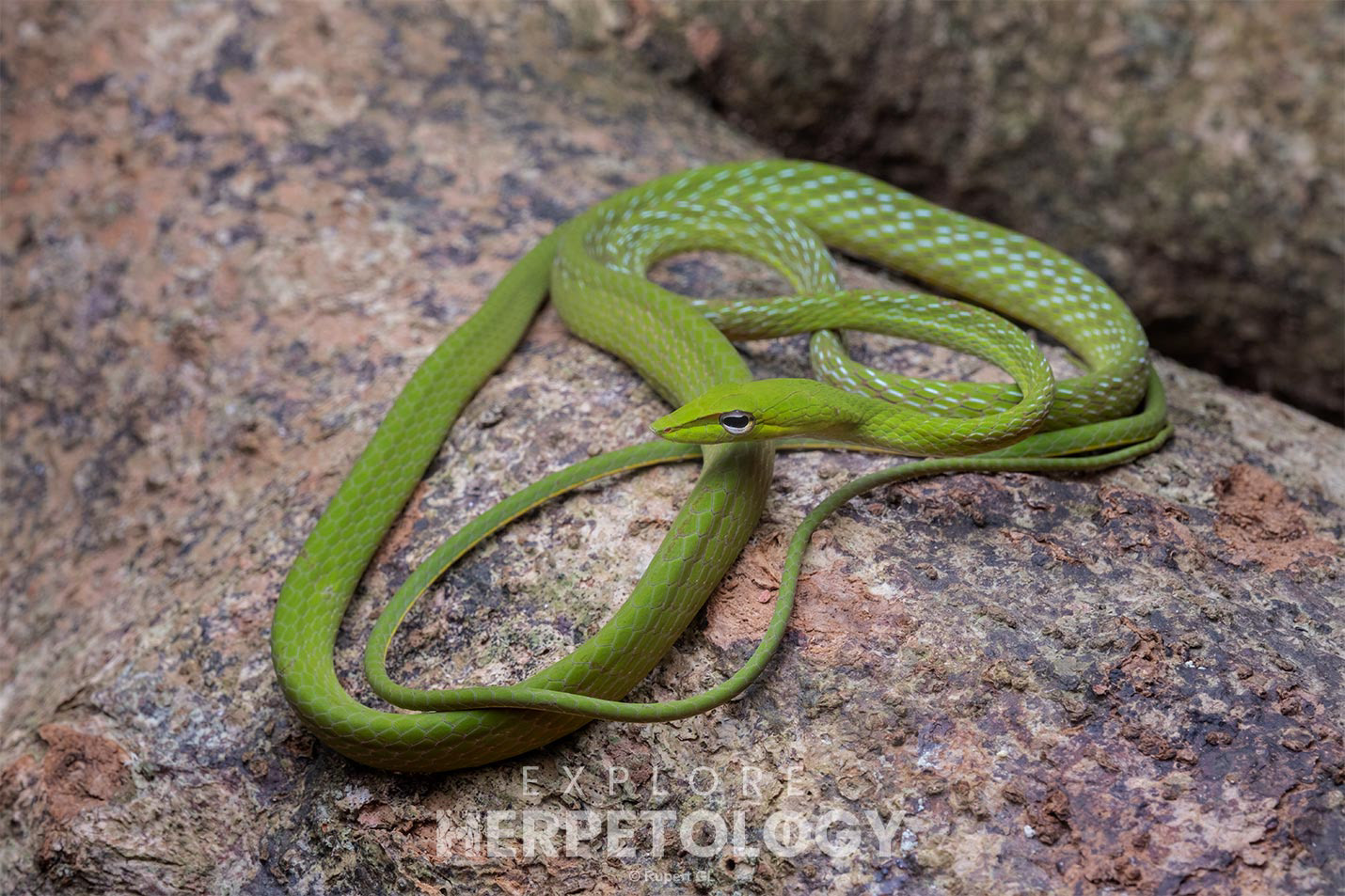
Sulu vine snake (Ahaetulla prasina suluensis)
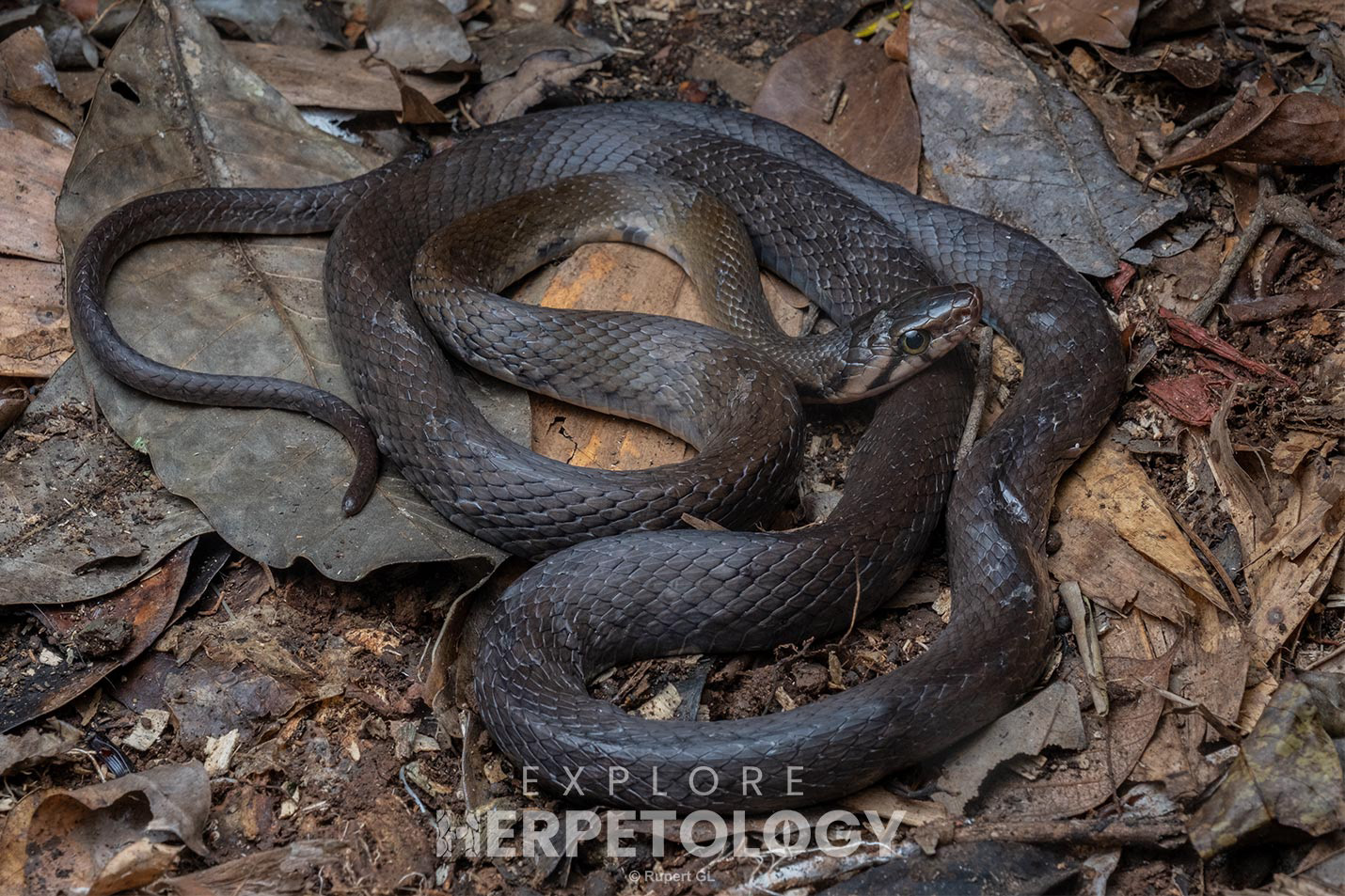
Philippine brown rat snake (Coelognathus erythraeus)
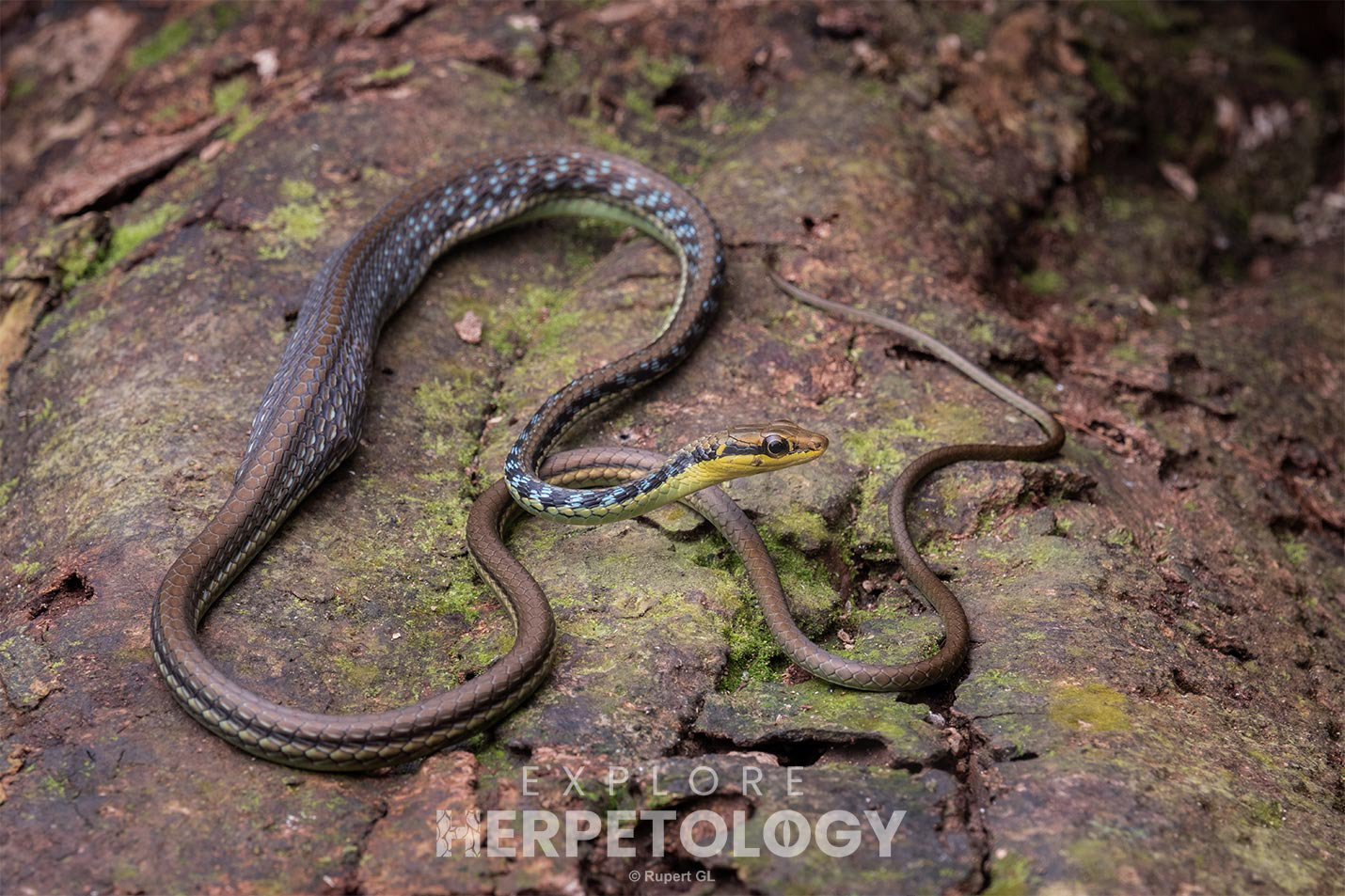
Maren's bronzeback (Dendrelaphis cf. marenae)
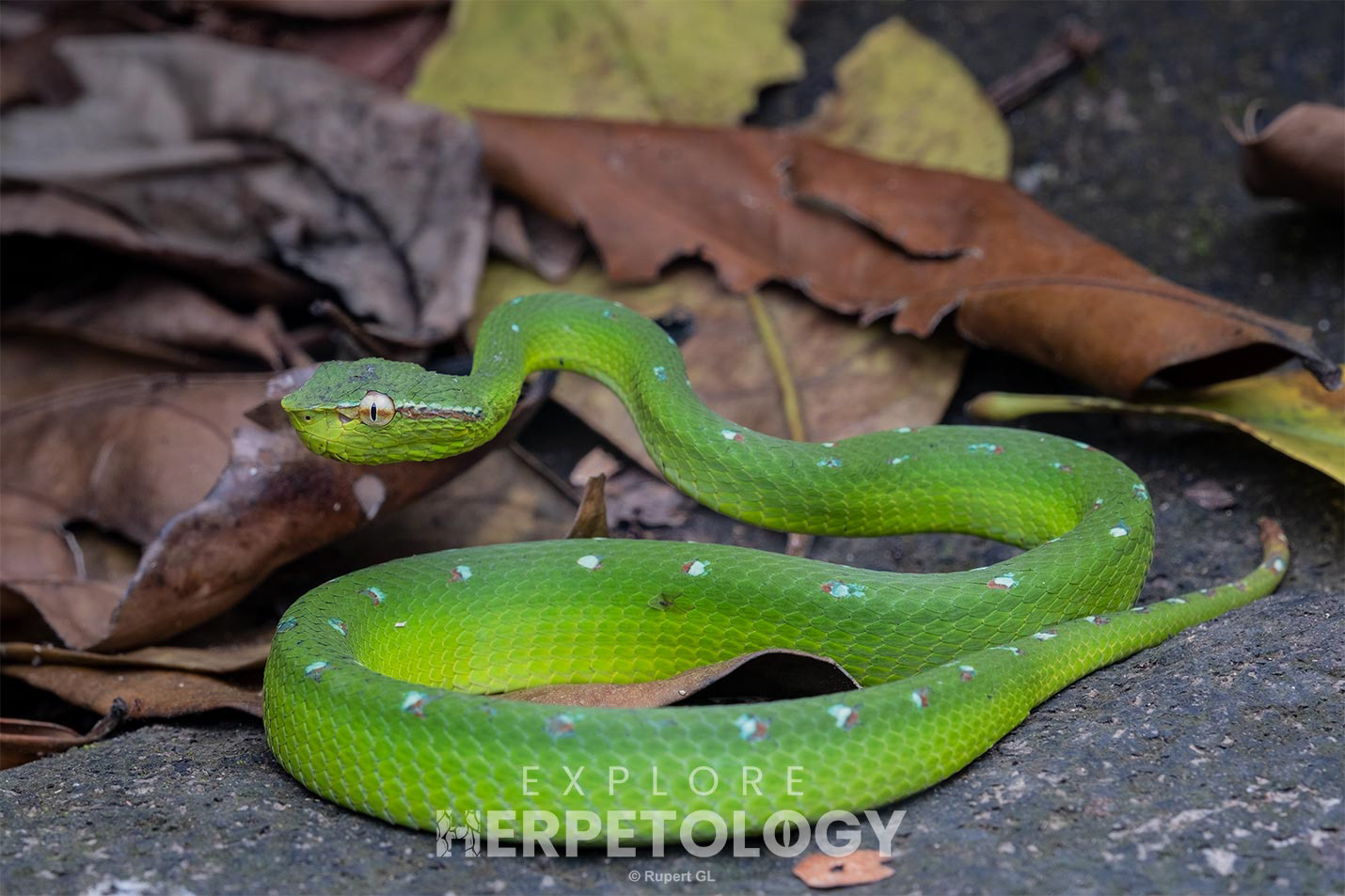
Male Sulu clade Tropidolaemus cf. subannulatus
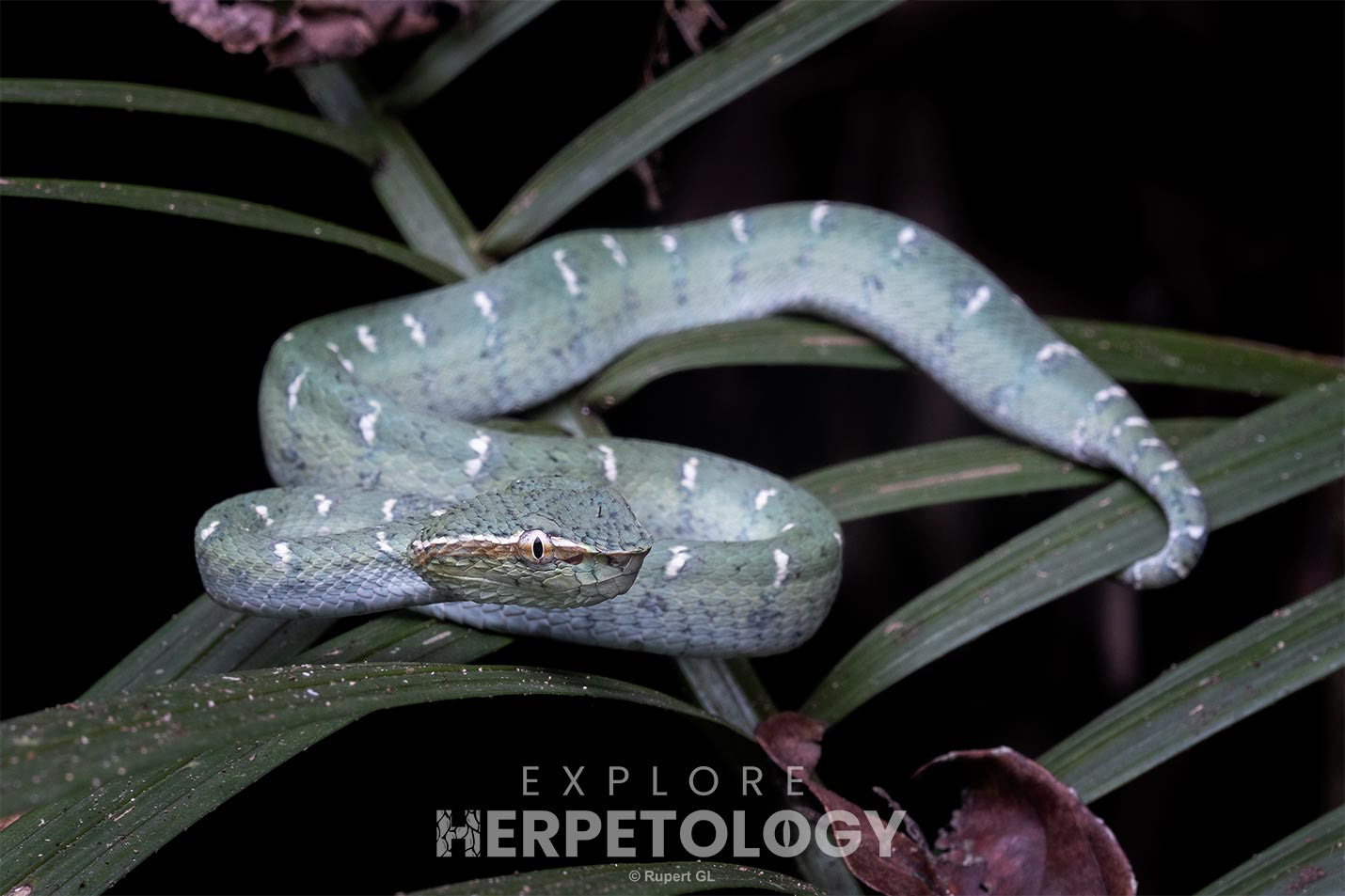
Juvenile female Tropidolaemus cf. subannulatus
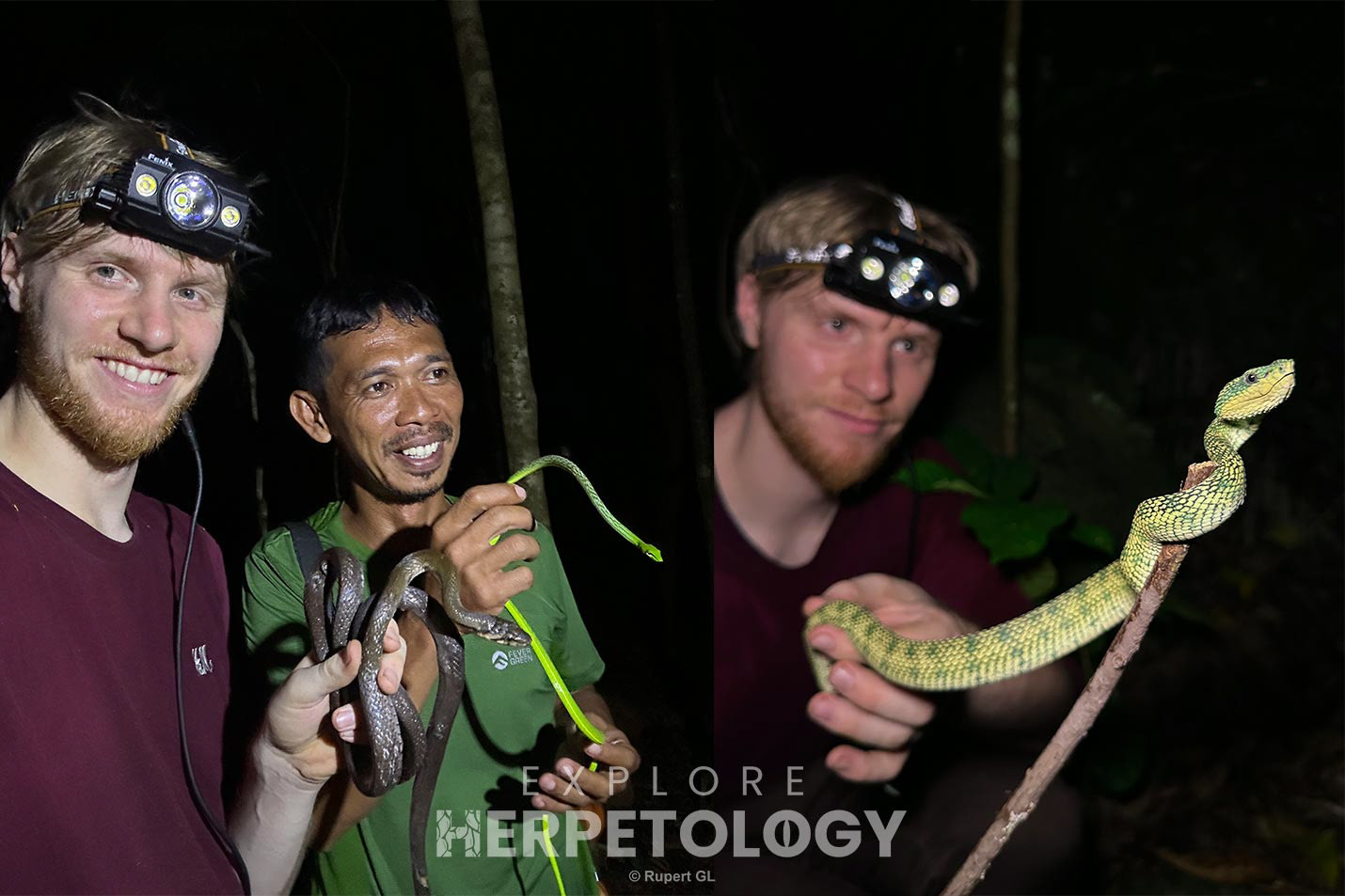
A couple handling shots.
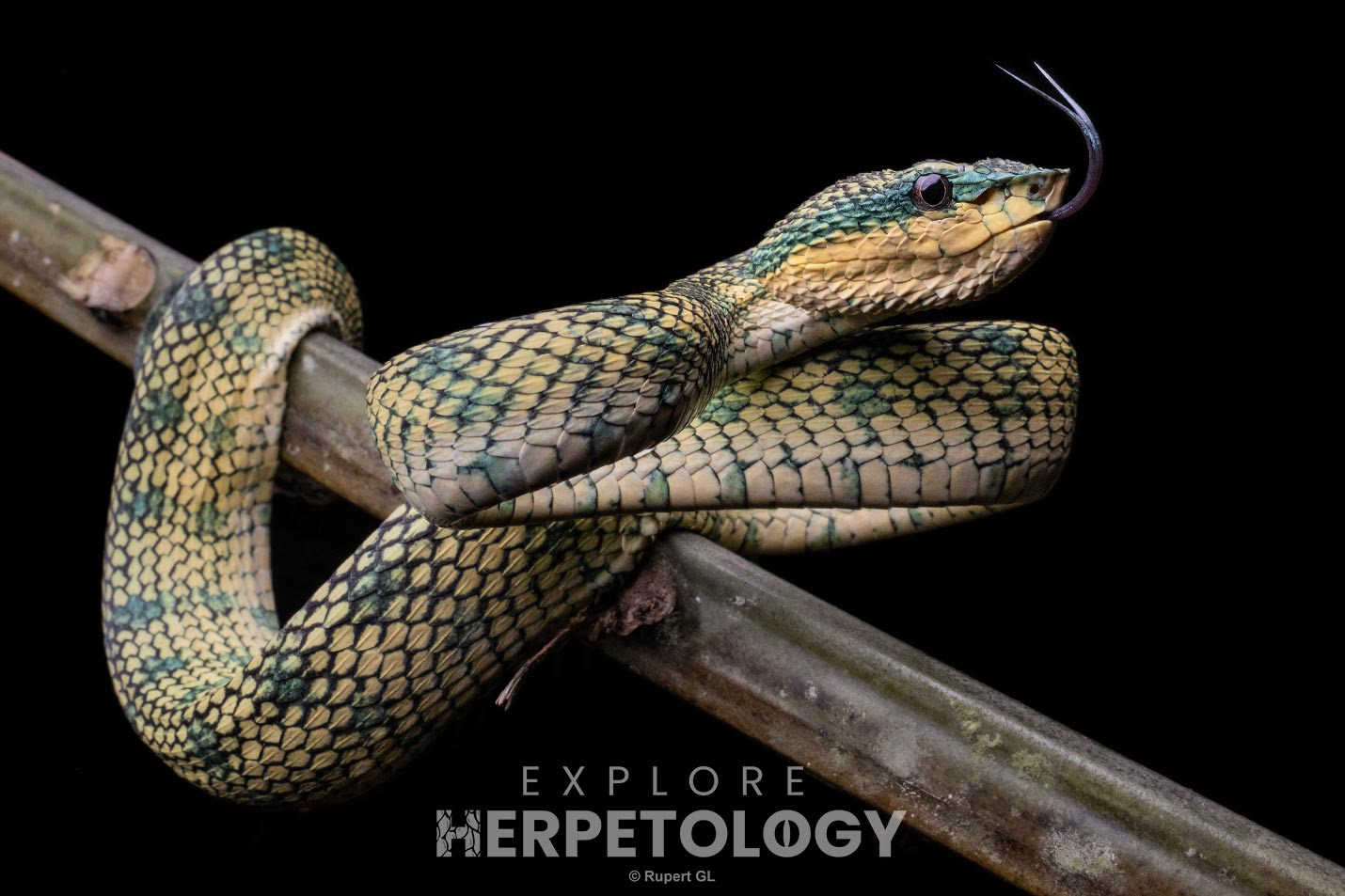
Subadult female Sulu clade Tropidolaemus cf. subannulatus
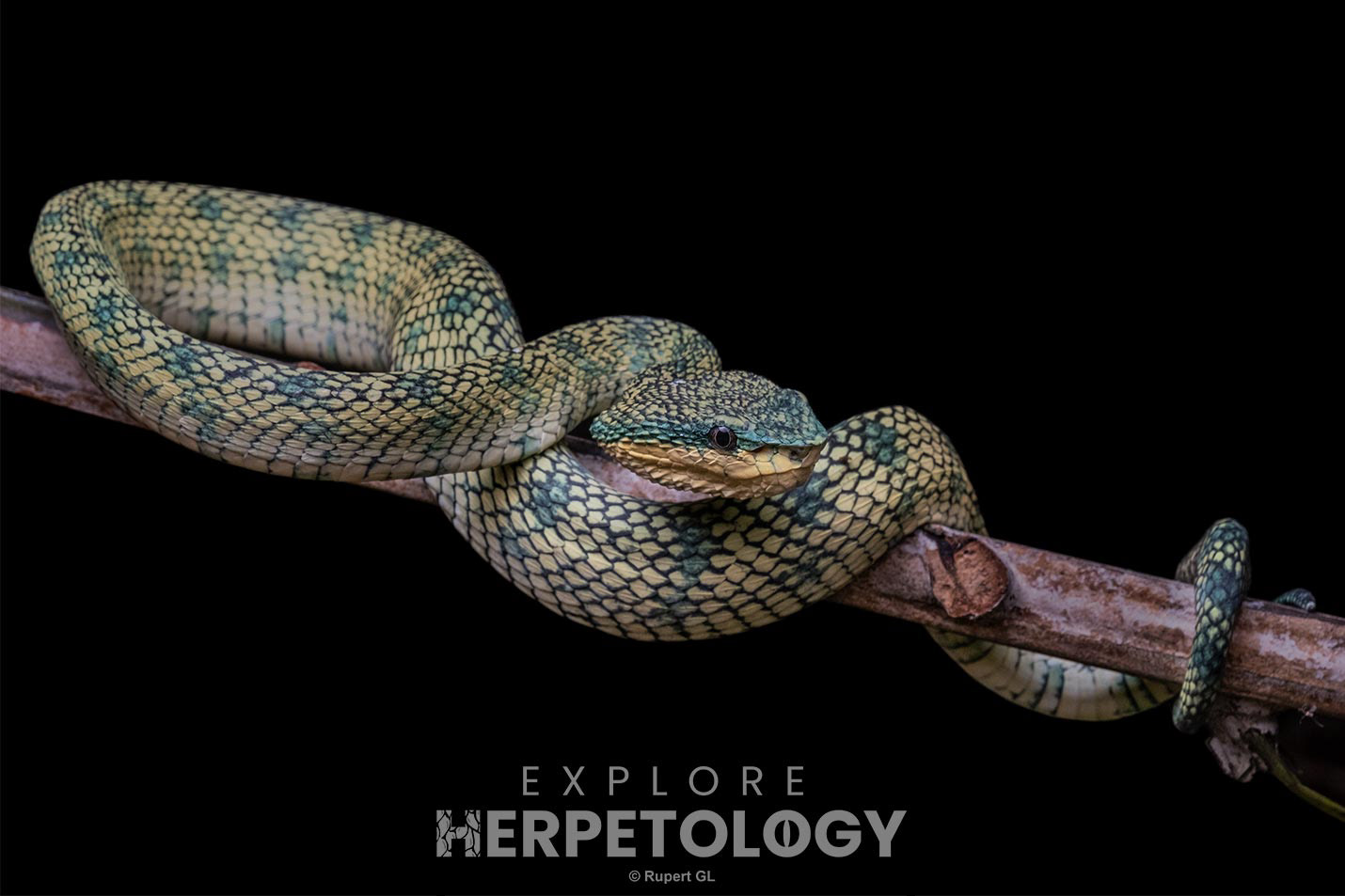
Subadult female Sulu clade Tropidolaemus cf. subannulatus
The coconut trees, crystal clear seawater and smiling faces of Tawi-Tawi will forever remain as one of the most incredible places I have ever visited for herping, and Western Mindanao as a whole was a truly remarkable experience for us. Going far off the beaten track and into areas where most people have never stepped foot is something we must aspire to do more often, and exploring Western Mindanao feels like our early days pioneering herping in Thailand’s Deep South. We will surely return in the near future, especially for that elusive Zamboanga clade Trimeresurus cf. flavomaculatus.
I cannot thank Shams, Abs, Moukz, Das and their friends enough for their incredible generosity extended to us in Tawi-Tawi. Without them, none of this would have been possible and we are beyond grateful for their kindness and company. I would also like to thank Leroy and Tom from Pasonanca Natural Park for their assistance arranging us entry to the protected area. Of course, I must also credit my companions Alex Ericson Lee and Keith Weller, who possessed the mental and physical resilience necessary for an expedition of this magnitude.


